UBS Axcera LU1000ATD 1000-Watt UHF Digital Transmitter User Manual TITLE PAGE
UBS-Axcera 1000-Watt UHF Digital Transmitter TITLE PAGE
Contents
- 1. Compiled DM8 Users Manual
- 2. Compiled Exciter Users Manual
- 3. Compiled External Amplifier Manual
Compiled Exciter Users Manual

Instruction Manual
Innovator,
LX Series
Digital UHF
Driver/Transmitter
AXCERA, LLC
103 FREEDOM DRIVE, P.O. Box 525 LAWRENCE, PA 15055-0525 USA
(724) 873-8100 • FAX (724) 873-8105
www.axcera.com • info@axcera.com

Digital UHF Driver/Transmitter Table of Contents
LX Series, Rev. 1 April 29, 2008
i
TABLE OF CONTENTS
CHAPTER 1: INTRODUCTION
SECTION PAGE
1.1: Manual Overview..................................................................................1-1
1.2: Assembly Designation Numbers.............................................................1-1
1.3: Safety.................................................................................................1-2
1.4: Contact Information ........................................................................ 1-2
1.5: Material Return Procedure.....................................................................1-2
1.6: Limited One Year Warranty for Axcera Products.......................................1-3
CHAPTER 2: SYSTEM DESCRIPTION & REMOTE CONTROL CONNECTIONS
2.0: System Overview................................................................................2-1
2.1: Exciter Amplifier Chassis Assembly ........................................................2-1
2.1.1: IF Processor Module ....................................................................2-2
2.1.2: LO/Upconverter Module...............................................................2-4
2.1.3: Control & Monitoring/Power Supply Module....................................2-6
2.1.4: Driver Amplifier Module ...............................................................2-7
2.2: RF Output Assemblies...........................................................................2-9
2.3: Control and Status ...............................................................................2-9
2.3.1: Front Panel LCD Display Screen....................................................2-9
2.4: System Operation ................................................................................2-9
2.4.1: Principles of Operation.................................................................2-9
2.5: Maintenance......................................................................................2-11
2.6: Customer Remote Connections...................................................... 2-11
CHAPTER 3: SITE CONSIDERATIONS, INSTALLATION AND SETUP PROCEDURES
3.1: Site Considerations...............................................................................3-1
3.2: Unpacking the Chassis w/Modules..........................................................3-5
3.3: Installing the Chassis w/Modules ...........................................................3-5
3.4: AC Input .............................................................................................3-7
3.5: Setup and Operation ............................................................................3-7
3.5.1: Input Connections.......................................................................3-7
3.5.2: Initial Turn On ............................................................................3-9
3.5.2.1: DM8-R Digital Modulator Tray LEDs on Front Panel................3-9
3.5.2.2: IF Processor Module LEDs on Front Panel..............................3-9
3.5.2.3: LO/Upconverter Module LEDs on Front Panel.........................3-9
3.5.2.4: Controller Module LEDs on Front Panel.................................3-9
3.5.2.5: Driver Module LEDs on Front Panel ......................................3-9
3.5.3: Front Panel Screens for the Driver/Amplifier Chassis Assembly ......3-10
3.5.4: Operational Procedure...............................................................3-17
CHAPTER 4: CIRCUIT DESCRIPTIONS
4.1: IF Processor Module .............................................................................4-1
4.1.1: IF Processor Board......................................................................4-1
4.1.1.1: DM8 Modulator Selected.....................................................4-1
4.1.1.2: External Modulated IF Selected ...........................................4-1
4.1.1.3: Main IF Signal Path (Part 1 of 3)..........................................4-1
4.1.1.4: Input Level Detector Circuit ................................................4-2
4.1.1.5: Pin Diode Attenuator Circuit................................................4-3
4.1.1.6: Main IF Signal Path (Part 2 of 3)..........................................4-3

Digital UHF Driver/Transmitter Table of Contents
LX Series, Rev. 1 April 29, 2008
ii
TABLE OF CONTENTS - (Continued)
SECTION PAGE
4.1.1.7: Amplitude and Phase Pre Correction Circuits.........................4-4
4.1.1.8: Main IF Signal Path (Part 3 of 3)..........................................4-5
4.1.1.9: ALC Circuit........................................................................4-5
4.1.1.10: Fault Command ...............................................................4-6
4.1.1.11: ±12 VDC Needed to Operate the Board..............................4-6
4.2: LO/Upconverter Module ........................................................................4-6
4.2.1: UHF Generator Board ..................................................................4-7
4.2.2: UHF Filters .................................................................................4-8
4.2.3: LO/Upconverter Board.................................................................4-8
4.2.3.1: Upconverter portion of the Board.........................................4-8
4.2.3.2: Automatic Gain portion of the Board ....................................4-9
4.2.3.3: The PLL and 10MHz Reference portion of the Board.............4-10
4.2.3.4: External 10MHz PLL and 10MHz Reference present Circuitry.4-10
4.2.3.5: Internal 10MHz Reference Circuitry....................................4-11
4.2.3.6: Selected 10MHz Reference Samples...................................4-11
4.2.3.7: Comparator Phase Lock Loop Circuit ..................................4-11
4.2.3.8: Lock Detector Circuit........................................................4-11
4.2.3.9: Voltage Requirements ......................................................4-12
4.3: Control Monitoring/Power Supply Module..............................................4-12
4.3.1: Power Protection Board..............................................................4-12
4.3.2: Control Board ...........................................................................4-13
4.3.2.1: Schematic Page 1 ............................................................4-13
4.3.2.2: Schematic Page 2 ............................................................4-14
4.3.2.3: Schematic Page 3 ............................................................4-14
4.3.2.4: Schematic Page 4 ............................................................4-15
4.3.2.5: Schematic Page 5 ............................................................4-15
4.3.3: Switch Board............................................................................4-16
4.3.4: Switching Power Supply Assembly ..............................................4-16
4.4: Driver Amplifier Module Assembly........................................................4-16
4.4.1: 1-Watt Amplifier Module Assembly..............................................4-17
4.4.2: 1-Watt UHF Amplifier Board .......................................................4-17
4.4.3: RF Amplifier Assembly...............................................................4-18
4.4.4: Coupler Board Assembly............................................................4-18
4.4.5: Amplifier Control Board..............................................................4-18
4.4.5.1: Schematic Page 1 ............................................................4-18
4.4.5.2: Schematic Page 2 ............................................................4-19
4.4.5.3: Schematic Page 3 ............................................................4-20
4.5: Dual Peak Detector Board ...................................................................4-21
CHAPTER 5: DETAILED ALIGNMENT PROCEDURES
5.1: System Preparation..............................................................................5-1
5.1.1: Module Replacement ...................................................................5-1
5.1.2: Initial Test Set Up .......................................................................5-1
5.2: LX Series Driver/Amplifier Chassis Assembly...........................................5-1
5.2.1: IF Processor Module Assembly......................................................5-2
5.3: Setting ALC Gain, AGC1, AGC2 and AGC Cutback ....................................5-2
5.4: Calibration of Output & Reflected Power .................................................5-3
5.4.1 Calibration of Forward Power.........................................................5-3
5.4.2 Calibration of Reflected Power .......................................................5-3

Digital UHF Driver/Transmitter Table of Contents
LX Series, Rev. 1 April 29, 2008
iii
TABLE OF CONTENTS - (Continued)
SECTION PAGE
5.5: Linearity Correction Adjustment.............................................................5-4
5.6: Frequency Response Delay Equalization Adjustment ................................5-5
APPENDICES
APPENDIX A: TRANSMITTER SPECIFICATIONS
APPENDIX B: DRAWINGS LISTS
APPENDIX B: TRANSMITTER LOG SHEET

Digital UHF Driver/Transmitter Table of Contents
LX Series, Rev. 1
iv
LIST OF FIGURES
FIGURE PAGE
1-1: Brady Marker Identification Drawing.................................................1-1
2-1: Digital LX Series Front View Modules and Assemblies .........................2-1
2-2: Rear View LX Series Driver/Amplifier Chassis Assembly....................2-11
3-1: 500 Watt Minimum Ventilation Configuration.....................................3-4
3-2: Tray Slide Cabinet Mounting Diagram...............................................3-6
3-3: Front and Rear View Reconnection Drawing.......................................3-6
3-4: Cabinet Front and Rear View Reconnection Drawing...........................3-6
3-5: AC Input Box Assembly...................................................................3-7
3-6: Rear View of Driver/Amplifier...........................................................3-8
4-1: 250 Watt UHF Amplifier Module .....................................................4-17
5-1: Typical Digital Spectrum .................................................................5-5

Digital UHF Driver/Transmitter Table of Contents
LX Series, Rev. 1
v
LIST OF TABLES
TABLE PAGE
2-1: Digital LX Series Modules and Assemblies .........................................2-1
2-2: IF Processor Front Panel Switch .......................................................2-3
2-3: IF Processor Front Panel Status Indicators ........................................2-3
2-4: IF Processor Front Panel Control Adjustments....................................2-3
2-5: IF Processor Front Panel Sample......................................................2-3
2-6: LO/Upconverter Front Panel Switch ..................................................2-5
2-7: LO/Upconverter Front Panel Status Indicators ...................................2-5
2-8: LO/Upconverter Front Panel Control Adjustments...............................2-5
2-9: LO/Upconverter Front Panel Samples................................................2-5
2-10: Controller/Power Supply Front Panel Display .....................................2-6
2-11: Controller/Power Supply Front Panel Status Indicators .......................2-6
2-12: Controller/Power Supply Front Panel Control Adjustments...................2-6
2-13: Driver Amplifier Front Panel Status Indicators....................................2-8
2-14: Driver Amplifier Front Panel Control Adjustments...............................2-8
2-15: Driver Amplifier Front Panel Sample.................................................2-8
2-16: LX Series Exciter Driver Customer Remote Connections.......... 2-12
3-1: LX Series Digital Transmitters AC Input and Current Requirements......3-1
3-2: Rear Chassis Connections for LX Series Digital Exciter/Driver..............3-8
Digital Driver/Amplifier System Controller Screens
3-3: Menu 01 Splash Screen #1............................................................3-10
3-4: Menu 02 Splash Screen #2............................................................3-10
3-5: Menu 10 Main Screen ...................................................................3-10
3-6: Menu 11 Error List Access Screen...................................................3-11
3-7: Menu 12 Transmitter Device Data Access Screen.............................3-11
3-8: Menu 13 Transmitter Configuration Access Screen...........................3-11
3-9: Menu 20 Error List Display Screen..................................................3-12
3-10: Menu 30 Transmitter Device Details Screen..................................3-12
3-11: Menu 30-1 System Details Screens..............................................3-12
3-12: Transmitter Device Parameters Detail Screens..............................3-13
3-13: Menu 40 Authorized Personnel Screen .........................................3-14
3-14: Menu 40-1 Transmitter Set Up: Power Control Screen ...................3-14
3-15: Menu 40-2 Transmitter Set Up: Model Select Screen .....................3-15
3-16: Menu 40-3 Transmitter Set Up: Upconverter Channel Select Screen 3-15
3-17: Menu 40-4 Transmitter Set Up: Serial Address Screen ...................3-15
3-18: Menu 40-6 Transmitter Set Up: System Forward Power Cal. Screen.3-15
3-19: Menu 40-6 Transmitter Set Up: System Reflected Power Cal. Screen.3-16
3-20: Menu 40-7 Transmitter Set Up: Fwrd Pwr Fault Threshold Screen......3-16
3-21: Menu 40-8 Transmitter Set Up: Refl Power Fault Threshold Screen....3-16
3-22: Menu 40-10 Transmitter Set Up: Auto Standby Control Screen .........3-16
3-23: Menu 40-12 Transmitter Set Up: Inner Loop Gain Control Screen......3-17
3-24: Menu 40-13 Transmitter Set Up: Optional System Control Screen .....3-17
3-25: Menu 40-19 Transmitter Set Up: Amplifier Output Power Warning.....3-17
3-26: Menu 40-19 Transmitter Set Up: Remote Commands Control............3-17
4-1: Firmware Configuration Switch SW2 Operating Positions ..................4-15
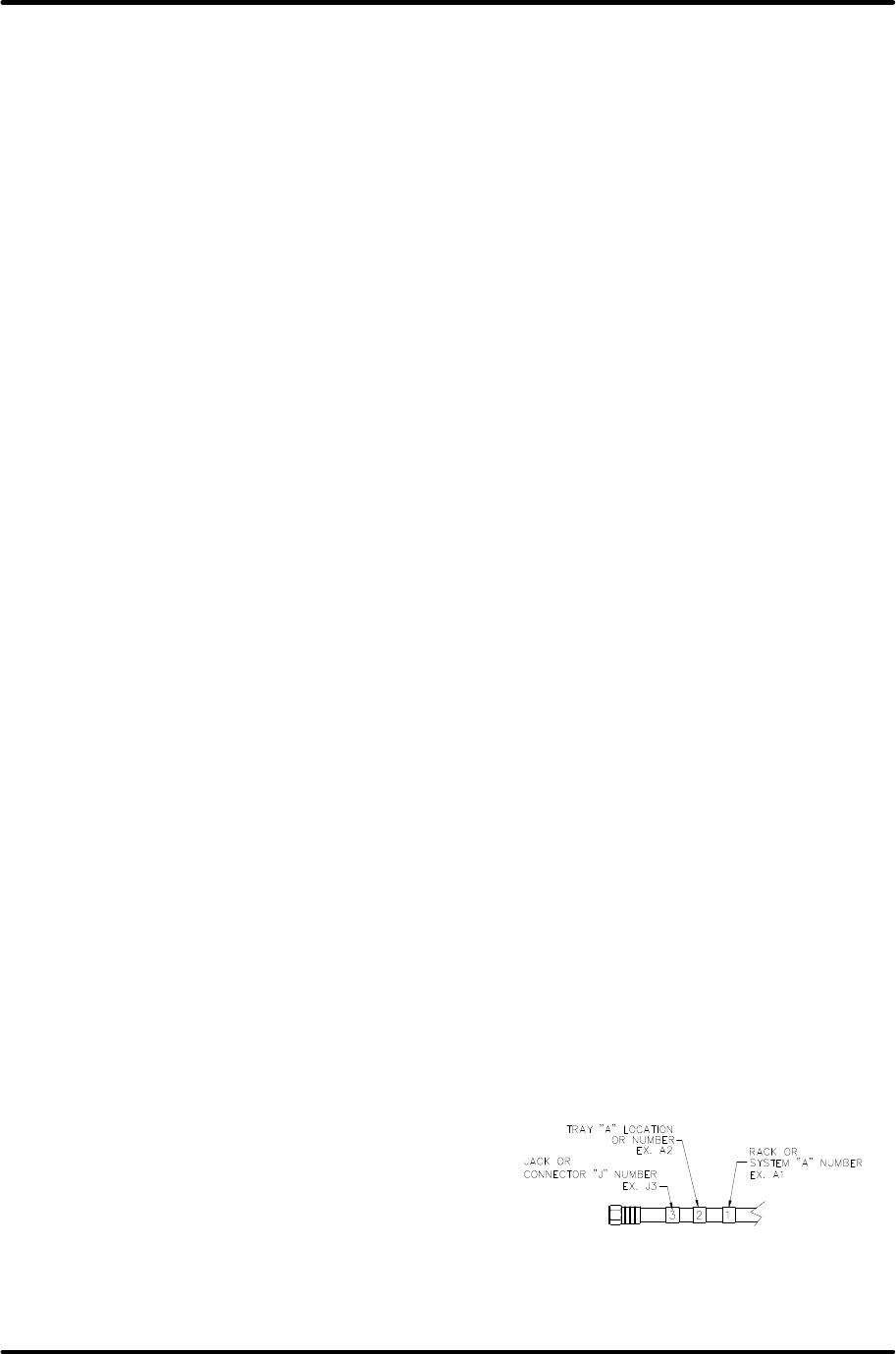
Digital UHF Driver/Transmitter Chapter 1, Introduction
LX Series, Rev. 1 1-1
Chapter 1:
Introduction
1.1: Manual Overview
This manual explains the installation,
setup, alignment, and maintenance
procedures for the LX Series modular
Digital UHF driver/transmitter. If your
transmitter contains external power
amplifier assemblies, then information
and drawings on the external amplifier
assemblies are contained in Volume 2.
This instruction manual is divided into
five chapters and supporting appendices.
Chapter 1: Introduction, contains
information on the assembly numbering
system used in the manual, safety,
maintenance, return procedures, and
warranties. Chapter 2: System
Description, maintenance and remote
control connections, describes the
transmitter and includes discussions on
system control and status indicators,
maintenance and remote control
connections. Chapter 3: Site
Considerations, installation and setup
procedures, explains how to unpack,
install, setup, and operate the
transmitter. Chapter 4: Circuit
Descriptions, contains circuit-level
descriptions for boards and board-level
components in the transmitter. Chapter
5: Detailed Alignment Procedures,
provides information on adjusting the
system assemblies for optimal operation.
Appendix A: contains drawings and
parts lists. Appendix B: contains a
transmitter log sheet
1.2: Assembly Designators
Axcera has assigned assembly numbers,
Ax designations such as A1, where
x=1,2,3…etc, to all assemblies, modules,
and boards in the system. These
designations are referenced in the text of
this manual and shown on the block
diagrams and interconnect drawings
provided in the appendices. The Block
Diagrams, Interconnects, Schematics,
Assembly Drawings and Parts Lists are
arranged in increasing numerical order in
the appendices. Section titles in the text
for assembly or module descriptions or
alignment procedures contain the
associated part number(s) and the
relevant appendix that contains the
drawings for that item.
The cables that connect between the
boards within a tray or assembly and
that connect between the trays, racks
and cabinets are labeled using Brady
markers. Figure 1-1 is an example of a
Brady marked cable. There may be as
few as two or as many as four Markers
on any one cable. These Brady markers
are read starting furthest from the
connector. If there are four Brady
Markers, this marker is the transmitter
number such as transmitter 1 or
transmitter 2. The next or the furthest
Brady Marker is the rack or cabinet
number on an interconnect cable or the
board number within a tray. The next
number on an interconnect cable is the
Tray location or number. The Brady
marker closest to the connector is the
jack or connector number on an
interconnect cable or the jack or
connector number on the board within a
tray.
Figure 1-1: Brady Marker Identification
Drawing

Digital UHF Driver/Transmitter Chapter 1, Introduction
LX Series, Rev. 1 1-2
1.3: Safety
The UHF transmitter systems
manufactured by Axcera are designed to
be easy to use and repair while providing
protection from electrical and mechanical
hazards. Please review the following
warnings and familiarize yourself with the
operation and servicing procedures
before working on the transmitter
system.
Read All safety Instructions – All of
the safety instructions should be read
and understood before operating this
equipment.
Retain Manuals – The manuals for the
transmitter should be retained at the
transmitter site for future reference.
Axcera provides two sets of manuals for
this purpose; one set can be left at the
office while one set can be kept at the
site.
Heed all Notes, Warnings, and
Cautions – All of the notes, warnings,
and cautions listed in this safety section
and throughout the manual must be
followed.
Follow Operating Instructions – All of
the operating and use instructions for the
transmitter should be followed.
Cleaning – Unplug or otherwise
disconnect all power from the equipment
before cleaning. Do not use liquid or
aerosol cleaners. Use a damp cloth for
cleaning.
Ventilation – Openings in the cabinet
and module front panels are provided for
ventilation. To ensure the reliable
operation of the driver/transmitter, and
to protect the unit from overheating,
these openings must not be blocked.
Servicing – Do not attempt to service
this product yourself until becoming
familiar with the equipment. If in doubt,
refer all servicing questions to qualified
Axcera service personnel.
Replacement Parts – When
replacement parts are used, be sure that
the parts have the same functional and
performance characteristics as the
original part. Unauthorized substitutions
may result in fire, electric shock, or other
hazards. Please contact the Axcera
Technical Service Department if you have
any questions regarding service or
replacement parts.
1.4: Contact Information
The Axcera Field Service Department can
be contacted by phone at (724) 873-
8100 or by fax at (724) 873-8105.
Before calling Axcera, please be prepared
to supply the Axcera technician with
answers to the following questions. This
will save time and help ensure the most
direct resolution to the problem.
1. What are the Customers’ Name
and call letters?
2. What are the model number and
type of transmitter?
3. Is the transmitter digital or
analog?
4. How long has the transmitter
been on the air? (Approximately
when was the transmitter
installed.)
5. What are the symptoms being
exhibited by the transmitter?
Include the current control/power
supply LCD readings and the
status of LEDs on the front
panels of the modules. If
possible, include the
control/power supply LCD
readings before the problem
occurred.
1.5: Return Material Procedure
To insure the efficient handling of
equipment or components that have been
returned for repair, Axcera requests that
each returned item be accompanied by a
Return Material Authorization Number
(RMA#).

Digital UHF Driver/Transmitter Chapter 1, Introduction
LX Series, Rev. 1 1-3
The RMA# can be obtained from any
Axcera Field Service Engineer by
contacting the Axcera Field Service
Department at (724) 873-8100 or by fax
at (724) 873-8105. This procedure
applies to all items sent to the Field
Service Department regardless of
whether the item was originally
manufactured by Axcera.
When equipment is sent to the field on
loan, an RMA# is included with the unit.
The RMA# is intended to be used when
the unit is returned to Axcera. In
addition, all shipping material should be
retained for the return of the unit to
Axcera.
Replacement assemblies are also sent
with an RMA# to allow for the proper
routing of the exchanged hardware.
Failure to close out this type of RMA# will
normally result in the customer being
invoiced for the value of the loaner item
or the exchanged assembly.
When shipping an item to Axcera, please
include the RMA# on the packing list and
on the shipping container. The packing
slip should also include contact
information and a brief description of why
the unit is being returned.
Please forward all RMA items to:
AXCERA, LLC
103 Freedom Drive
P.O. Box 525
Lawrence, PA 15055-0525 USA
For more information concerning this
procedure, call the Axcera Field Service
Department @ (724) 873-8100.
Axcera can also be contacted through e-
mail at info@axcera.com and on the
Web at www.axcera.com.
1.6: Limited One Year Warranty for
Axcera Products
Axcera warrants each new product that
it has manufactured and sold against
defects in material and workmanship
under normal use and service for a
period of one (1) year from the date of
shipment from Axcera's plant, when
operated in accordance with Axcera's
operating instructions. This warranty
shall not apply to tubes, fuses,
batteries, bulbs or LEDs.
Warranties are valid only when and if
(a) Axcera receives prompt written
notice of breach within the period of
warranty, (b) the defective product is
properly packed and returned by the
buyer (transportation and insurance
prepaid), and (c) Axcera determines, in
its sole judgment, that the product is
defective and not subject to any misuse,
neglect, improper installation,
negligence, accident, or (unless
authorized in writing by Axcera) repair
or alteration. Axcera's exclusive liability
for any personal and/or property
damage (including direct, consequential,
or incidental) caused by the breach of
any or all warranties, shall be limited to
the following: (a) repairing or replacing
(in Axcera's sole discretion) any
defective parts free of charge (F.O.B.
Axcera’s plant) and/or (b) crediting (in
Axcera's sole discretion) all or a portion
of the purchase price to the buyer.
Equipment furnished by Axcera, but not
bearing its trade name, shall bear no
warranties other than the special hours-
of-use or other warranties extended by
or enforceable against the manufacturer
at the time of delivery to the buyer.
NO WARRANTIES, WHETHER
STATUTORY, EXPRESSED, OR
IMPLIED, AND NO WARRANTIES OF
MERCHANTABILITY, FITNESS FOR
ANY PARTICULAR PURPOSE, OR
FREEDOM FROM INFRINGEMENT,
OR THE LIKE, OTHER THAN AS
SPECIFIED IN PATENT LIABILITY
ARTICLES, AND IN THIS ARTICLE,
SHALL APPLY TO THE EQUIPMENT
FURNISHED HEREUNDER.

Digital UHF Driver/Transmitter Chapter 1, Introduction
LX Series, Rev. 1 1-4
F WARNING!!!
× HIGH VOLTAGE Ø
DO NOT ATTEMPT TO REPAIR OR TROUBLESHOOT THIS EQUIPMENT UNLESS
YOU ARE FAMILIAR WITH ITS OPERATION AND EXPERIENCED IN
SERVICING HIGH VOLTAGE EQUIPMENT. LETHAL VOLTAGES ARE PRESENT
WHEN POWER IS APPLIED TO THIS SYSTEM. IF POSSIBLE, TURN OFF
POWER BEFORE MAKING ADJUSTMENTS TO THE SYSTEM.
« RADIO FREQUENCY RADIATION HAZARD «
MICROWAVE, RF AMPLIFIERS AND TUBES GENERATE HAZARDOUS RF
RADIATION THAT CAN CAUSE SEVERE INJURY INCLUDING CATARACTS,
WHICH CAN RESULT IN BLINDNESS. SOME CARDIAC PACEMAKERS MAY BE
AFFECTED BY THE RF ENERGY EMITTED BY RF AND MICROWAVE
AMPLIFIERS. NEVER OPERATE THE TRANSMITTER SYSTEM WITHOUT A
PROPERLY MATCHED RF ENERGY ABSORBING LOAD ATTACHED. KEEP
PERSONNEL AWAY FROM OPEN WAVEGUIDES AND ANTENNAS. NEVER
LOOK INTO AN OPEN WAVEGUIDE OR ANTENNA. MONITOR ALL PARTS OF
THE RF SYSTEM FOR RADIATION LEAKAGE AT REGULAR INTERVALS.

Digital UHF Driver/Transmitter Chapter 1, Introduction
LX Series, Rev. 1 1-5
EMERGENCY FIRST AID INSTRUCTIONS
Personnel engaged in the installation, operation, or maintenance of this equipment are urged to become
familiar with the following rules both in theory and practice. It is the duty of all operating personnel to be
prepared to give adequate Emergency First Aid and thereby prevent avoidable loss of life.
RESCUE BREATHING
1. Find out if the person is
breathing.
You must find out if the person
has stopped breathing. If you
think he is not breathing, place
him flat on his back. Put your ear
close to his mouth and look at his
chest. If he is breathing you can
feel the air on your cheek. You
can see his chest move up and
down. If you do not feel the air
or see the chest move, he is not
breathing.
2. If he is not breathing, open
the airway by tilting his head
backwards.
Lift up his neck with one hand
and push down on his forehead
with the other. This opens the
airway. Sometimes doing this will
let the person breathe again by
himself.
3. If he is still not breathing,
begin rescue breathing.
-Keep his head tilted backward.
Pinch nose shut.
-Put your mouth tightly over his
mouth.
-Blow into his mouth once every
five seconds
-DO NOT STOP rescue breathing
until help arrives.
LOOSEN CLOTHING - KEEP
WARM
Do this when the victim is
breathing by himself or help is
available. Keep him as quiet as
possible and from becoming
chilled. Otherwise treat him for
shock.
BURNS
SKIN REDDENED: Apply ice cold water to burned
area to prevent burn from going deeper into skin
tissue. Cover area with a clean sheet or cloth to
keep away air. Consult a physician.
SKIN BLISTERED OR FLESH CHARRED: Apply
ice cold water to burned area to prevent burn from
going deeper into skin tissue.
Cover area with clean sheet or cloth to keep away
air. Treat victim for shock and take to hospital.
EXTENSIVE BURN - SKIN BROKEN: Cover area
with clean sheet or cloth to keep away air. Treat
victim for shock and take to hospital.
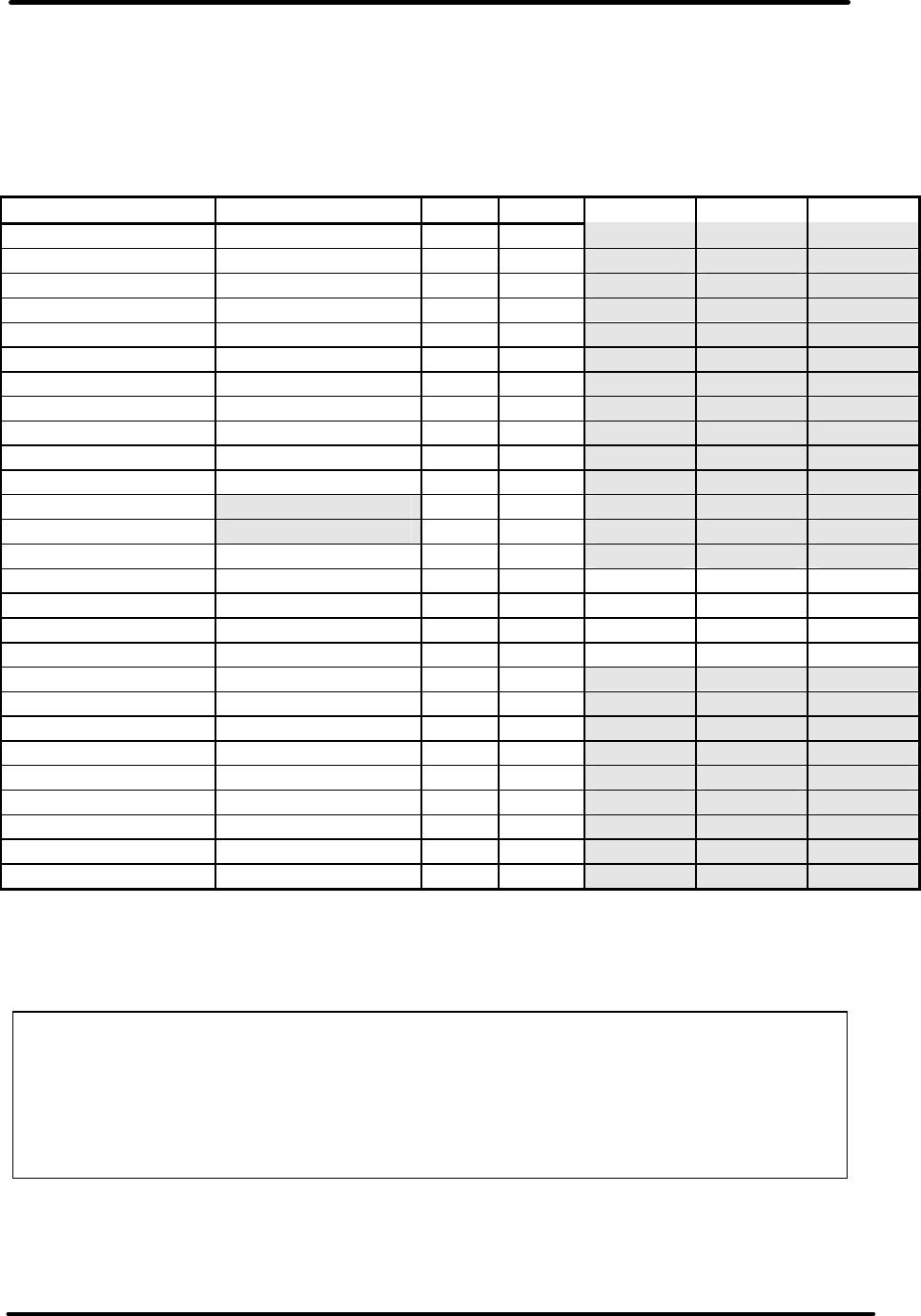
Digital UHF Driver/Transmitter Chapter 1, Introduction
LX Series, Rev. 1 1-6
dBm, dBw, dBmV, dBµV, & VOLTAGE
EXPRESSED IN WATTS
50 Ohm System
WATTS PREFIX dBm dBw dBmV dBµV VOLTAGE
1,000,000,000,000 1 TERAWATT +150
+120
100,000,000,000 100 GIGAWATTS +140
+110
10,000,000,000 10 GIGAWATTS +130
+100
1,000,000,000 1 GIGAWATT +120
+ 99
100,000,000 100 MEGAWATTS +110
+ 80
10,000,000 10 MEGAWATTS +100
+ 70
1,000,000 1 MEGAWATT + 90 + 60
100,000
100 KILOWATTS + 80 + 50
10,000 10 KILOWATTS + 70 + 40
1,000 1 KILOWATT + 60 + 30
100 1 HECTROWATT + 50 + 20
50 + 47 + 17
20 + 43 + 13
10 1 DECAWATT + 40 + 10
1 1 WATT + 30 0 + 77 +137 7.07V
0.1 1 DECIWATT + 20 - 10 + 67 +127 2.24V
0.01 1 CENTIWATT + 10 - 20 + 57 +117 0.707V
0.001 1 MILLIWATT 0 - 30 + 47 +107 224mV
0.0001 100 MICROWATTS - 10 - 40
0.00001
10 MICROWATTS - 20 - 50
0.000001 1 MICROWATT - 30 - 60
0.0000001 100 NANOWATTS - 40 - 70
0.00000001 10 NANOWATTS - 50 - 80
0.000000001 1 NANOWATT - 60 - 90
0.0000000001 100 PICOWATTS - 70 -100
0.00000000001 10 PICOWATTS - 80 -110
0.000000000001 1 PICOWATT - 90 -120
TEMPERATURE CONVERSION
°F = 32 + [(9/5) °C]
°C = [(5/9) (°F - 32)]

Digital UHF Driver/Transmitter Chapter 1, Introduction
LX Series, Rev. 1 1-7
USEFUL CONVERSION FACTORS
TO CONVERT FROM TO MULTIPLY BY
mile (US statute) kilometer (km) 1.609347
inch (in) millimeter (mm) 25.4
inch (in) centimeter (cm) 2.54
inch (in) meter (m) 0.0254
foot (ft) meter (m) 0.3048
yard (yd) meter (m) 0.9144
mile per hour (mph) kilometer per hour(km/hr) 1.60934
mile per hour (mph) meter per second (m/s) 0.44704
pound (lb) kilogram (kg) 0.4535924
gallon (gal) liter 3.7854118
U.S. liquid
(One U.S. gallon equals 0.8327 Canadian gallon)
fluid ounce (fl oz) milliliters (ml) 29.57353
British Thermal Unit watt (W) 0.2930711
per hour (Btu/hr)
horsepower (hp) watt (W) 746
NOMENCLATURE OF FREQUENCY BANDS
FREQUENCY RANGE DESIGNATION
3 to 30 kHz VLF - Very Low Frequency
30 to 300 kHz LF - Low Frequency
300 to 3000 kHz MF - Medium Frequency
3 to 30 MHz HF - High Frequency
30 to 300 MHz VHF - Very High Frequency
300 to 3000 MHz UHF - Ultrahigh Frequency
3 to 30 GHz SHF - Superhigh Frequency
30 to 300 GHz EHF - Extremely High Frequency
LETTER DESIGNATIONS FOR UPPER FREQUENCY
BANDS
LETTER FREQ. BAND
L 1000 - 2000 MHz
S 2000 - 4000 MHz
C 4000 - 8000 MHz
X 8000 - 12000 MHz
Ku 12 - 18 GHz
K 18 - 27 GHz
Ka 27 - 40 GHz
V 40 - 75 GHz
W 75 - 110 GHz
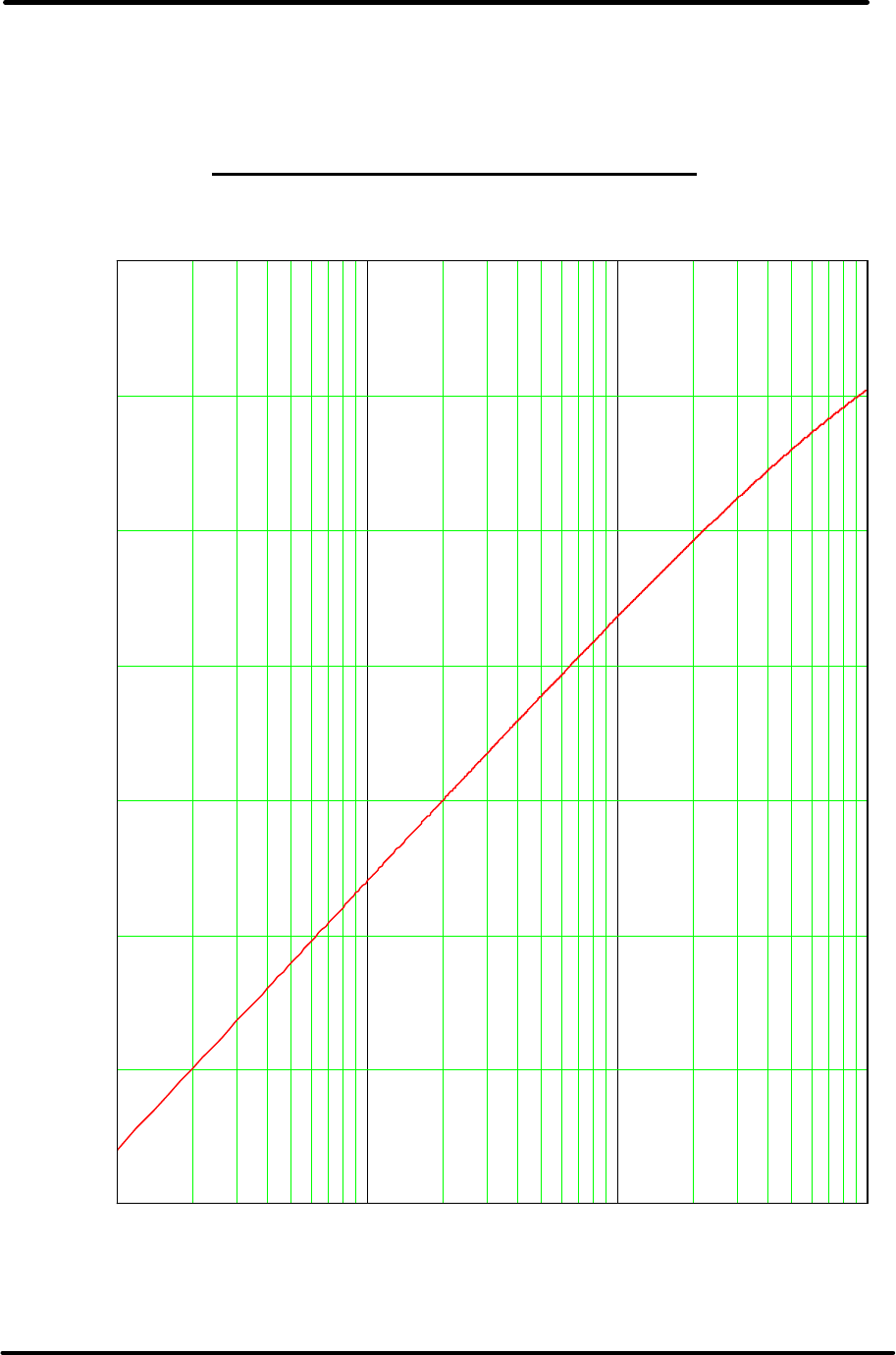
Digital UHF Driver/Transmitter Chapter 1, Introduction
LX Series, Rev. 1 1-8
RETURN LOSS VS. VSWR
1.001 1.01 1.1 2.0
VSWR
0
-
10
-
20
-
30
-
40
-
50
-
60
-
70
R
E
T
U
R
N
L
O
S
S
dB

Digital UHF Driver/Transmitter Chapter 1, Introduction
LX Series, Rev. 1 1-9
ABBREVIATIONS/ACRONYMS
AC Alternating Current
AFC Automatic Frequency Control
ALC Automatic Level Control
AM Amplitude modulation
AGC Automatic Gain Control
AWG American wire gauge
BER Bit Error Rate
BW Bandwidth
DC Direct Current
D/A Digital to analog
DSP Digital Signal Processing
DTV Digital Television
dB Decibel
dBm Decibel referenced to 1 milliwatt
dBmV Decibel referenced to 1 millivolt
dBw Decibel referenced to 1 watt
FEC Forward Error Correction
FM Frequency modulation
FPGA Field Programmable Gate Array
Hz Hertz
ICPM Incidental Carrier Phase Modulation
I/P Input
IF Intermediate Frequency
LED Light emitting diode
LSB Lower Sideband
MPEG Motion Pictures Expert Group
O/P Output
PLL Phase Locked Loop
PCB Printed circuit board
QAM Quadrature Amplitude Modulation
SMPTE Society of Motion Picture and
Television Engineers
VSB Vestigial Side Band
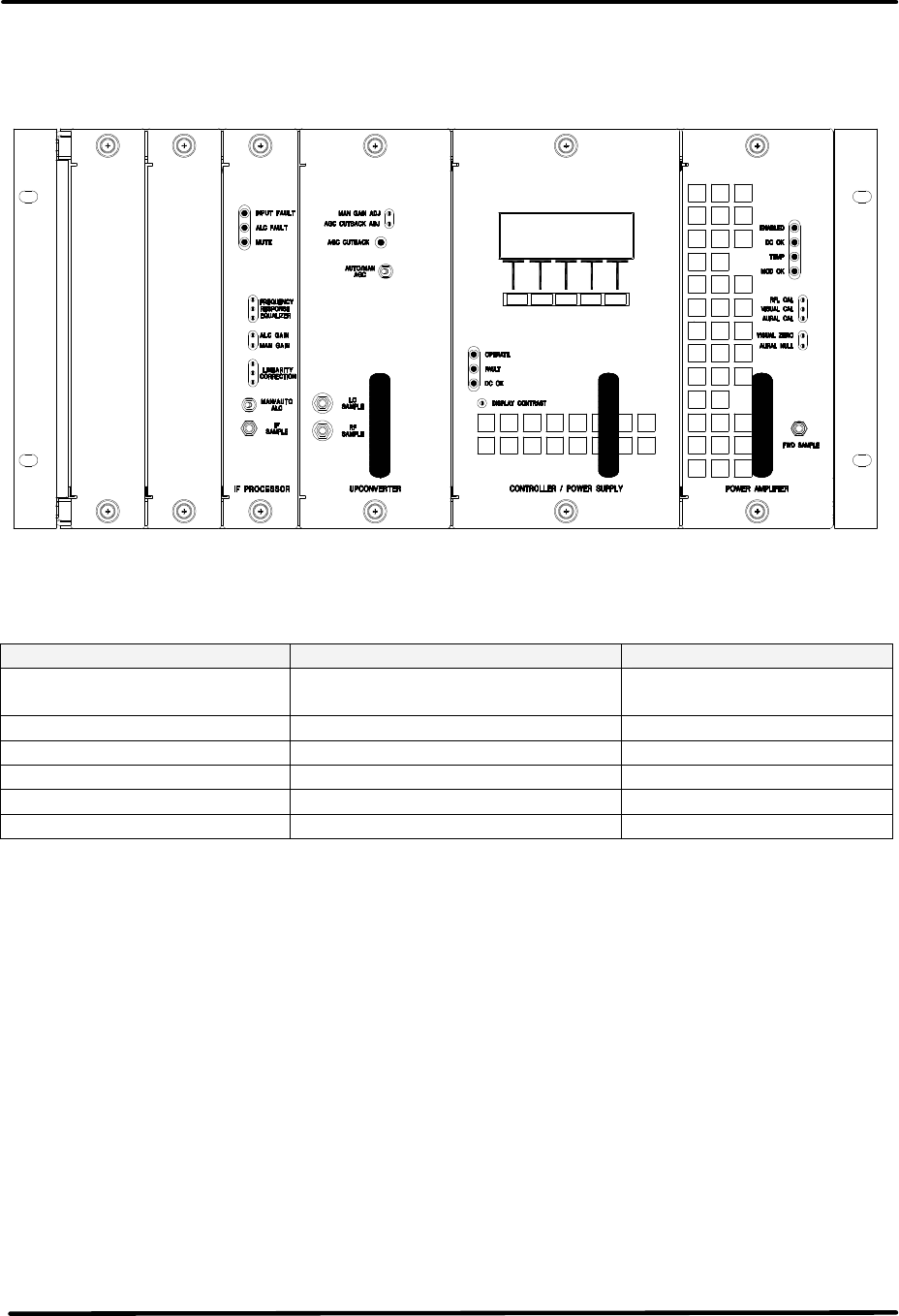
Digital UHF Driver/Transmitter Chapter 2, System Description,
Maintenance & Remote Control Connections
LX Series, Rev. 1 2-1
Chapter 2
System Description, Maintenance & Remote Control Connections
Figure 2-1: Driver/Amplifier Front View
Table 2-1: LX Series Modules and Assemblies
ASSEMBLY DESIGNATOR
TRAY/ASSEMBLY NAME PART NUMBER
Exciter Amplifier Chassis
Assembly, LX Series 1303228 (220 VAC)
Backplane Board 1301941
A3 IF Processor Module 1301938
A4 Control/Power Supply Module 1303229 (220 VAC)
A5 LO/Upconverter Module 1301930
A6 Driver Power Amplifier Module 1303874
2.0 System Overview
The digital transmitters in the Innovator
LX Series are complete UHF Digital
internally diplexed modular television
transmitters that operate at a nominal
DTV output power of 5 to 50 watts.
The LX Series can also be used as a
driver for external power amplifiers. The
output power of the driver is determined
by the level needed to attain the full
output power of the transmitter.
The Digital LX Series driver/transmitter is
made up of the modules and assemblies
as listed in Table 2-1.
2.1 Exciter Amplifier Chassis
Assembly, 220 VAC (1303228;
Appendix A)
The chassis assembly is factory set for
operation using 220 VAC. All of the
modules except the power amplifier
module and the power supply section of
the Control & Monitoring/Power Supply
Module, plug directly into a backplane
board. The backplane board provides
module to module interconnection as well
as interconnection to remote command
and control connectors.
A3
A5
A4
A6
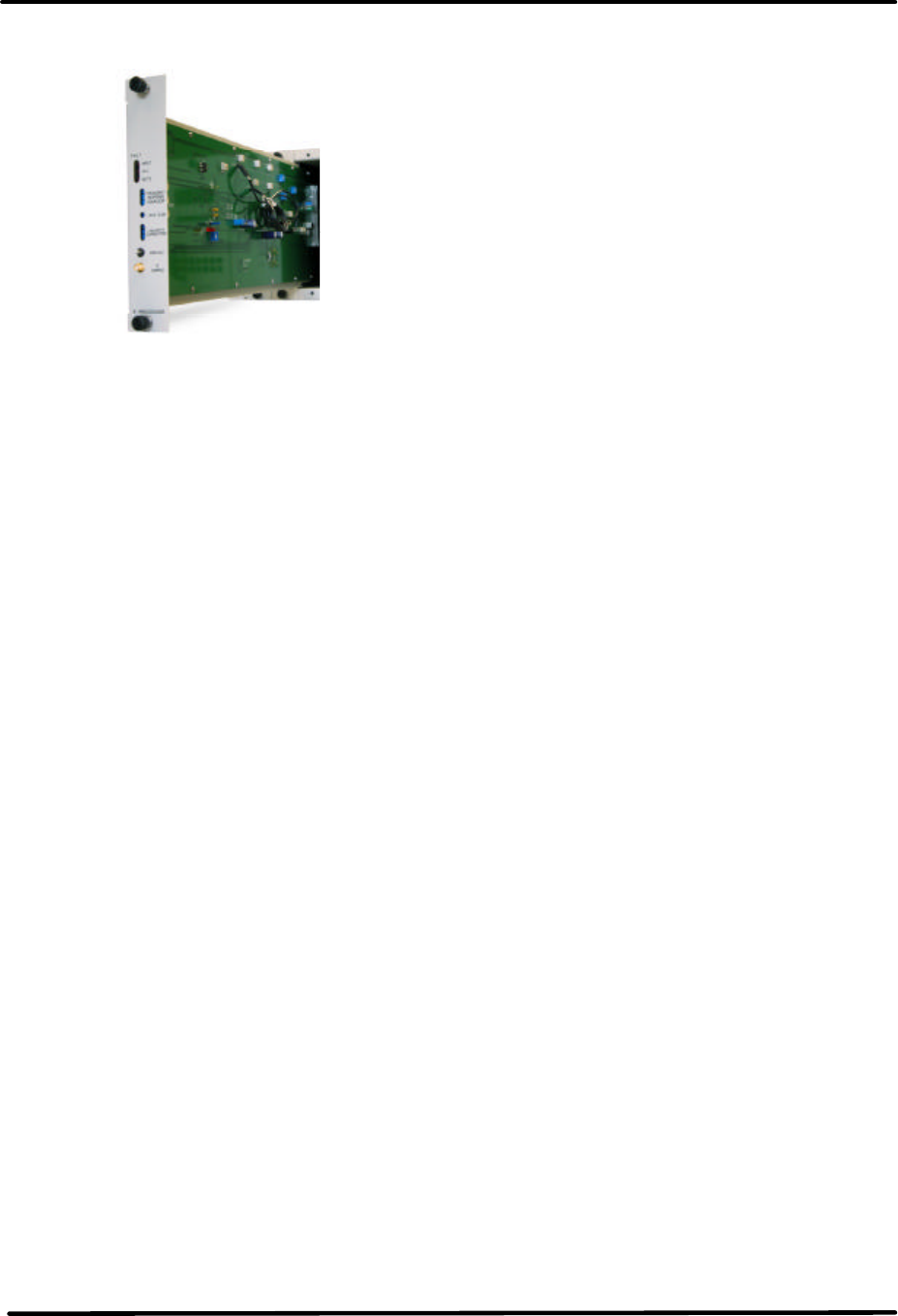
Digital UHF Driver/Transmitter Chapter 2, System Description,
Maintenance & Remote Control Connections
LX Series, Rev. 1 2-2
2.1.1 (A3) IF Processor Module
Assembly (1301938; Appendix A)
The (A3) IF Processor Assembly contains
the IF Processor Board (1301977). The IF
Processor provides pre-correction to
ensure broadcast quality output signal.
The pre-correction consists of amplitude
linearity correction, Incidental Carrier
Phase Modulation (ICPM) correction and
frequency response correction.
The IF Processor module is configured
either for an analog or digital system.
Pin 13C of the IF Processor module is
grounded in analog systems and left not
connected in digital systems. An IF
Processor Interlock signal is used to
report the presence of the IF Processor
module to the Control Monitoring board.
If the IF Processor interlock signal is not
present, the LX Series
Transmitter/Exciter Driver RF output is
Muted (turned off). If an analog IF
Processor module is installed and the
Modulation Present signal is not true,
the LX Series Transmitter/Exciter Driver
output is Muted (turned off).
The Control & Monitoring/Power Supply
module uses the IF Processor module for
System output power control. Through
the front panel display or a remote
interface, an operator can set the RF
output power level of the transmitter.
The range of RF power adjustment is
between 0% (full off) and 105% (full
power plus). A front panel IF Processor
module potentiometer sets the upper
limit of RF power at 120%. The
system's Control Monitoring board
compares the RF Power Monitoring
module RF power level with the desired
level and uses the IF Power Control PWM
line to correct for errors.
In digital systems, a digital level control
(DLC) voltage is generated on the IF
Processor module and sent to an
external digital modulator (DT1B/C). RF
power control is implemented by
changing the DLC voltage provided to
the external digital modulator. The 'RF
High' potentiometer sets the upper
adjusted range of RF control circuit
output to 120%.
The IF Processor module provides a
reference ALC voltage to the system's
Upconverter. When the ALC voltage
decreases, the Upconverter
automatically lowers the system output
power through the AGC circuits.
The IF Processor module has a front
panel switch to select Auto or Manual
ALC. When Manual ALC is selected, the
reference ALC voltage is set by a front
panel potentiometer. In this condition,
the RF power level control circuit is
removed from use. When the ALC select
switch is changed to Auto, the RF power
level control circuit will start at low
power and increase the RF output until
the desired output power is attained.
The IF Processor module Modulation
Present signal is monitored. If the
modulation level is too low or non-
existent, a Modulation Present Fault is
reported to the Control Monitoring
board. When the controller detects this
fault, it can be set to Automatically Mute
the transmitter or in Manual mode the
transmitter will continue to operate at
25% output.
The IF Processor module Input Signal
level is monitored. If the signal level is
too low or non-existent, an Input Fault
is reported on the Control Monitoring
board. When the IF Processor board
detects an Input Signal Fault it
automatically Mutes the transmitter.
The system controller does not Mute on
an IF Processor Input Fault.
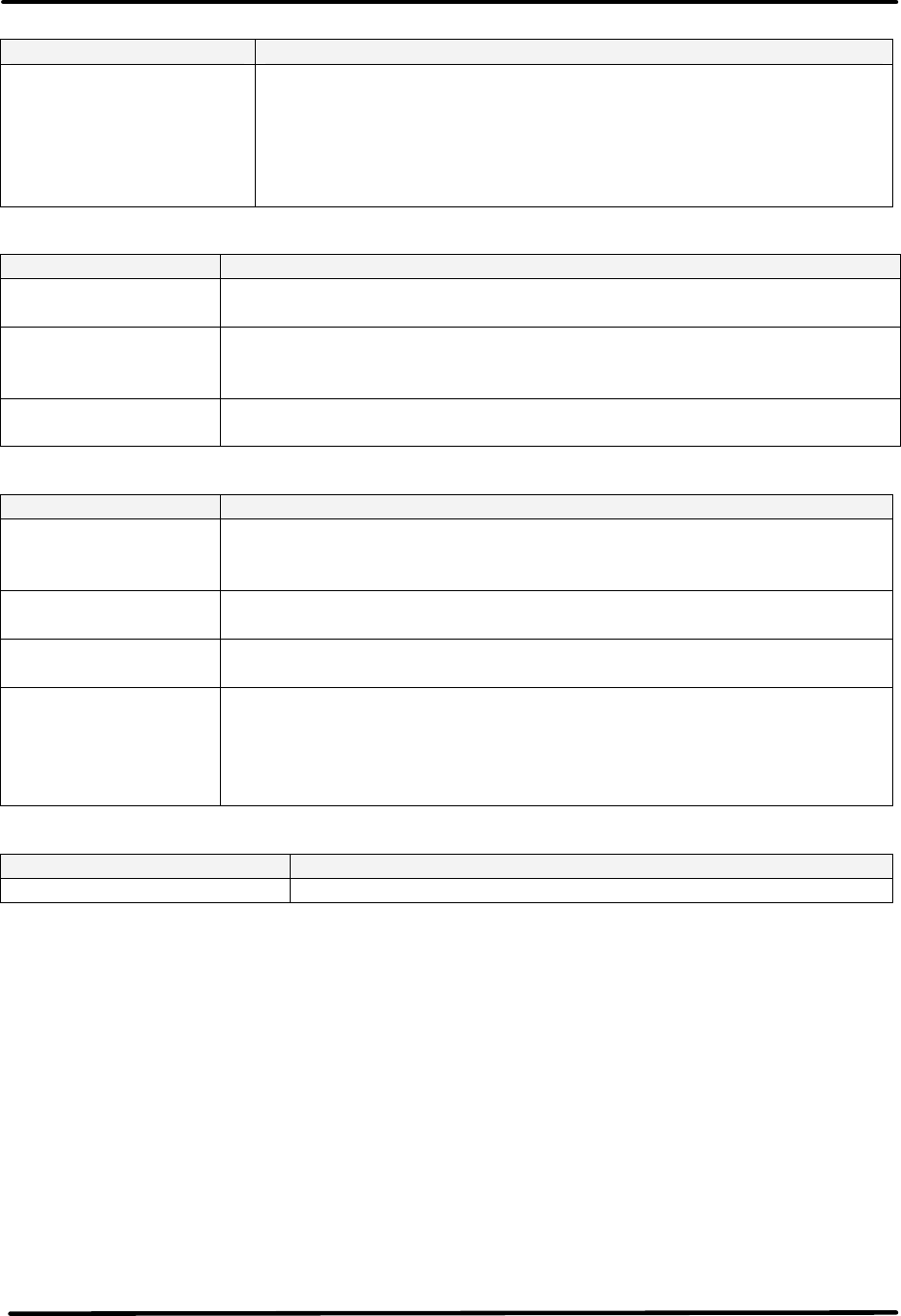
Digital UHF Driver/Transmitter Chapter 2, System Description,
Maintenance & Remote Control Connections
LX Series, Rev. 1 2-3
Table 2-2: IF Processor Front Panel Switch
SWITCH FUNCTION
MAN/AUTO ALC
When Manual ALC is selected, the reference ALC voltage is set
by the ALC Gain front panel potentiometer.
When Auto ALC is selected, the IF level control circuit will
automatically increase the IF output until the desired output
power is attained.
Table 2-3: IF Processor Front Panel Status Indicators
LED FUNCTION
INPUT FAULT (Red) When lit it indicates that there is a loss of the IF Input signal to the
IF Processor. Transmitter can be set to Mute on an IF Input Fault.
ALC Fault (Red) When lit it indicates that the required gain to produce the desired
output power level has exceeded the operational range of the ALC
circuit. The LED will also be lit when ALC is in Manual.
MUTE (Red) When lit it indicates that the IF input signal is cut back but the
enable to the Power Supply is present and the +32 VDC remains on.
Table 2-4: IF Processor Front Panel Control Adjustments
POTENTIOMETERS
DESCRIPTION
FREQUENCY
RESPONSE
EQUALIZER
These three variable resistors, R103, R106 & R274, adjust the
depth of gain for the three stages of frequency response correction.
ALC GAIN Adjusts the gain of the transmitter when the transmitter is in the
Auto ALC position.
MAN GAIN Adjusts the gain of the transmitter when the transmitter is in the
Manual ALC position.
LINEARITY
CORRECTION
These three variable resistors adjust the threshold cut in for the
three stages of linearity pre-correction. R211 and R216, the top
two pots, are adjusted to correct for in phase amplitude distortions.
R 231, the bottom pot, is adjusted to correct for quadrature phase
distortions.
Table 2-5: IF Processor Front Panel Sample
SMA CONNECTOR DESCRIPTION
IF SAMPLE Sample of the pre-corrected IF output of the IF Processor
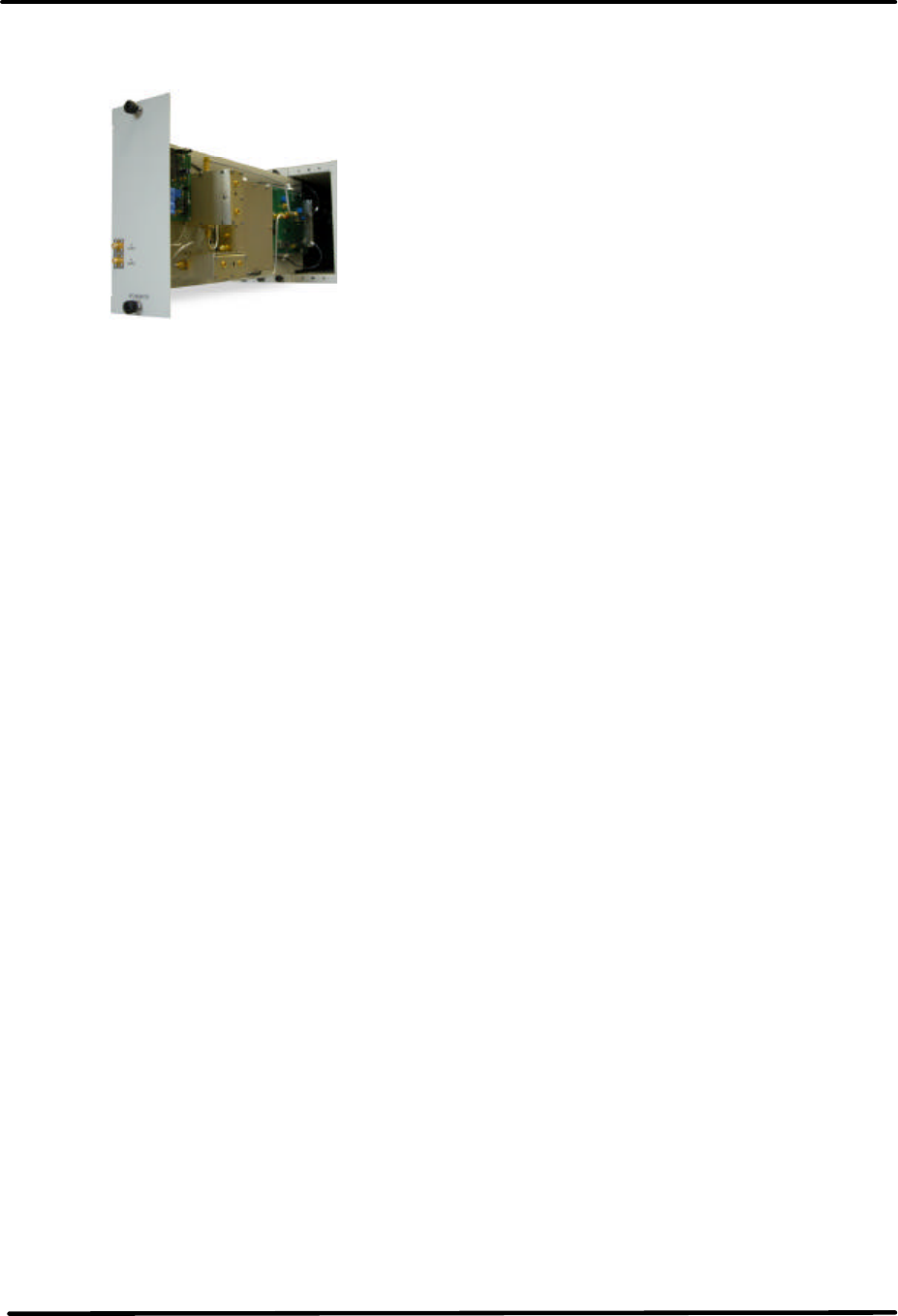
Digital UHF Driver/Transmitter Chapter 2, System Description,
Maintenance & Remote Control Connections
LX Series, Rev. 1 2-4
2.1.2 (A5) LO/Upconverter Module
Assembly (1301930; Appendix A)
The (A5) LO/Upconverter Module
Assembly contains a front panel LED
display board (1303033), a UHF Filter
(1007-1101), a UHF Generator Board
(1585-1265) and a LO/Upconverter
Assembly (1303039). The
LO/Upconverter Assembly contains the
LO/Upconverter Board (1302132).
The LX Series Upconverter converts an
IF input signal to a RF output signal on
the desired channel frequency using a
high stability oven controlled oscillator
with very low phase noise and an
Automatic Level Control (ALC) for stable
output signal level.
Several control voltages are used for
transmitter power control. Automatic
gain control (AGC) circuits set the RF
output level of the transmitter system.
AGC #1 is provided by the
Transmitter/Exciter Driver Power
Amplifier module. This voltage is used
by the Upconverter to maintain a
constant RF output level at the Power
Amplifier module output. If this voltage
exceeds 0.9 VDC, the system is in an
over-drive condition. The 0.9 VDC over-
driver threshold is set by a front panel
Upconverter module potentiometer.
When an over-drive condition is
detected, the Upconverter module
reduces it’s RF output level. For values
less than 0.9 VDC, the Upconverter uses
the AGC #1 voltage for automatic gain
control by setting it's RF output to
maintain AGC #1 equal to the AGC
voltage set by another front panel
potentiometer. When the Upconverter is
set for manual gain, the RF output of the
Upconverter is set by the front panel
AGC potentiometer. In manual gain
operation, the AGC #1 feedback voltage
from the PA is not used to adjust the RF
level unless an over-drive condition is
detected.
AGC #2 is provided by each of the
optional external amplifier modules.
Diodes are used in each of the external
amplifier forward power circuits to
capture the highest detected sample
voltage. This voltage is used by the
Upconverter to maintain a constant RF
output of the system. As with AGC #1,
the Upconverter module reduces its RF
output level if AGC #2 is too high. AGC
#1 and ACG #2 are diode ORed together
in the Upconverter gain circuit. Both
AGC voltages are first reduced by an on-
board potentiometer before being
amplified. If an over-drive condition
does not exist, the higher of the two
AGC voltages is used to control the
Upconverter gain circuit. An AFC Voltage
is generated to control the VCXO of the
UHF Generator portion of the
Upconverter module. The typical AFC
voltage is 0.5 VDC but it can be as high
as +1.5 VDC.
The Upconverter can operate using
either the internal 10 MHz source or a
10 MHz external reference signal. When
an external 10 MHz source is present on
J10, it is automatically selected. An
external reference present signal is
provided to the controller for display
purposes. The selected 10 MHz signal
from the Upconverter is buffered then
sent to the backplane on two ports. One
port is sent to the Modulator module, if
present, and the other is routed to a
BNC connector (J11) on the backplane
for a system 10 MHz output signal.
A National Semiconductor frequency
synthesizer IC is used in the frequency
conversion of the IF signal to a RF
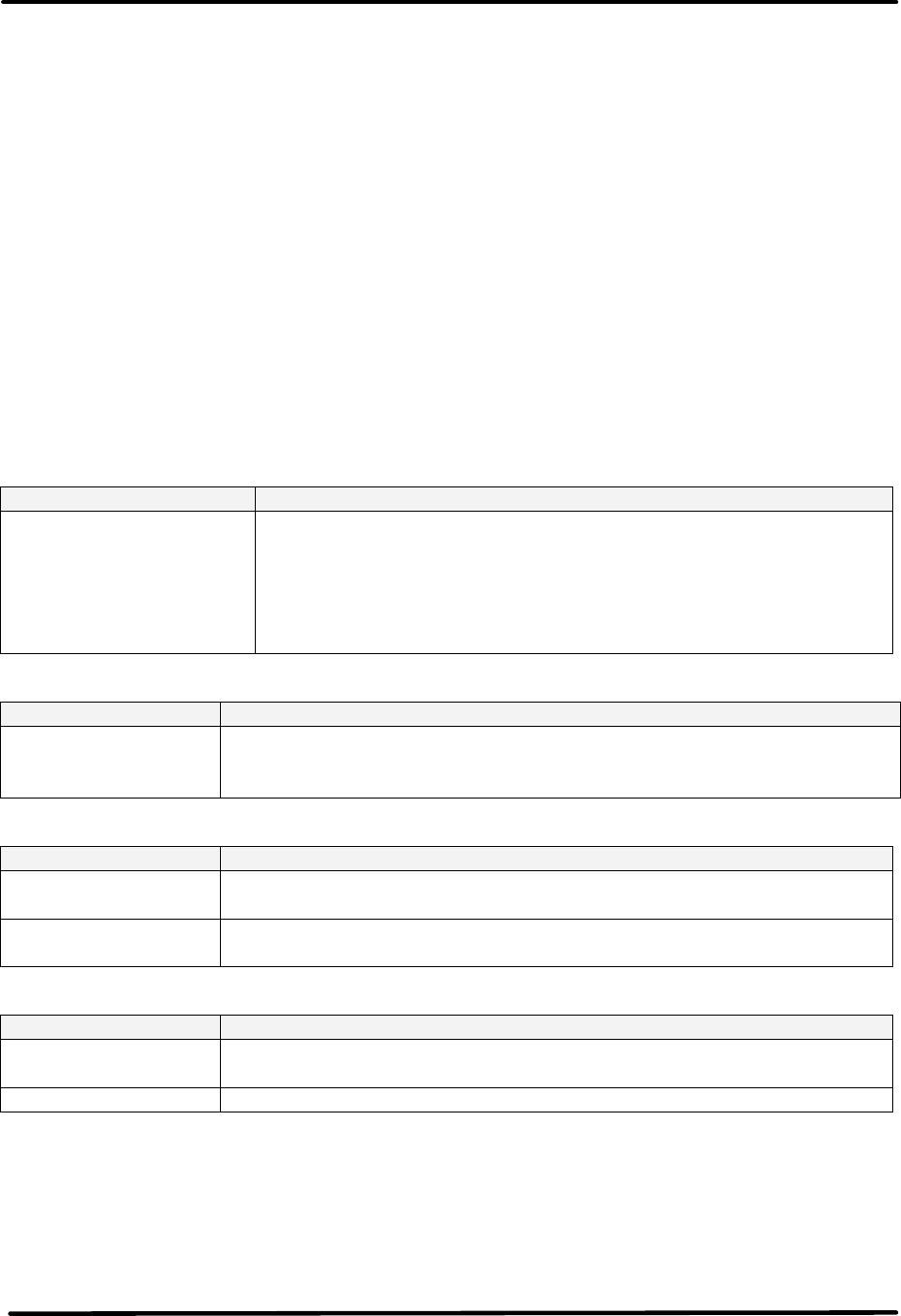
Digital UHF Driver/Transmitter Chapter 2, System Description,
Maintenance & Remote Control Connections
LX Series, Rev. 1 2-5
signal. The frequency synthesizer IC
uses a 10 MHz reference frequency for
signal conversion. Typically the IF input
is a 0 dBm @ 44 MHz to the upconverter
through the backplane board is applied
to a mixer mounted on the first
conversion board.44 MHz for digital
systems. To obtain different output RF
frequencies, the synthesizer IC is serial
programmed by the Control Monitoring
board. The part is programmed to use a
5 kHz phase detection frequency. With
a 10 MHz input signal, the R counter is
set to 2000. With these settings the N
counter is set to the desired LO
frequency in kHz/5 kHz. The maximum
LO frequency setting with these
parameters is 1310.715 MHz.
Example:
For a Frequency RF Out = 517.125 MHz,
N = 517125 kHz/5 kHz = 103425
An Upconverter PLL Lock indicator is
used to insure that the frequency control
circuits are operating properly. When
the Upconverter PLL is locked, the
frequency synthesizer IC is programmed
and the Power Amplifier module(s) can
be enabled.
The RF output of the LO/Upconverter
Module is at J23 on the rear chassis.
Table 2-6: LO/Upconverter Front Panel Switch
SWITCH FUNCTION
MAN/AUTO AGC
When Manual AGC is selected, the reference AGC voltage is
set by the AGC Manual Gain front panel potentiometer.
When Auto AGC is selected, the RF power level control circuit
will automatically increase the RF output until the desired
output power is attained.
Table 2-7: LO/Upconverter Front Panel Status Indicator
LED FUNCTION
AGC CUTBACK
(Red)
When lit it indicates that the required gain to produce the desired
output power level has exceeded the level set by the AGC Cutback
(Override) adjust. Transmitter will cut back power to 25%
Table 2-8: LO/Upconverter Front Panel Control Adjustments
POTENTIOMETERS
DESCRIPTION
MAN GAIN ADJ Adjusts the gain of the transmitter when the transmitter is in the
Manual AGC position.
AGC CUTBACK ADJ
(AGC OVERRIDE) Adjusts the point at which the transmitter will cut back in power
when the Transmitter is in the Auto AGC position.
Table 2-9: LO/Upconverter Front Panel Samples
SMA CONNECTOR DESCRIPTION
LO SAMPLE Sample of the LO signal to the Upconverter as generated by the
UHF Generator Board.
RF SAMPLE Sample of the On Channel RF Output of the Upconverter
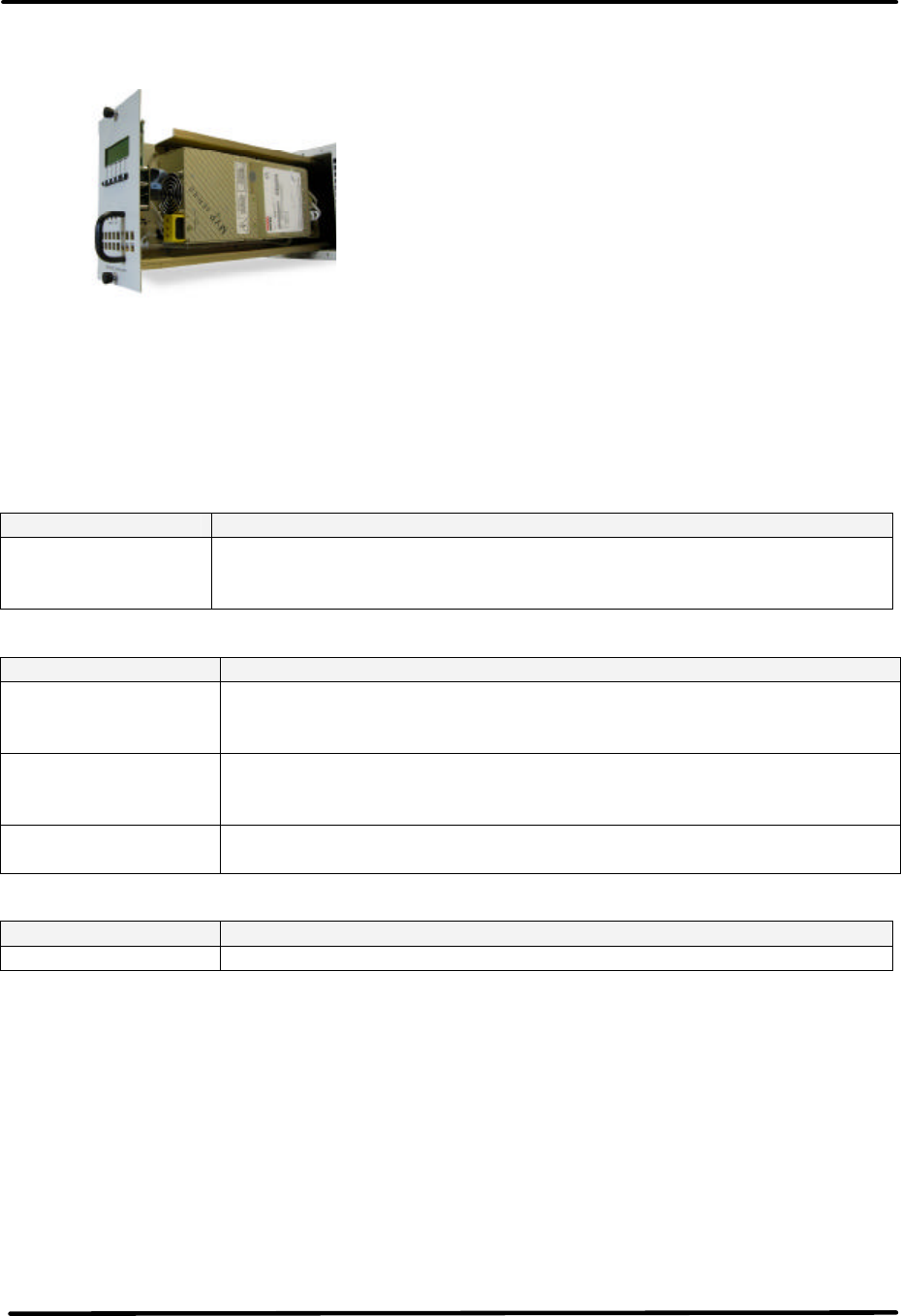
Digital UHF Driver/Transmitter Chapter 2, System Description,
Maintenance & Remote Control Connections
LX Series, Rev. 1 2-6
2.1.3 (A4) Control/Power Supply
Module Assembly, 220 VAC
(1303229; Appendix A)
The (A4) Control & Monitoring/Power
Supply Assembly is configured at the
factory for operation at 110 VAC or 220
VAC. The assembly made up of a Control
Board (1302021), a Power Protection
Board (1302837) and a Switch Board
(1527-1406). The Assembly also
contains a switching power supply that
provides ±12 VDC to the rest of the
modules in the chassis and +32 VDC to
the Power Amplifier module.
The Assembly provides all transmitter
control and monitoring functions. The
Front panel LCD allows monitoring of
system parameters, including forward
and reflected power, transistor currents,
module temperatures and power supply
voltages.
Table 2-10: Controller/Power Supply Display
DISPLAY FUNCTION
LCD A 4 x 20 display providing a four-line readout of the internal
functions, external inputs, and status. See Chapter 3,
Controller/Power Supply Display Screens, for a listing of displays.
Table 2-11: Controller/Power Supply Status Indicator
LED FUNCTION
OPERATE
(green)
When lit it indicates that the transmitter is in the Operate Mode. If
transmitter is Muted the Operate LED will stay lit, the transmitter
will remain in Operate, until the input signal is returned.
FAULT
(red or green)
Red indicates that a problem has occurred in the transmitter. The
transmitter will be Muted or placed in Standby until the problem is
corrected.
DC OK
( red or green ) Green indicates that the switchable fuse protected DC outputs that
connect to the modules in the transmitter are OK.
Table 2-12: Controller/Power Supply Control Adjustments
POTENTIOMETERS
DESCRIPTION
DISPLAY CONTRAST Adjusts the contrast of the display for desired viewing of screen.
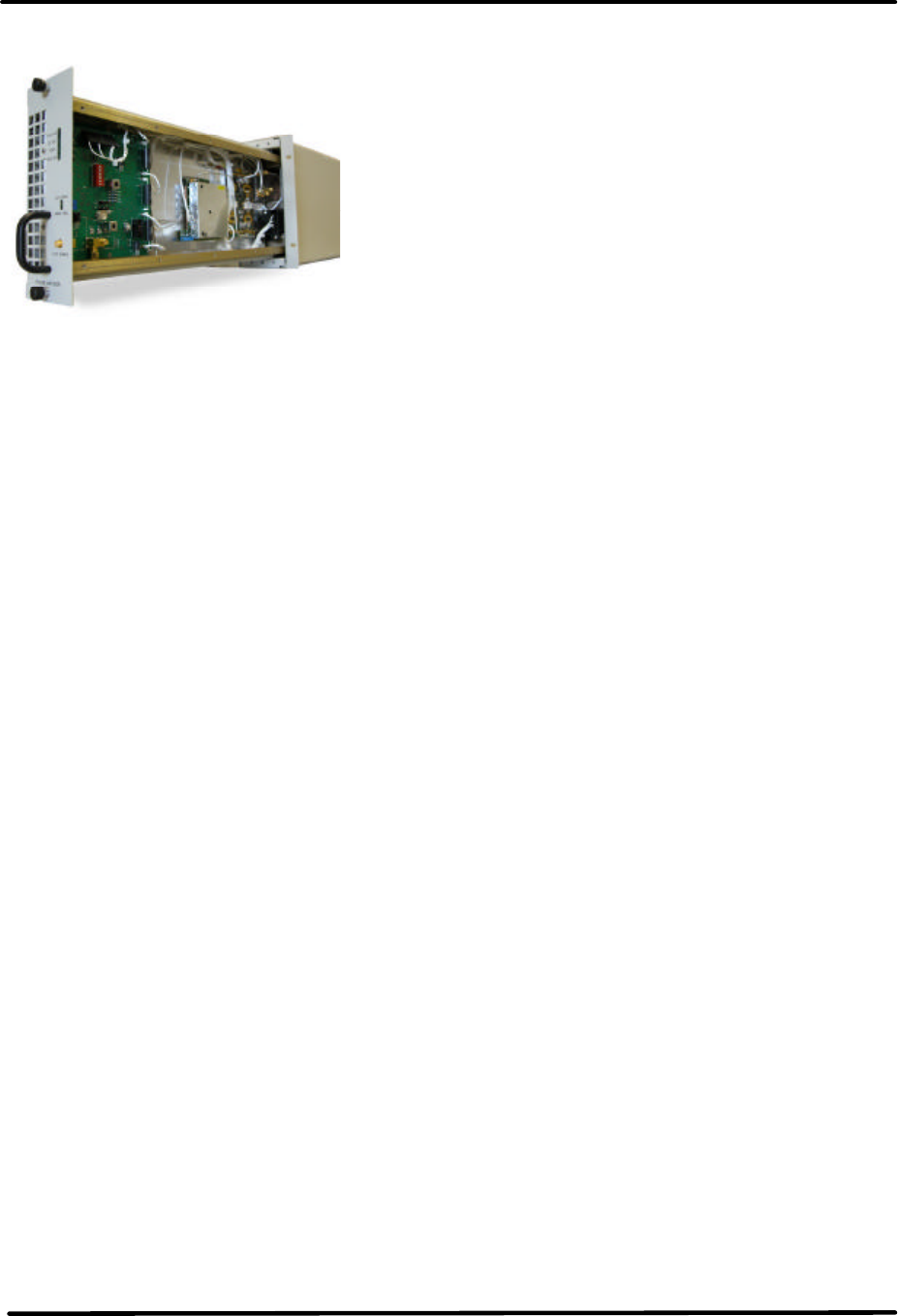
Digital UHF Driver/Transmitter Chapter 2, System Description,
Maintenance & Remote Control Connections
LX Series, Rev. 1 2-7
2.1.4 (A6) Driver Amplifier Module
Assembly (1303874; Appendix A)
The (A6) Power Amplifier Module
Assembly is made up of a Coupler Board
Assembly (1227-1316), an Amplifier
Control Board (1303682), a 1 Watt
Module Assembly (1302891), a 40W UHF
Module (1304490) and a RF Module Pallet
(1300116).
The Driver Power Amplifier Module
contains Broadband LDMOS amplifiers
that cover the entire UHF band with no
tuning required. They amplify the RF to
the power level, 3.5 Watts Average is
maximum, that is needed to drive the
external amplifiers to the output power
level of the transmitter.
The Driver Power Amplifier is used to
amplify the RF output of the
Upconverter module. A cable, located on
the rear chassis, connects the RF output
from the Upconverter at J23 to J24 the
RF input to the driver PA Assembly. This
module contains RF monitoring circuitry
for both an analog and a digital system.
Control and monitoring lines to the
Driver Power Amplifier module are
routed through the floating blind-mate
connector of the Control &
Monitoring/Power Supply module.
The Driver Power Amplifier module and
any External Amplifier modules contain
the same control and monitoring board.
This board monitors RF output power,
RF reflected power, the current draw of
amplifier sections, the supply voltage,
and the temperature of the PA heat sink.
The RF power detector circuit outputs
vary with operating frequency. These
circuits must be calibrated at their
intended operating frequency. Front
panel adjustment potentiometers are
used to calibrate the following:
Power Amplifier Calibration Adjustments
R201 Reflected Power Cal
R202 Forward Power Cal
R203 (NOT USED) Aural Power Cal
R205 (NOT USED) Aural Null
The Forward power of an Exciter Driver
Power Amplifier and the Forward power
of any external amplifiers, are reported
by the system Control Monitoring
module.
If the Control Monitoring module is
monitoring a 5-50 Watt Transmitter,
system power is measured in the Power
Amplifier module. The wired
connections are transferred through the
power supply connector to the
backplane board on a five position
header. All four positions of control
board switch SW1 must be set on to
route these lines as the system's RF
power signals. In systems of output
power greater than 50 Watts, system
power is monitored by an external
module that is connected to TB31. In
this configuration switches SW1 on the
control board must be set off.
The Forward Power of the Exciter Driver
Power Amplifier module is routed to the
Upconverter module as AGC #1. A
system over-drive condition is detected
when this value rises above 0.9 VDC.
When an over-drive condition is
detected, the Upconverter module
reduces its RF output level.
For values less than 0.9 VDC, the
Upconverter uses this voltage for
automatic gain.
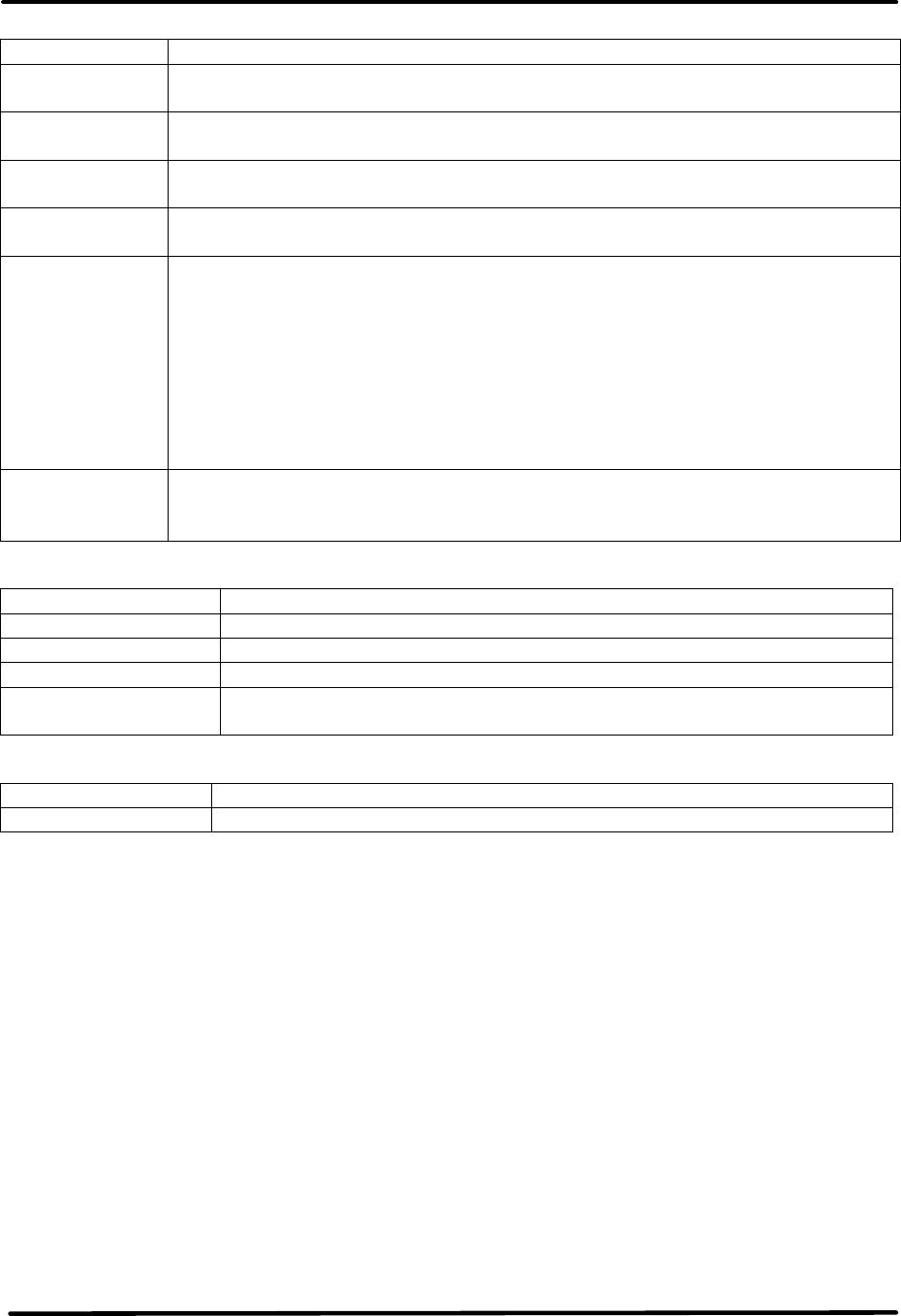
Digital UHF Driver/Transmitter Chapter 2, System Description,
Maintenance & Remote Control Connections
LX Series, Rev. 1 2-8
Table 2-13: Driver Amplifier Status Indicator
LED FUNCTION
ENABLED
(Green) When lit Green, it indicates that the PA is in the Operate Mode. If a Mute
occurs, the PA will remain Enabled, until the input signal is returned.
DC OK
(Green) When lit Green, it indicates that the fuse protected DC inputs to the PA
module are OK.
TEMP
(Green) When lit Green, it indicates that the temperature of the heatsink
assembly in the module is below 78°C.
MOD OK
(Green) When lit Green, it indicates that the PA Module is operating and has no
faults.
MOD OK
(Red)
If the Module OK LED is Red and blinking a fault is present, as indicated
below by the number of blinks and a pause then a repeat of the number
of blinks and a pause.
1 Blink indicates Amplifier Current Fault.
2 Blinks indicate Temperature Fault.
3 Blinks indicate +32V Power Supply Over Voltage Fault.
4 Blinks indicate +32V Power Supply Under Voltage Fault.
5 Blinks indicate Reflected Power Fault.
6 Blinks indicate +12V or –12V Power Supply Fault.
MOD OK
(Amber)
A blinking Amber Mod OK LED indicates the power output of the amplifier
module is below 65%. (NOTE: Only in Amplifier Code Versions 3.7A or
later & System Controller Code Versions 3.9C or later.)
Table 2-14: Driver Amplifier Control Adjustments
POTENTIOMETERS
DESCRIPTION
REFLECTED CAL Adjusts the gain of the Reflected Power monitoring circuit
FORWARD CAL Adjusts the gain of the Forward Power monitoring circuit
AURAL CAL (NOT USED) Adjusts the gain of the Aural Power monitoring circuit
AURAL NULL (NOT USED) Adjusts the offset of the Forward Power monitoring
circuit based on the Aural signal level.
Table 2-15: Driver Amplifier Sample
DISPLAY FUNCTION
FWD SAMPLE RF sample of the amplified signal being sent out the module on J25.

Digital UHF Driver/Transmitter Chapter 2, System Description,
Maintenance & Remote Control Connections
LX Series, Rev. 1 2-9
2.2 RF Output Assemblies
The RF output from the exciter power
amplifier is at the RF output jack, an “N”
connector J25, PA RF Output, of the
chassis assembly. If this assembly is
used as a driver the output connects to
the input of the PA Assembly or a splitter
for multiple PA Assemblies, mounted
beneath the Exciter Assembly. If this
assembly is used as a 5W to 50W
transmitter, then the output connects
directly to the bandpass filter for the
system.
The RF output of the transmitter is
typically connected to a low pass and
DTV mask filters mounted on the rear or
top of the cabinet assembly. The low
pass and DTV mask filters are tuned to
eliminate unwanted sideband and
harmonic frequencies.
2.3 Control and Status
The control and status readings of the
exciter/amplifier Chassis assembly are
found by operating the front panel
display screen on the front of the
assembly. Detailed information on the
use of the screens is found in chapter 3.
2.3.1 Front Panel Display Screens
A 4 x 20 display located on the front of
the Control & Monitoring/Power Supply
Module is used in the LX Series
transmitter for control of the operation
and display of the operating parameters
of the transmitter. Refer to Chapter 3
for descriptions of the screens.
2.4 System Operation
When the transmitter is in operate, as set
by the menu screen located on the
Control & Monitoring Module, the
following occurs. The IF Processor will be
enabled and the mute indicator on the
front panel will be extinguished. The
+32 VDC stage of the Power Supply in
the Control & Monitoring Module is
enabled, the operate indicator on the
front panel is lit and the DC OK on the
front panel should also be green. The
enable and DC OK indicators on the PA
Module will also be green.
When the transmitter is in standby, the
IF Processor will be disabled, and the
mute indicator on the front panel will be
red. The +32 VDC stage of the Power
Supply in the Control & Monitoring
Module is disabled, the operate indicator
on the front panel will be extinguished
and the DC OK on the front panel should
remain green. The enable indicator on
the PA Module is also extinguished.
If the transmitter does not switch to
Operate when the operate menu is
switched to Operate, check that all faults
are cleared and that the remote control
terminal block stand-by signal is not
active.
The transmitter can be controlled by the
presence of an input signal. If the input
signal to the transmitter is lost, the
transmitter automatically cuts back and
the input fault indicator on the IF
Processor module lights. When the input
signal returns, the transmitter
automatically returns to full power and
the input fault indicator is extinguished.
2.4.1 Principles of Operation
Operating Modes
This transmitter is either operating or in
the standby mode. The sections below
discuss the characteristics of each of
these modes.
Operate Mode
Operate mode is the normal mode for
the transmitter when it is providing RF
power output. To provide RF power to
the output, the transmitter is not in
mute. Mute is a special case of the

Digital UHF Driver/Transmitter Chapter 2, System Description,
Maintenance & Remote Control Connections
LX Series, Rev. 1 2-10
operate mode where the +32 VDC
section of the power supply is enabled
but there is no RF output power from
the transmitter. This condition is the
result of a fault that causes the firmware
to hold the IF Processor module in a
mute state.
Operate Mode with Mute Condition
The transmitter will remain in the
operate mode but will be placed in mute
when the following fault conditions
exists in the transmitter.
• Upconverter is unlocked
• Upconverter module is not present
• IF Processor module is not present
Entering Operate Mode
Entering the operate mode can be
initiated a few different ways by the
transmitter control board. A list of the
actions that cause the operate mode to
be entered is given below:
• A low on the Remote Transmitter
Operate line.
• User selects "OPR" using switches
and menus of the front panel.
• Receipt of an “Operate CMD” over
the serial interface.
There are several fault or interlock
conditions that may exist in the
transmitter that will prevent the
transmitter from entering the operate
mode. These conditions are:
• Power Amplifier heat sink
temperature greater than 78°C.
• Transmitter is Muted due to
conditions listed above.
• Power Amplifier Interlock is high
indicating that the amplifier is not
installed.
Standby Mode
The standby mode in the transmitter
indicates that the output amplifier of the
transmitter is disabled.
Entering Standby Mode
Similar to the operate mode, the
standby mode is entered using various
means. These are:
• A low on the Remote Transmitter
Stand-By line.
• Depressing the “STB” key on
selected front panel menus.
• Receipt of a “Standby CMD” over the
serial interface.
Auto Standby Mode
The FCC requires that certain
transmitters automatically switch to
standby operation on loss of input. The
LX Series transmitter incorporates this
feature as a user configurable setting.
When Auto Stand-By on input loss is
selected in the set-up menus, the
transmitter temporarily switches to
standby after ten seconds of input loss.
When the input signal, as reported by
the IF Processor module, is again
present, the transmitter automatically
returns to the Operate mode. This
feature is implemented in transmitter
software versions 1.4 and above.
RF System Interlock
A RF System Interlock signal is provided
through TB30-5. When this signal's
circuit is completed to ground such as
through a wire between TB30-5 and
TB30-15, the transmitter is allowed to
operate. If this circuit is opened, the
transmitter switches to a Mute condition.
This circuit may be completed through
coax relay contacts and reject load
contact closures to assure the RF output
system is available to receive the
transmitter's output RF signal. This
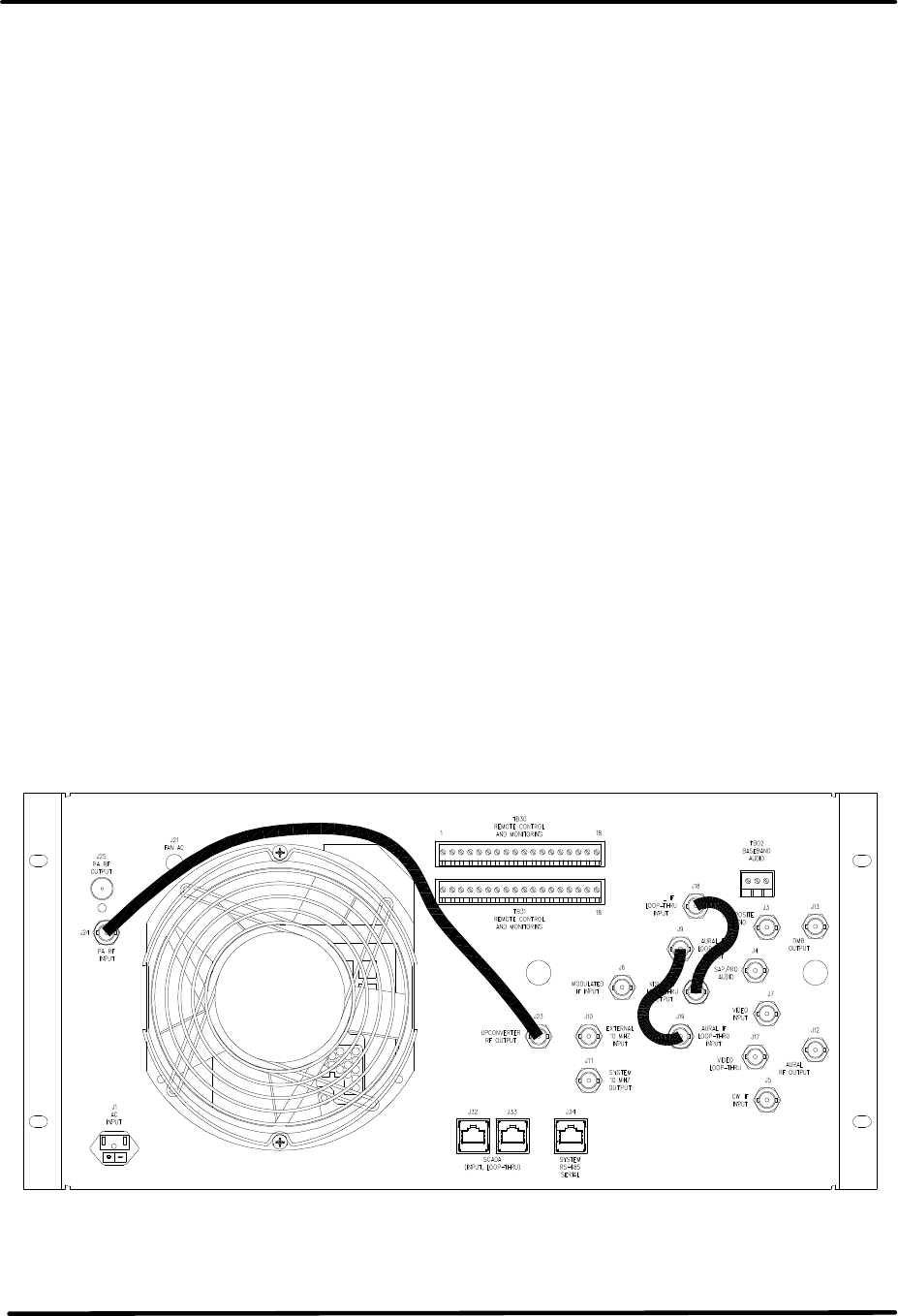
Digital UHF Driver/Transmitter Chapter 2, System Description,
Maintenance & Remote Control Connections
LX Series, Rev. 1 2-11
feature is implemented in transmitter
software versions 1.4 and above.
2.5 Maintenance
The Innovator LX Series
Driver/Transmitter is designed with
components that require little or no
periodic maintenance except for the
routine cleaning of the fans and the front
panels of the modules.
The amount of time between cleanings
depends on the conditions within the
transmitter room. While the electronics
have been designed to function even if
covered with dust, a heavy buildup of
dust, dirt, or insects will affect the
cooling of the components. This could
lead to a thermal shutdown or the
premature failure of the affected module.
When the front panels of the modules
become dust covered, the module should
be pulled out and any accumulated
foreign material should be removed.
NOTE: In the power amplifier module the
two cables must be removed from the
rear of the module before attempting to
pull out. A vacuum cleaner, utilizing a
small, wand-type attachment, is an
excellent way to suction out the dirt.
Alcohol and other cleaning agents should
not be used unless you are certain that
the solvents will not damage components
or the silk-screened markings on the
modules and boards. Water-based
cleaners can be used, but do not saturate
the components. The fans and heatsinks
should be cleaned of all dust or dirt to
permit the free flow of air for cooling
purposes.
It is recommended that the operating
parameters of the driver/transmitter be
recorded from the LEDs on the modules
and the LCD system metering on the
control/monitoring module at least once
a month. It is suggested that this data be
retained in a rugged folder or envelope.
2.6 Customer Remote Connections
The remote monitoring and operation of
the transmitter is provided through jacks
TB30 and TB31 located on the rear of the
chassis assembly. If remote connections
are made to the transmitter, they must
be made through plugs TB30 and TB31
at positions noted on the transmitter
interconnect drawing and Table 2-16.
Figure 2-2: Exciter/Driver Chassis Assembly Rear View
TB30
TB31
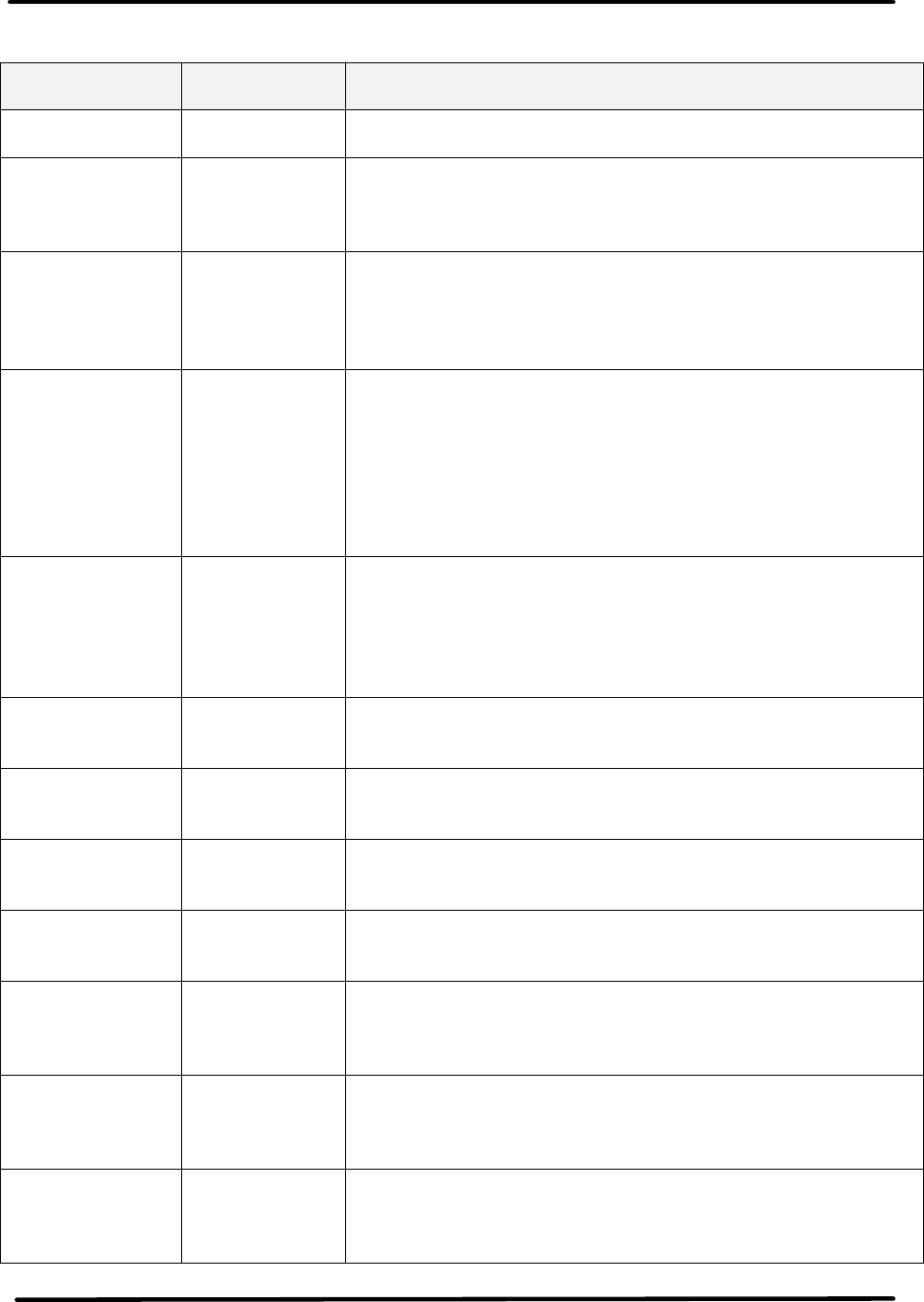
Digital UHF Driver/Transmitter Chapter 2, System Description,
Maintenance & Remote Control Connections
LX Series, Rev. 1 2-12
Table 2-16: LX Series Chassis Assembly Hard Wired Remote Interface Connections to
TB30 or TB31, 18 pos. Terminal Blocks Located on the Rear of the Assembly
Signal Name Pin
Designations Signal Type/Description
RMT Transmitter
State TB30-1 Discrete Open Collector Output - A low indicates that the
transmitter is in the operate mode.
RMT Transmitter
Interlock TB30-2
Discrete Open Collector Output - A low indicated the
transmitter is OK or completes an interlock daisy chain.
When the transmitter is not faulted, the interlock circuit
is completed.
RMT Transmitter
Interlock
Isolated Return TB30-3
Ground - Configurable ground return which can be either
jumpered directly to ground or it can be the “source” pin
of an FET so that the transmitter interlock can be daisy
chained with other transmitters. This signal does not
directly interface to the microcontroller.
RMT AUX IO 1 TB30-4
Discrete Open Collector Inputs, Discrete Open Drain
Outputs, or 0 - 5 VDC Analog Input - When used as an
output, this line is pulled to +5 VDC with a 1.0 kO
resistor for logic high and pulled to ground for a low. A
diode allows this line to be pulled up to 12 VDC. When
used as a digital input, this line considers all values over
2 Volts as high and those under 1 volt as low. As an
analog input, this line is protected by a 5.1 zener diode.
RMT RF System
Interlock TB30-5
When this signal's circuit is completed to ground the
transmitter is allowed to operate. Typically, a jumper is
connected from TB30-5 and TB30-15. If this circuit is
opened, the transmitter switches to a Mute condition.
Implemented in transmitter software versions 1.4 and
above. (See note at end of table)
RMT
Transmitter
Operate TB30-6 Discrete Open Collector Input - A pull down to ground on
this line indicates that the transmitter is to be placed into
the operate mode.
RMT
Transmitter
Stand-By TB30-7 Discrete Open Collector Input - A pull down to ground on
this line indicates that the transmitter is to be placed into
the standby mode.
RMT Power
Raise TB30-8 Discrete Open Collector Input - A pull down to ground on
this line indicates that the transmitter power is to be
raised.
RMT Power
Lower TB30-9 Discrete Open Collector Input - A pull down to ground on
this line indicates that the transmitter power is to be
lowered.
RMT
System Reflect
Power TB30-10
Analog Output (0 to 4.0 V). This is a buffered loop
through of the calibrated “System Reflected Power” and
indicates the transmitter's reflected output power. The
scale factor is 25%/3.2V.
RMT System
Visual/Forward
Power TB30-11
Analog Output (0 to 4.0 V). This is a buffered loop
through of the calibrated “System Visual/Avg. Power”.
Indicates the transmitter's Visual / Average power. Scale
factor is 100%/3.2V.
RMT
System Aural
Power TB30-12
Analog Output (0 to 4.0 V). This is a buffered loop
through of the calibrated “System Aural Power”.
Indicates the transmitter's forward Aural output power.
The scale factor is 100%/3.2V.

Digital UHF Driver/Transmitter Chapter 2, System Description,
Maintenance & Remote Control Connections
LX Series, Rev. 1 2-13
Signal Name Pin
Designations Signal Type/Description
RMT Spare 1 TB30-13 Remote connection to spare module - Use is TBD.
RMT Spare 2 TB30-14 Remote connection to spare module - Use is TBD.
System Reflect
Power TB31-13 Analog Input (0 to 1.00 V). This is the input of the
“System Reflected Power” indicating the transmitter's
reflected output power. The scale factor is 25%/0.80V.
System Visual /
Forward Power TB31-14
Analog Input (0 to 1.00 V). This is the input of the
“System Visual / Forward Power” indicating the
transmitter's forward Visual / Forward output power. The
scale factor is 100%/0.80V.
System Aural
Power TB31-15
Analog Input (0 to 1.00 V). This is the input of the
“System Aural Power” indicating the transmitter's
forward Aural output power. The scale factor is
100%/0.80V. (Not used in digital)
IF Processor
IF Signal Select TB31-3
Discrete Open Collector Input - A low indicates that the
modulator IF source is to be used by the IF Processor
module. When floating an analog IF Processor module
may use the Modulated IF Input if the IF Processor sled
is so configured.
IF Processor
DLC Voltage TB31-4 Analog Output (0 to 5.00 V). This is the input of IF
Processor module for digital system RF output power
control.
UC AGC #2
Voltage TB31-5
Auxiliary Analog Input (0 to 1V). This voltage is used by
the Upconverter for gain control. Linear signal with
display resolution of 0.01 %. Primary signal source is
J34-1.
RMT Ground TB30-15, and
17 Ground pins available through Remote
RMT Ground TB31-1, 2, 6
to 12, and 17 Ground pins available through Remote
RMT +12 VDC TB30-16
TB31-16 +12 VDC available through Remote w/ 2 Amp re-settable
fuse
RMT -12 VDC TB30-18
TB31-18 -12 VDC available through Remote w/ 2 Amp re-settable
fuse
NOTE: The Remote RF System Interlock, at TB30-5, provides the customer with a
means of connecting the transmitter to protection circuits, for the loads, thermal
switches, combiners, or the antenna, in the output of your system, that Mutes
the transmitter if the protection circuit opens. If the interlock is not used in the
system, a jumper from TB30-5 to TB30-15, which is ground, needs to be
connected to TB30. This jumper provides the RF System Interlock, which allows
the transmitter to go to operate. Without the jumper, the transmitter will remain
Muted.
\
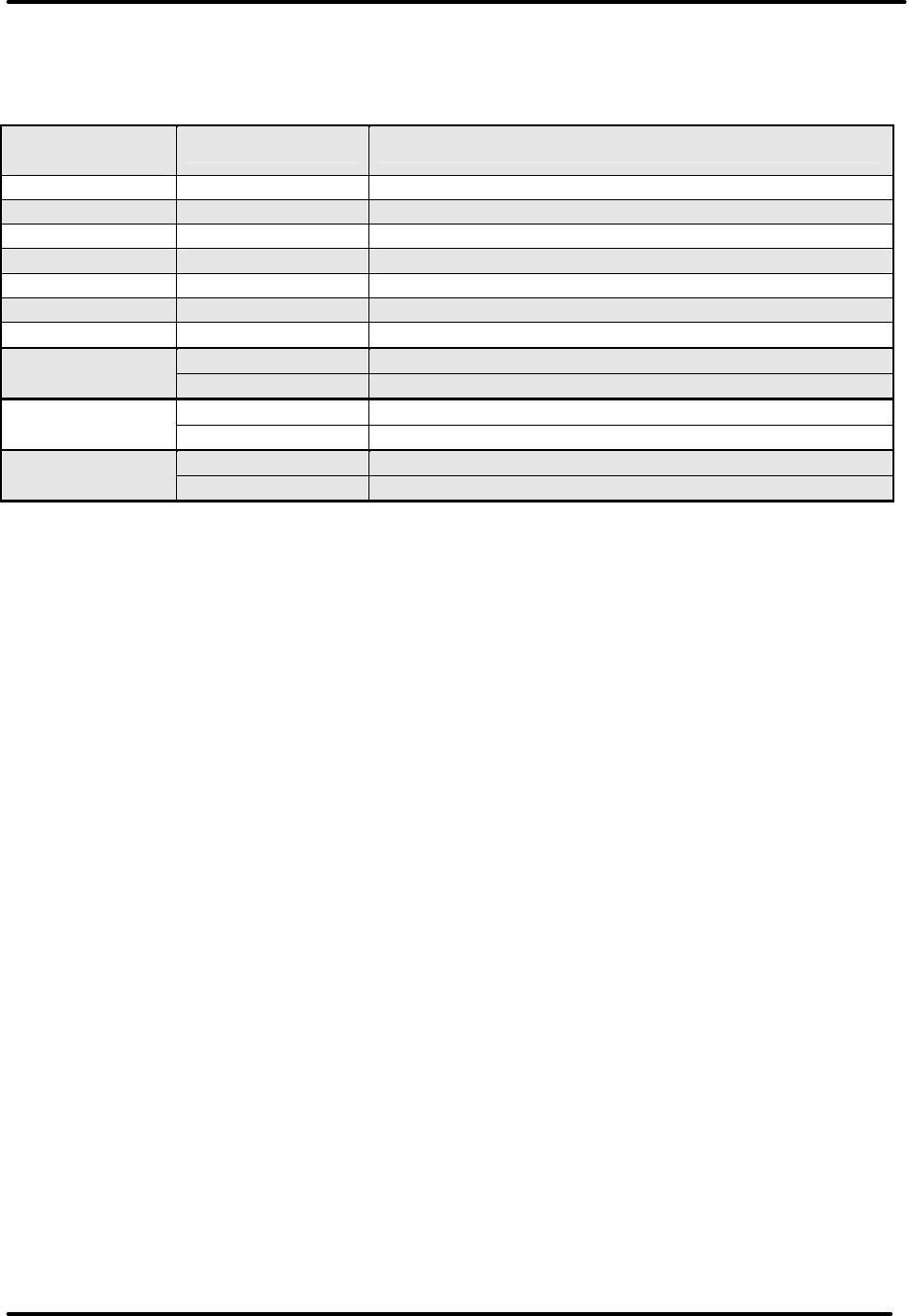
Digital UHF Driver/Transmitter Chapter 3, Site Considerations,
Installation and Setup Procedures
LX Series, Rev. 1 3-1
Chapter 3:
Site Considerations, Installation and Setup Procedures
Table 3-1: LX Series Digital Transmitters/Drivers AC Input and Current Requirements.
Transmitter/
Driver Voltage Current
5 Watt 117/220 VAC 5 Amps
50 Watt 117/220 VAC 10 Amps
125 Watt 220 VAC 10 Amps to the Exciter/Amplifier Cabinet
250 Watt 220 VAC 15 Amps to the Exciter/Amplifier Cabinet
500 Watt 220 VAC 25 Amps to the Exciter/Amplifier Cabinet
1000 Watt 220 VAC 45 Amps to the Exciter/Amplifier Cabinet
1500 Watt 220 VAC 65 Amps to the Exciter/Amplifier Cabinet
220 VAC 45 Amps to the Exciter/Amplifier Cabinet
2000 Watt 220 VAC 40 Amps to the Amplifier Cabinet
220 VAC 45 Amps to the Exciter/Amplifier Cabinet
2500 Watt 220 VAC 60 Amps to the Amplifier Cabinet
220 VAC 65 Amp to the Exciter/Amplifier Cabinet
3000 Watt 220 VAC 60 Amps to the Amplifier Cabinet
3.1: Site Considerations
There are special considerations that
need to be taken into account before the
LX Series digital driver/transmitter can
be installed. For example, if the
installation is completed during cool
weather, a heat-related problem may not
surface for many months, suddenly
appearing during the heat of summer.
This section provides planning
information for the installation and set up
of the transmitter.
The AC input and current requirements
for LX Series digital transmitters are
shown in Table 3-1.
NOTE: This 1000 Watt transmitter is
typically operating at 220 VAC @ 45
Amps to the Exciter/Amplifier Cabinet.
The LX Series Digital Transmitters are
designed and built to provide long life
with a minimum of maintenance. The
environment in which they are placed is
important and certain precautions must
be taken. The three greatest dangers to
the transmitter are heat, dirt, and
moisture. Heat is usually the greatest
problem, followed by dirt, and then
moisture. Over-temperature can cause
heat-related problems such as thermal
runaway and component failure. Each
amplifier module in the transmitter
contains a thermal interlock protection
circuit that will shut down that module
until the temperature drops to an
acceptable level.
A suitable environment for the
transmitter can enhance the overall
performance and reliability of the
transmitter and maximize revenues by
minimizing downtime. A properly
designed facility will have an adequate
supply of cool, clean air, free of airborne
particulates of any kind, and no
excessive humidity. An ideal environment
will require temperature in the range of
40° F to 70° F throughout the year,
reasonably low humidity, and a dust-free
room. It should be noted that this is
rarely if ever attainable in the real world.
However, the closer the environment is
to this design, the greater the operating
capacity of the transmitter.
The fans are designed and built into the
transmitter will remove the heat from
within the modules, but additional means
are required for removing this heat from

Digital UHF Driver/Transmitter Chapter 3, Site Considerations,
Installation and Setup Procedures
LX Series, Rev. 1 3-2
the building. To achieve this, a few issues
need to be resolved. The first step is to
determine the amount of heat to be
removed from the transmitter room.
There are generally three sources of heat
that must be considered. The first and
most obvious is the heat from the
transmitter itself. This amount can be
determined for a 50W digital transmitter
by subtracting the average power to the
antenna (50 watts) from the AC input
power (650 watts) and taking this
number in watts (600) and then
multiplying it by 3.41. This gives a result
of 2,046, the BTUs to be removed every
hour. 12,000 BTUs per hour equals one
ton. Therefore, a 1/4-ton air conditioner
will easily cool a 50W digital transmitter.
The second source of heat is other
equipment in the same room. This
number is calculated in the same way as
the equation for BTUs. The third source
of heat is equally obvious but not as
simple to calculate. This is the heat
coming through the walls, roof, and
windows on a hot summer day. Unless
the underside is exposed, the floor is
usually not a problem. Determining this
number is usually best left up to a
qualified HVAC technician. There are far
too many variables to even estimate this
number without reviewing the detailed
drawings of the site that show all of the
construction details. The sum of these
three sources is the bulk of the heat that
must be removed. There may be other
sources of heat, such as personnel, and
all should be taken into account.
Now that the amount of heat that must
be removed is known, the next step is to
determine how to accomplish this. The
options are air conditioning, ventilation,
or a combination of the two. Air
conditioning is always the preferred
method and is the only way to create
anything close to an ideal environment.
Ventilation will work quite well if the
ambient air temperature is below 100° F,
or about 38° C, and the humidity is kept
at a reasonable level. In addition, the air
stream must be adequately filtered to
ensure that no airborne particulates of
any kind will be carried into the
transmitter. The combination of air
conditioning for summer and ventilation
during the cooler months is acceptable
when the proper cooling cannot be
obtained through the use of ventilation
alone and using air conditioning
throughout the year is not feasible.
Caution: The use of air conditioning
and ventilation simultaneously is not
recommended. This can cause
condensation in the transmitters.
The following precautions should be
observed regarding air conditioning
systems:
1. Air conditioners have an ARI
nominal cooling capacity rating. In
selecting an air conditioner, do not
assume that this number can be
equated to the requirements of
the site. Make certain that the
contractor uses the actual
conditions that are to be
maintained at the site in
determining the size of the air
conditioning unit.
2. Do not have the air conditioner
blowing directly onto the
transmitter. Under certain
conditions, condensation may
occur on, or worse in, the
transmitter.
3. Do not separate the front of the
transmitter from the back with the
thought of air conditioning only
the front of the unit. Cooling air is
drawn in at the front of all
transmitters and in the front and
back of others. Any attempt to
separate the front of the
transmitter from the rear of the
unit will adversely affect the flow
of cooling air.
4. Interlocking the transmitter with
the air conditioner is

Digital UHF Driver/Transmitter Chapter 3, Site Considerations,
Installation and Setup Procedures
LX Series, Rev. 1 3-3
recommended to keep the
transmitter from operating without
the necessary cooling.
5. The periodic cleaning of all filters
is a must.
When using ventilation alone, the
following general statements apply:
1. The blower, with attendant filters,
should be on the inlet, thereby
pressurizing the room and
preventing dirt from entering the
transmitter.
2. The inlet and outlet vents should
be on the same side of the
building, preferably the leeward
side. As a result, the pressure
differential created by wind will be
minimized. Only the outlet vent
may be released through the roof.
3. The inlet and outlet vents should
be screened with 1/8-inch
hardware cloth (preferred) or
galvanized hardware cloth
(acceptable).
4. Cooling air should enter the room
as low as practical but in no case
higher than four feet above the
floor. The inlet must be located
where dirt, leaves, snow, etc., will
not be carried in with the cooling
air.
5. The exhaust should be located as
high as possible. Some ducting is
usually required to insure the
complete flushing of heated air
with no stagnant areas.
6. The filter area must be large
enough to insure a maximum air
velocity of 300 feet per minute
through the filter. This is not a
conservative number but a never-
exceed number. In a dusty or
remote location, this number
should be reduced to 150 CFM.
7. The inlet and outlet(s) must have
automatic dampers that close any
time the ventilation blower is off.
8. In those cases in which
transmitters are regularly off for a
portion of each day, a
temperature-differential sensor
that controls a small heater must
be installed. This sensor will
monitor inside and outside
temperatures simultaneously. If
the inside temperature falls to
within 5° F of the outside
temperature, the heater will come
on. This will prevent condensation
when the ventilation blower comes
on and should be used even in the
summer.
9. A controlled-air bypass system
must be installed to prevent the
temperature in the room from
falling below 40° F during
transmitter operation.
10. The blower should have two
speeds, which are thermostatically
controlled, and be interlocked with
the transmitter.
11. The blower on high speed must be
capable of moving the required
volume of air into a half inch of
water pressure at the required
elevation. The free air delivery
method must not be used.
12. Regular maintenance of the filters,
if used, can not be
overemphasized.
13. Above 4000 feet, for external
venting, the air vent on the
cabinet top must be increased to
an 8-inch diameter for a 1-kW
transmitter and to a 10-inch
diameter for 5-kW and 6-kW
transmitters. An equivalent
rectangular duct may be used but,
in all cases, the outlet must be
increased by 50% through the
outlet screen.
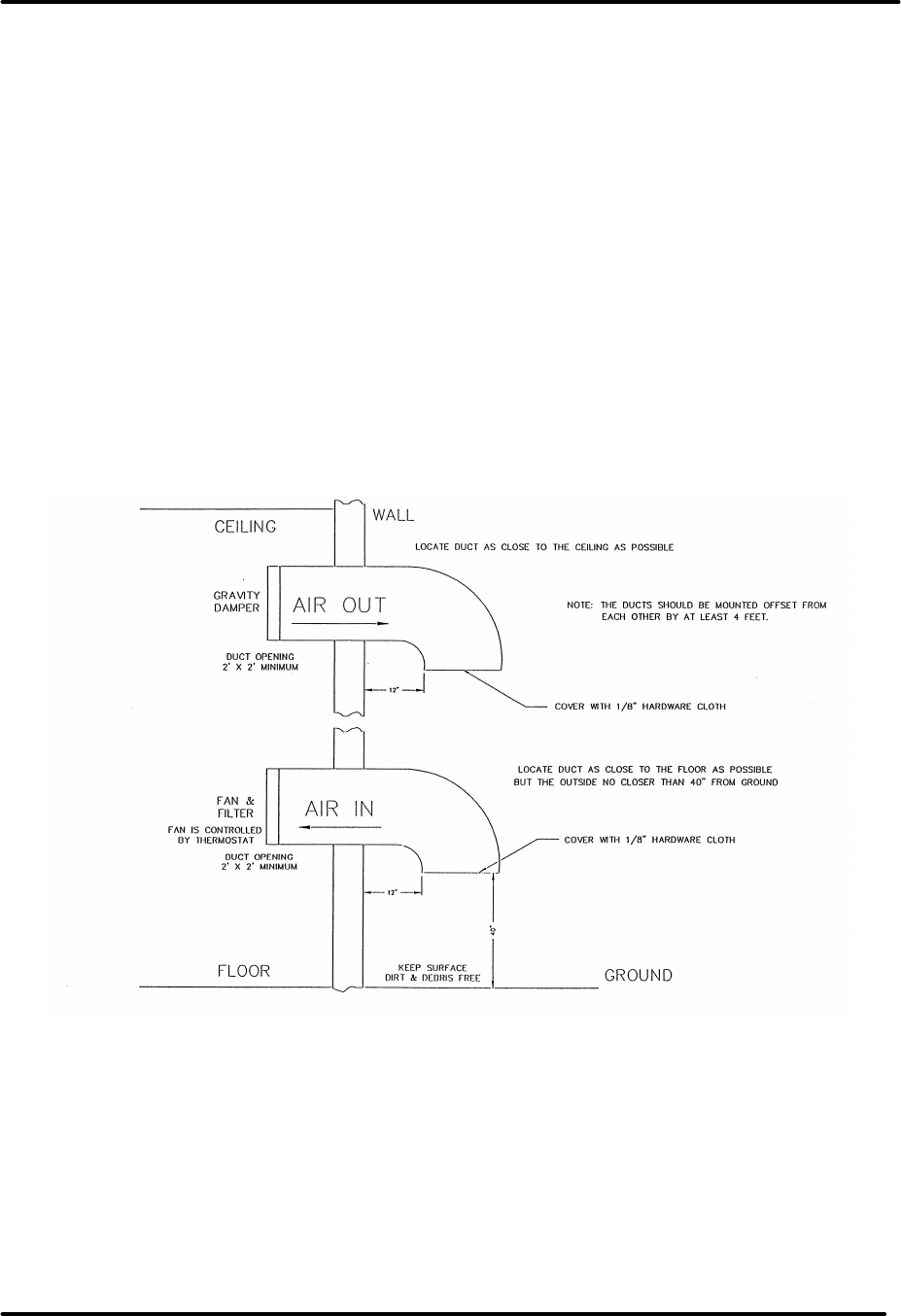
Digital UHF Driver/Transmitter Chapter 3, Site Considerations,
Installation and Setup Procedures
LX Series, Rev. 1 3-4
14. It is recommended that a site plan
be submitted to Axcera for
comments before installation
begins.
In calculating the blower requirements,
filter size, and exhaust size, if the total
load is known in watts, 2000 CFM into ½
inch of water will be required for each
5000 watts. If the load is known in BTUs,
2000 CFM into ½ inch of water will be
required for each 17,000 BTUs. The inlet
filter must be a minimum of seven
square feet, larger for dusty and remote
locations, for each 5000 watts or 17,000
BTUs. The exhaust must be at least four
square feet at the exhaust screen for
each 5000 watts or 17,000 BTUs.
The information presented in this section
is intended to serve only as a general
guide and may need to be modified for
unusually severe conditions. A
combination of air conditioning and
ventilation should not be difficult to
design (see Figure 3-1).
System interlocking and thermostat
settings should be reviewed with Axcera.
As with any equipment installation, it is
always good practice to consult the
manufacturer when questions arise.
Axcera can be contacted at (724) 873-
8100.
Figure 3-1: 500 Watt Minimum Ventilation Configuration

Digital UHF Driver/Transmitter Chapter 3, Site Considerations,
Installation and Setup Procedures
LX Series, Rev. 1 3-5
3.2: Unpacking the Chassis
w/modules, Digital Mask filter and
coupler assembly
Thoroughly inspect the chassis with
modules and all other materials upon
their arrival. Axcera certifies that upon
leaving our facility the equipment was
undamaged and in proper working order.
The shipping containers should be
inspected for obvious damage that
indicates rough handling.
Remove the chassis and modules, the
digital mask filter and directional coupler,
from the crates and boxes.
Check for dents and scratches or broken
connectors, switches or display. Any
claims against in-transit damage should
be directed to the carrier. Inform Axcera
as to the extent of any damage as soon
as possible.
The modules are mounted to the chassis
assembly with slides that are on the top
and the bottom of the modules. There
are two thumb screws on the front panel
that hold each of the modules in place.
The chassis assembly is mounted in the
cabinet using Chassis Trak cabinet slides.
The tray slides are on the side of the
assembly. Inspect the assembly for any
loose hardware or connectors, tightening
where needed.
After placement of cabinet, all mounting
hardware, holding tray slides, shelving
and mounting plates inside the cabinet
should be checked for tightness. All
screws and bolts that are accessible
should be tightened initially when the
transmitter is received and periodically
thereafter if the transmitter is moved by
vehicle. All coaxial connectors, hard-line
connections and hardware holding
combiners, splitters, or any other
mounted items should be checked and
tightened. Check the front panel
thumbscrews that hold the Exciter/Driver
Sleds, Amplifier Module and Power Supply
Sleds in place are tight. This is especially
important after the transmitter has been
transported.
3.3: Installing the Chassis w/modules,
Digital Mask filter and coupler
assembly
The chassis assembly is made to mount in
a standard 19” rack. The chassis assembly
mounts using the four #10 clearance
mounting holes on the ends. The chassis
should be positioned; to provide adequate
air intake into the front and the air exhaust
of the fan in the rear; the ability to slide
the modules out for replacement purposes;
the installation of the digital mask filter;
the coupler assembly; and output
transmission line. The chassis or cabinet in
which it is mounted should be grounded
using copper strapping material.
NOTE: To remove the driver/power
amplifier module, mounted in the
exciter/driver assembly, the input and
output cables must be removed from the
rear of the module and also a 6/32” x ½”
Philips screw, mounted between the two
connectors, needs to be removed before
the module will pull out. After removal of
the screw, which is used to hold the
module in place during shipping, it does
not need to be replaced.
Connect the digital mask filter and coupler
assembly to the output of the chassis
assembly.
Connect the transmission line for the
antenna system to the coupler output. The
Incident and Reflected outputs of the
coupler assembly may be used for test
purpose.
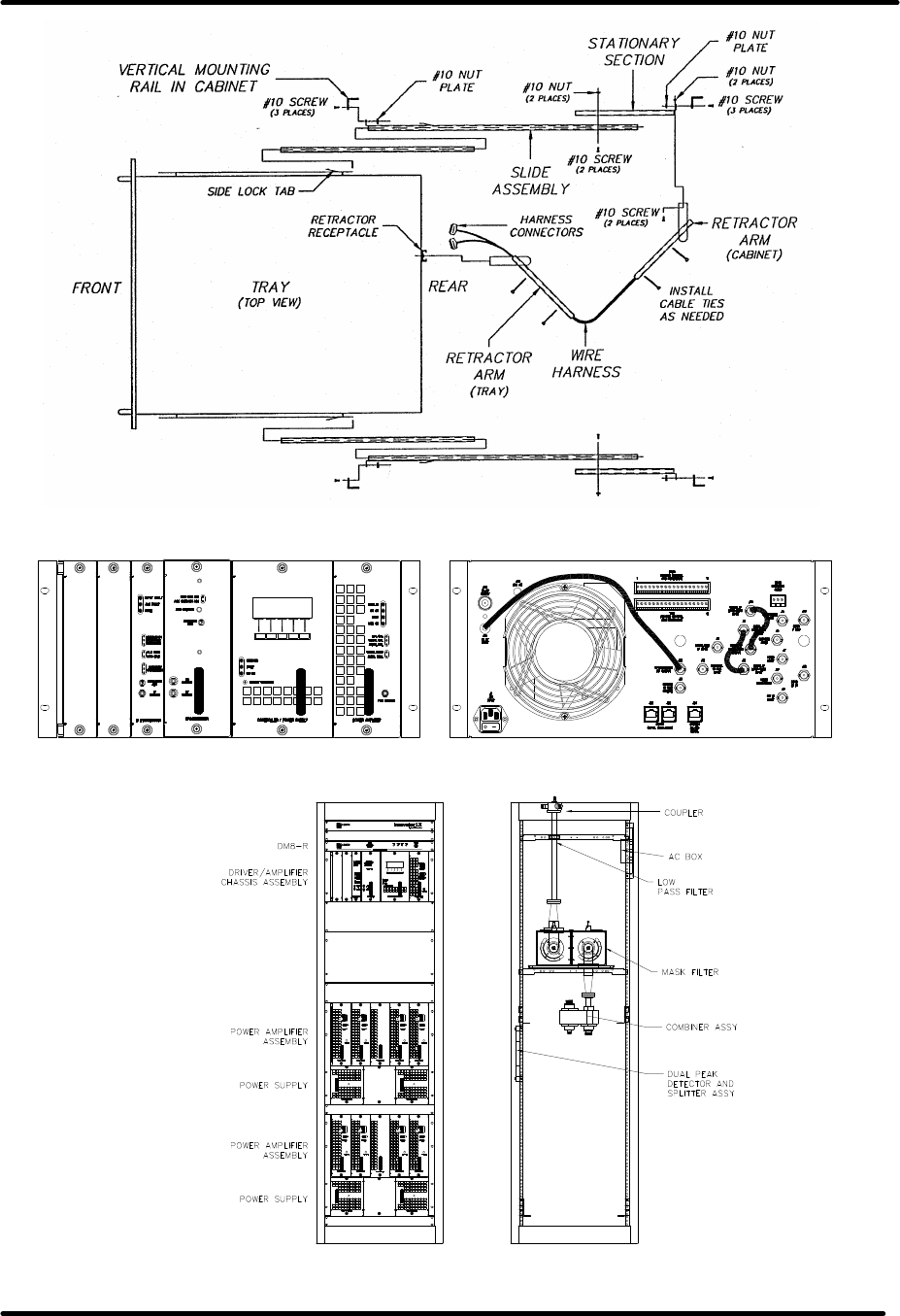
Digital UHF Driver/Transmitter Chapter 3, Site Considerations,
Installation and Setup Procedures
LX Series, Rev. 1 3-6
Figure 3-2: Tray Slides Cabinet Mounting Diagram
Figure 3-3: Front and Rear View Reconnection Drawing
Figure 3-4: Cabinet Front and Rear View Reconnection Drawing
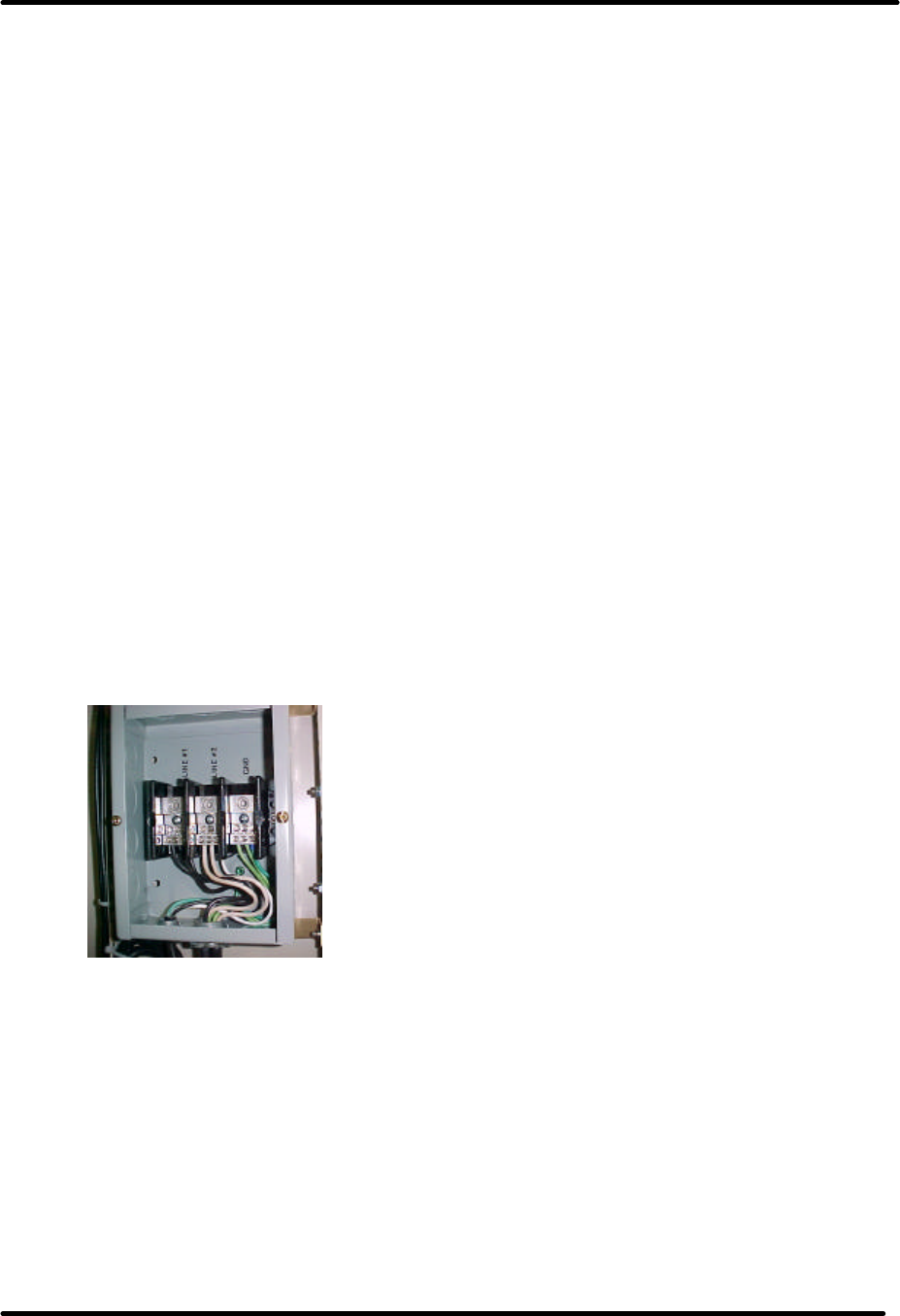
Digital UHF Driver/Transmitter Chapter 3, Site Considerations,
Installation and Setup Procedures
LX Series, Rev. 1 3-7
3.4: AC Input
Once the chassis and output
connections are in place, connect the
AC power cord from the chassis
assembly of the driver chassis
assembly to an AC outlet
The AC input and current requirements
for LX Series digital transmitter/drivers
are indicated in the Table 3-1 located
at the beginning of this chapter.
NOTE: This 1000 Watt transmitter is
typically requires 220 VAC @ 45 Amps
connected to the Driver/Amplifier
Cabinet.
The AC Input to the transmitter
connects to the terminal block mounted
in the AC input box located toward the
rear, right side near the top of the
cabinet. Connect the AC Input Line 1
to Line 1 on the terminal block, the AC
Input Line 2 to Line 2 on the terminal
block and the AC Input Ground to
Ground on the terminal block. See
Figure 3-5.
Figure 3-5: AC Input Box Assembly
NOTE: An AC On/Off Circuit Breaker is
located on the rear of the
Driver/Amplifier Chassis Assembly,
near the AC input jack. In this
transmitter, there are also On/Off
Circuit Breakers, located on the rear of
each Power Amplifier Assembly, one for
each power supply module.
This completes the unpacking and
installation of the LX Series UHF
television transmitter. Refer to the
setup and operation procedures that
follow before applying power to the
transmitter.
3.5: Set Up and Operation
Initially, the transmitter should be
turned on with the RF output at the
coupler assembly terminated into a
dummy load of a value dependent on
the power rating of the transmitter. If a
load is not available, check that the
output of the coupler assembly is
connected to the antenna for your
system.
3.5.1: Input Connections
The input connections to the
transmitter are made to jacks mounted
on the rear of the driver/amplifier
chassis assembly and the DM8-R Tray.
The DM8-R modulator accepts an
MPEG-2 transport stream input at J2,
located on the rear panel of the DM8-R
Tray and outputs an 8-VSB IF signal at
the IF Output Jack J4, also located on
the rear panel. The IF output is
centered at 44 MHz. This 8-VSB IF is
cabled to J6 the modulated IF input
jack, located on the rear panel of the
Driver/Amplifier Chassis Assembly,
where it connects to the IF Processor
Module.
Refer to the table 3-2 that follows for
detailed information on the LX
driver/amplifier chassis assembly
connections.
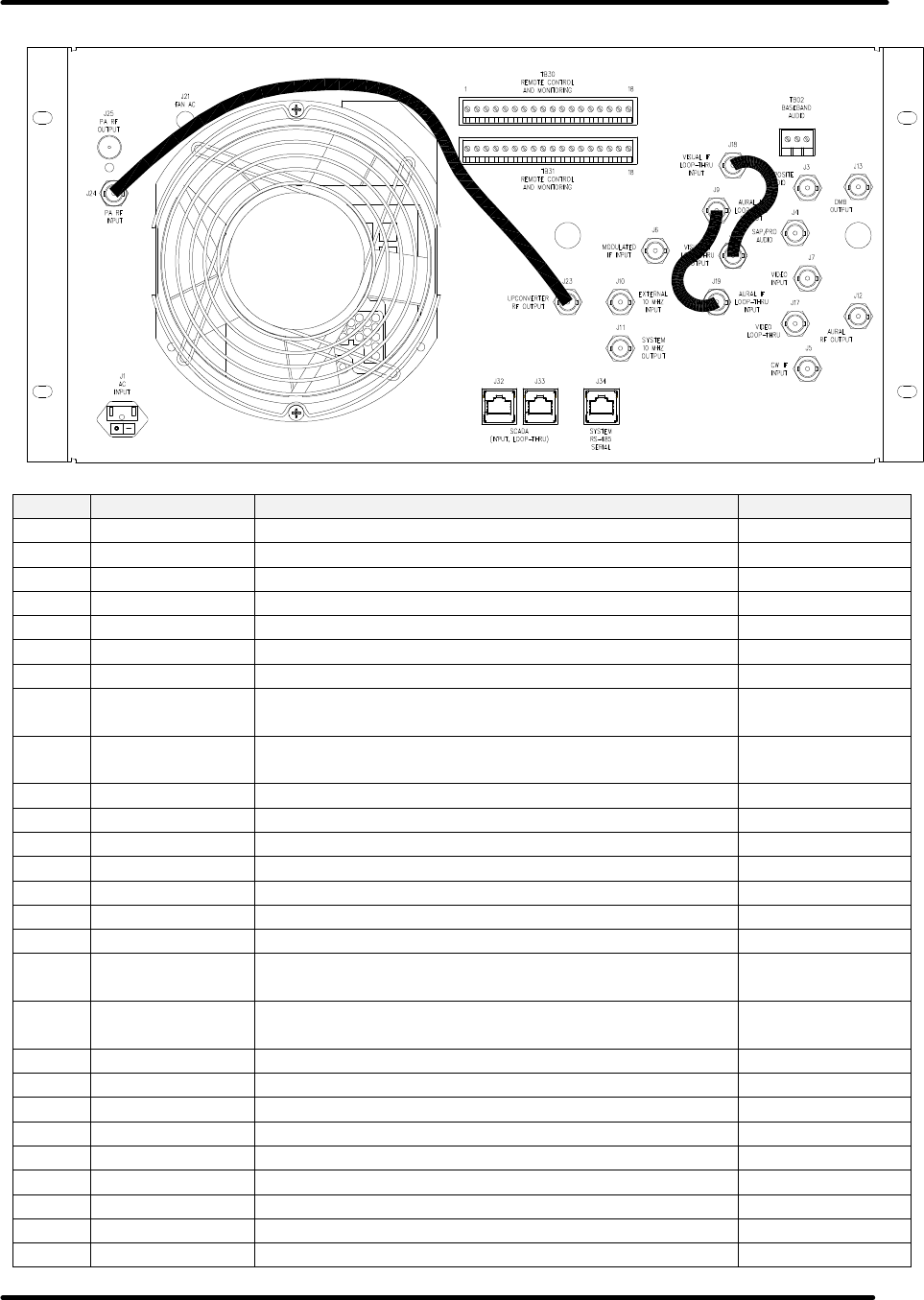
Digital UHF Driver/Transmitter Chapter 3, Site Considerations,
Installation and Setup Procedures
LX Series, Rev. 1 3-8
Figure 3-6: Rear View of the Digital Driver/Amplifier Chassis Assembly
Table 3-2: Rear Chassis Connections for the LX Series Digital Exciter Driver.
Port Type Function Impedance
J1 IEC AC Input N/A
TB02 Term (NOT USED) Base Band Audio Input 600O
J3 BNC (NOT USED) Composite Audio Input 75O
J4 BNC (NOT USED) SAP / PRO Audio Input 50O
J5 BNC (NOT USED) CW IF Input 50O
J6 BNC Modulated IF Input (Cabled from DM8-R) 50O
J7 BNC (NOT USED) Video Input (Isolated) 75O
J8 BNC (NOT USED) Visual IF Loop-Thru Output
(Jumpered to J18) 50O
J9 BNC (NOT USED) Aural IF Loop-Thru Output
(Jumpered to J19) 50O
J10 BNC External 10 MHz Reference Input 50O
J11 BNC System 10 MHz Reference Output 50O
J12 BNC (NOT USED) MPEG RF Input 50O
J13 BNC (NOT USED) DTV IF Output 50O
J14 BNC RF Spare 2 50O
J15 BNC RF Spare 1 50O
J17 BNC (NOT USED) Video Loop-Thru (Isolated) 75O
J18 BNC (NOT USED) Visual IF Loop-Thru Input
(Jumpered to J8) 50O
J19 BNC (NOT USED) Aural IF Loop-Thru Input
(Jumpered to J9) 50O
J23 BNC Upconverter RF Output 50O
J24 BNC Power Amplifier RF Input 50O
J25 N Power Amplifier RF Output 50O
J32 RJ-45 SCADA (Input / Loop-Thru) CAT5
J33 RJ-45 SCADA (Input / Loop-Thru) CAT5
J34 RJ-45 System RS-485 Serial CAT5
TB30
Termination Remote Control & Monitoring N/A
TB31
Termination Remote Control & Monitoring N/A
J1
J24
J25
J21
TB30
TB31
J32
J34
J33
J10
J23
J6
J5
J19
J18
TB02
J13
J4
J7
J17
J8
J9
J12
J3
J15
J14
J11

Digital UHF Driver/Transmitter Chapter 3, Site Considerations,
Installation and Setup Procedures
LX Series, Rev. 1 3-9
3.5.2: Initial Turn On
Once the transmitter has been installed
and all connections have been made, the
process of turning on the equipment can
begin. First, verify that AC power is
present and connected to the
transmitter. Verify all cables are properly
connected and are the correct type.
Once these checks are completed, the
unit is ready to be turned on using the
following procedures.
Turn on the main AC power source that
supplies the AC to the transmitter. Check
that the AC power plug is connected to
the AC Input jack on the back of the
assembly and that the On/Off circuit
breaker located on the rear chassis is
On. Also check that the On/Off circuit
breakers located on the rear of the
Power Amplifier Assemblies are On and
that the DM8-R tray is plugged in and
the circuit breaker located on the rear
panel is On.
3.5.2.1: DM8-R Digital Modulator
Tray LEDs on Front Panel
Status Indicators:
POWER: This illuminates Green if the DC
power supply is operating.
MPEG: This illuminates Green if the
MPEG stream at the J1-2B input jack is
valid.
PLL A: This illuminates Green if the DM8
symbol clock is locked to the frequency
of the 10 MHz reference.
PLL B: This illuminates Green if the pilot
frequency is locked to the 10 MHz
reference.
3.5.2.2: IF Processor Module LEDs on
Front Panel
Fault Indicators:
INPUT FAULT: This illuminates Red if the
input to the module is missing or low.
ALC FAULT: This illuminates RED when
the needed ALC value to maintain the
output level is beyond the range of the
circuitry.
MUTE: This indicator will illuminate Red
when the transmitter is muted.
3.5.2.3 LO/Upconverter Module LED
on Front Panel
Fault Indicator:
AGC CUTBACK: This illuminates Red if
the required gain to produce the desired
output level is beyond the value set by
the AGC Cutback circuit.
3.5.2.4: Controller Module LEDs on
Front Panel
Status Indicators:
OPERATE - This illuminates Green when
transmitter is in operate.
FAULT - This illuminates Red when a
fault has occurred in the transmitter.
DC OK - This illuminates Green when the
DC outputs that connect to the modules
in the transmitter are present.
3.5.2.5: Driver Power Amplifier
Module LEDs on Front Panel
NOTE: Both the PA Module and Driver
Module have the same front panel LEDs.
Status Indicators:
ENABLED - This illuminates Green when
the PA is in operate.
DC OK - This illuminates Green when the
DC inputs to the PA module are present.
TEMP - This illuminates Green when the
temperature of the heatsink in the PA is
below 78°C.
MOD OK - This illuminates Green when
the PA module is operating and has no
faults.
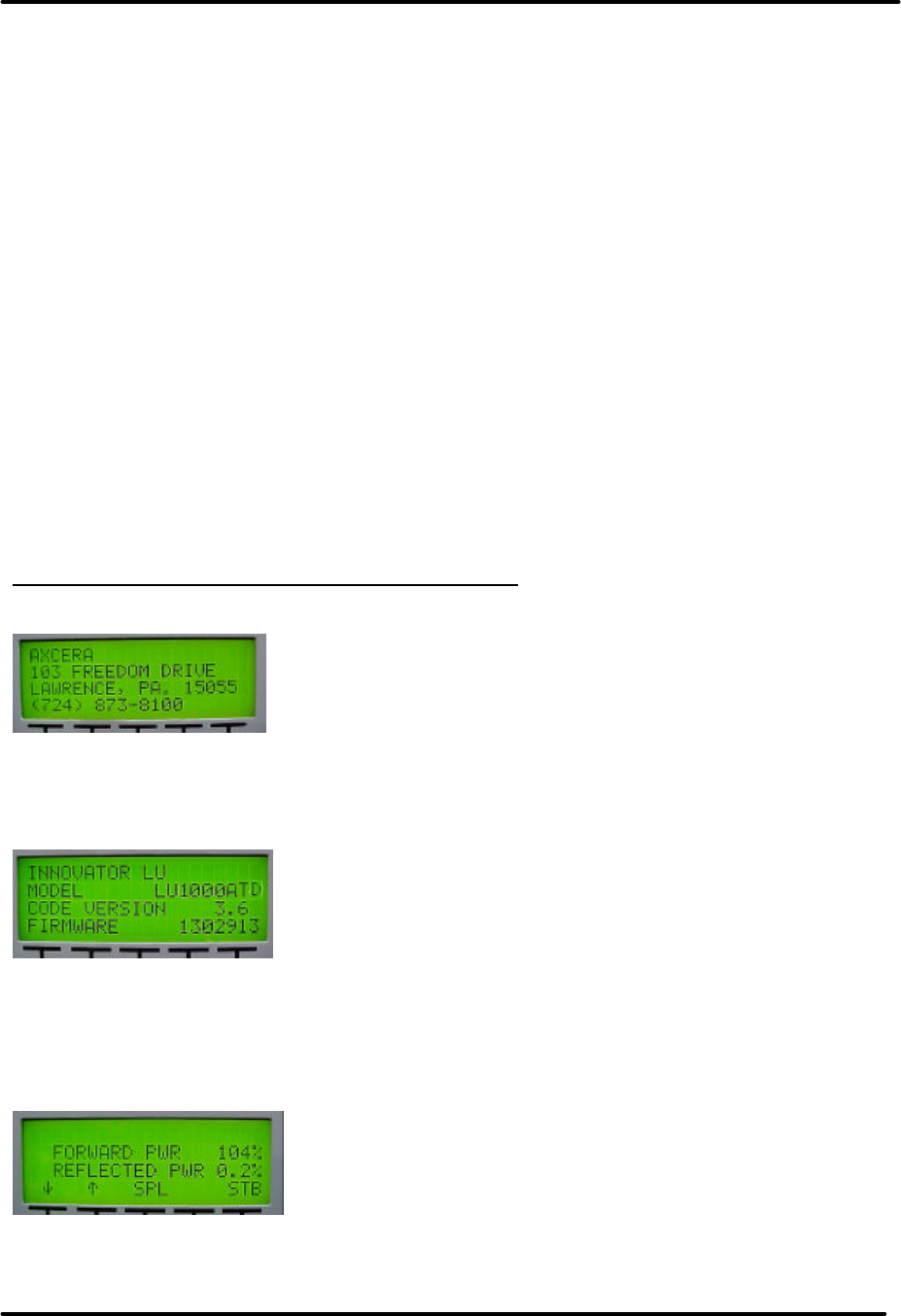
Digital UHF Driver/Transmitter Chapter 3, Site Considerations,
Installation and Setup Procedures
LX Series, Rev. 1 3-10
If the Module OK LED is Red and blinking
a fault is present. The meaning of the
blinking LED is as follows.
1 Blink: Indicates Amplifier Current
Fault.
2 Blinks: Indicate Temperature Fault.
3 Blinks: Indicate +32V Power Supply
Over Voltage Fault.
4 Blinks: Indicate +32V Power Supply
Under Voltage Fault.
5 Blinks: Indicate Reflected Power Fault.
6 Blinks: Indicate +12V or –12V Power
Supply Fault
If the Module OK LED is Amber and
blinking, it indicates the power output of
the amplifier has dropped below 65%.
(NOTE: Only in Amplifier Code Versions
3.7A or later and System Controller Code
Versions 3.9C or later.).
3.5.3: Front Panel Screens for the
Driver/Amplifier Chassis Assembly
A 4 x 20 display located on the front of
the Control & Monitoring/Power Supply
Module is used in the LX Series exciter
for control of the operation and display
of the operating parameters of the
transmitter. Below are the display
screens for the system. The ↑ and ↓
characters are special characters used to
navigate up or down through the menu
screens. Display text flashes on discrete
fault conditions for all screens that
display a fault condition. When the
transmitter is in operate mode, the STB
menu appears. When the transmitter is
in standby mode, the OPR menu
appears. NOTE: The following screens
are typical and may be different from the
screens in your system.
Display Menu Screens for the LX Series Exciter
Table 3-3: Menu 01 - Splash Screen #1
This is the first of the two transmitter splash screens that is shown for the first few
seconds after reset or after pushing the SPL button on the Main Screen. Will
automatically switch to the second splash screen.
Table 3-4: Menu 02- Splash Screen #2
This is the second of the two transmitter splash screens. Will automatically switch to the
Main Screen. The Model Number, Code Version Number and Firmware Number for your
system are displayed on this screen. Make note of these two numbers when conferring
with Axcera on software problems.
Table 3-5: Menu 10 - Main Screen:
This is the default main screen of the transmitter. When the transmitter is in
operate, the 'STB' characters appear, allowing an operator to place the transmitter in
STANDBY, by pushing the right most button located under to display. When the
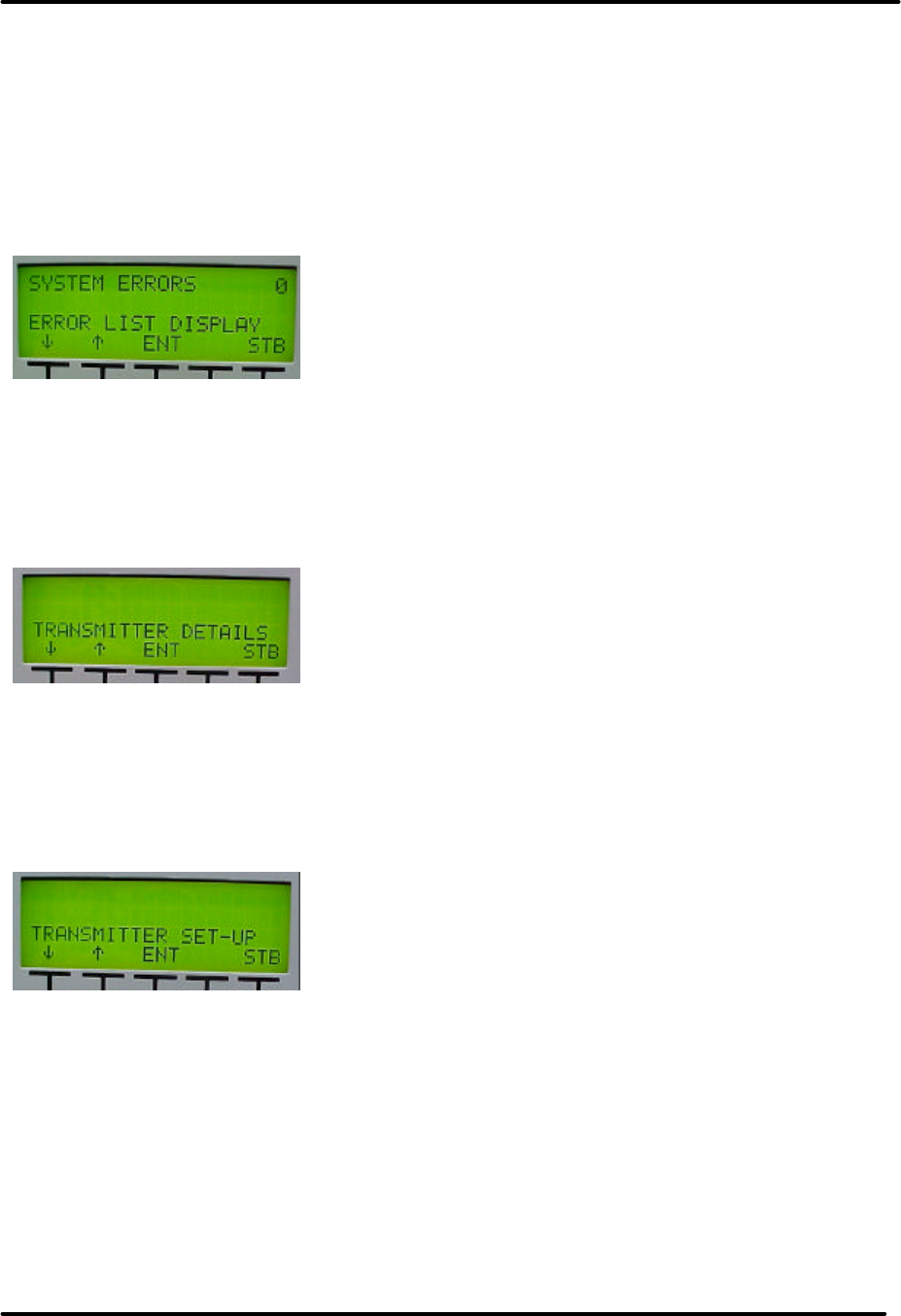
Digital UHF Driver/Transmitter Chapter 3, Site Considerations,
Installation and Setup Procedures
LX Series, Rev. 1 3-11
transmitter is in standby the 'STB' characters are replaced with 'OPR' and the forward
power values are displayed as OFF. An operator can change the transmitter from
STANDBY to OPERATE by pressing the right most button on the front panel display. If the
transmitter is in operate mode but off due to a modulation fault, the display reports the
system power as Auto Off. Pushing the SPL button will display the two splash screens.
If the ↓ key is activated the display changes to Menu 11, the System Error List Access
Screen. If the ↑ key is activated the display changes to Menu 13, the Transmitter
Configurations Access Screen.
Table 3-6: Menu 11 - Error List Access Screen
This screen of the transmitter shows the current number of errors, displayed in upper,
right of screen (0), and provides operator access to view Menu 20, the error list screens,
by pushing the ENT button. When ENT is pushed, Menu 20, the Error List Display Screen
is displayed. See Table 3-9 below. If the ↓ key is pushed the display changes to Menu 12,
Table 3-7, the Transmitter Device Data Access Screen. If the ↑ key is activated the
display returns to Menu 10, the Main Screen.
Table 3-7: Menu 12 - Transmitter Device Data Access Screen
This screen of the transmitter allows access to various parameters of the transmitter
system. This is the entry point to Menu 30, the System Details Screens, by pausing the
ENT button. When the ENT button is pushed, Menu 30 is accessed. Go to Menu 30, Table
3-20 for set up details. Before pushing the ENT button: if the ↓ key is activated the
display changes to Menu 13, Transmitter Configurations Access Screen. If the ↑ key is
activated the display returns to Menu 11, the Error List Access Screen.
Table 3-8: Menu 13 - Transmitter Configuration Access Screen
This screen of the transmitter allows access to various software settings of the
transmitter system. If ENT is pushed, go to Menu 40, Table 3-13, the access to
transmitter configuration and set up. Before pushing the ENT button: if the ↓ key is
activated the display returns to Menu 10, Main Screen. If the ↑ key is activated the
display returns to Menu 12, the Transmitter Device Data Access Screen.
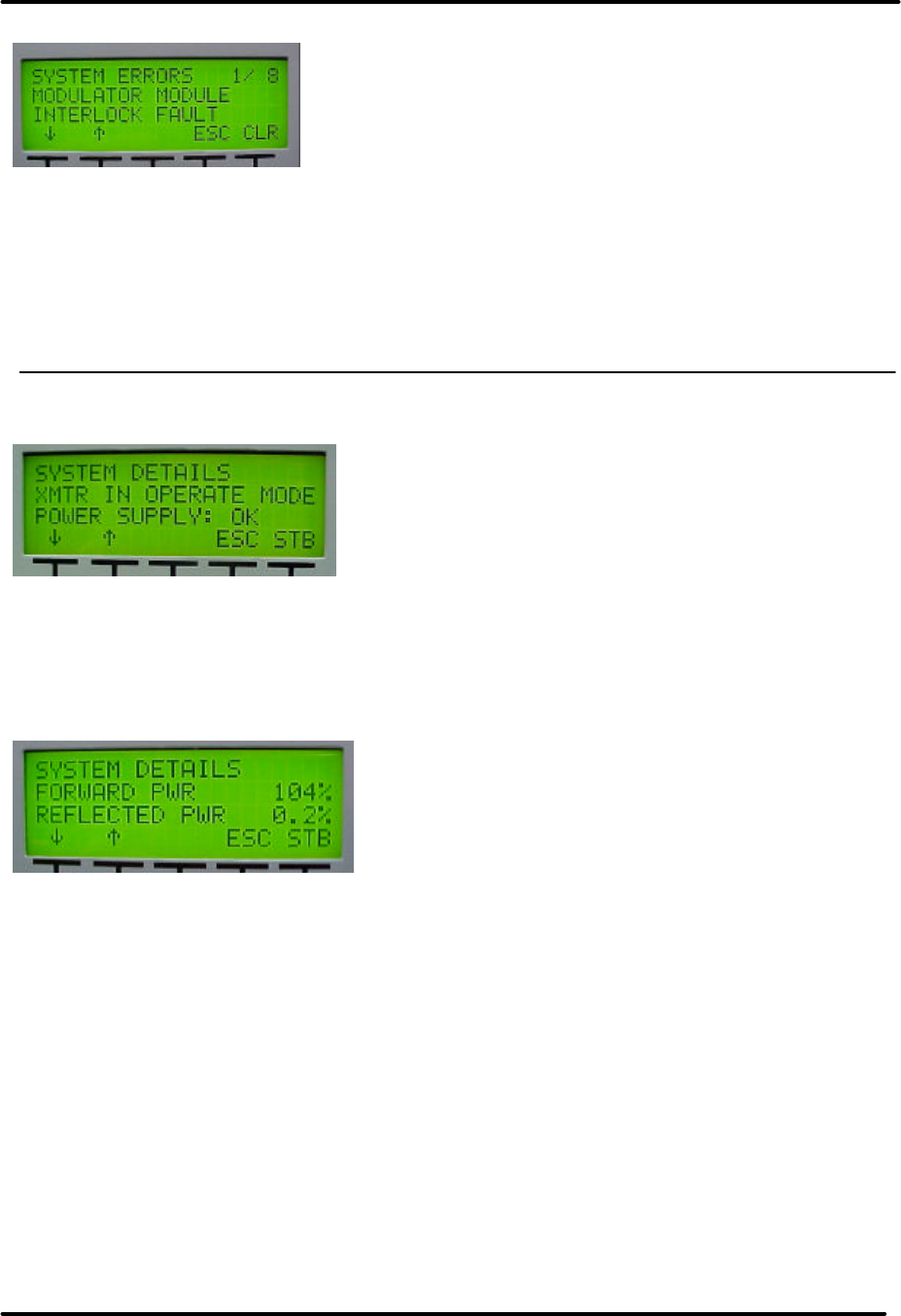
Digital UHF Driver/Transmitter Chapter 3, Site Considerations,
Installation and Setup Procedures
LX Series, Rev. 1 3-12
Table 3-9: Menu 20 - Error List Display Screen
This screen indicates System Errors 1/8, which is System Error 1 screen of 8 total System
Errors that have occurred. Fault logging is stored in non-volatile memory. The
transmitter's operating state can not be changed in this screen. The 'CLR' switch is used
to clear the displayed previously detected fault that is no longer active. If the fault is still
present it will not clear. The ↑ key and ↓ key allow an operator to scroll through the list of
errors that have occurred. The ESC button is used to leave this screen and return to
Menu 11, Table 3-6, the Error List Access Screen. NOTE: Shown is an example of a
typical screen and may be different for your system.
Menu 30 is entered by selecting ENT at Menu 12, Table 3-17.
Table 3-10: Menu 30 - Transmitter Device Details Screen
This screen allows access to the transmitter parameters of installed devices. The system
is configured to know which devices are present. Current values for all installed devices
are shown. If a module is not installed, only a "MODULE NOT PRESENT" message will be
displayed. The first screen displayed is Menu 30-1, Table 3-11, the System Details
Screen.
Table 3-11: Menu 30-1 – System Details Screen
This is the default System Details Screen. The ↓ and ↑ arrows allow you to scroll through
the different parameters of each device as shown in Table 3-12. Each System
Component is a different screen.
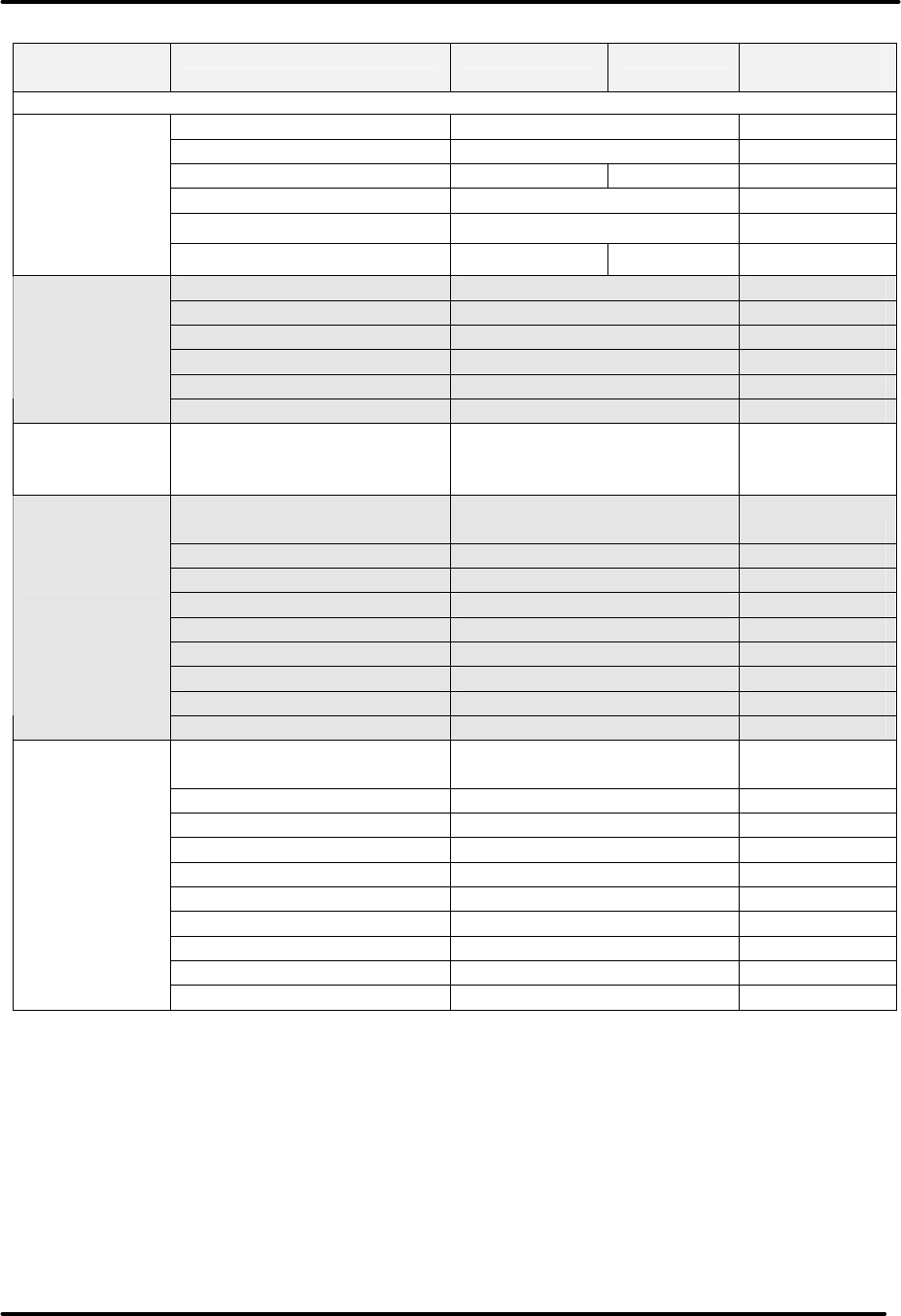
Digital UHF Driver/Transmitter Chapter 3, Site Considerations,
Installation and Setup Procedures
LX Series, Rev. 1 3-13
Table 3-12: Transmitter Device Parameters Detail Screens
System
Component Parameter Normal Choice Faulted
(Blinking)
INPUT SIGNAL STATE OK FAULT
MODULATION OK FAULT
INPUT IF MODULATOR J6 N/A
DLC CONTROL LOCK 0 - 5.00 V N/A
ALC LEVEL 0 - 5.00 V N/A
IF Processor
Details
ALC MODE AUTO MANUAL N/A
PLL CIRCUIT LOCKED FAULT
AFC LEVEL 0 - 5.00 V N/A
AGC 1 LEVEL 0 - 5.00 V N/A
AGC 2 LEVEL 0 - 5.00 V N/A
EX. 10 MHz PRESENT or NOT USED N/A
Upconverter
Details
LO FREQ xxx.xxx MHz N/A
System
Control
Details SUPPLY ENABLED FOR xxx HOURS N/A
POWER SUPPLY STATE,
32V 32 VDC N/A
±12V SUPPLY OK or OFF FAULT
FORWARD POWER xxx% xxx%
REFLECTED POWER xxx% xxx%
AMP 1 CURRENT xx.xA xx.xA
AMP 2 CURRENT xx.xA xx.xA
TEMPERATURE xxC xxC
CODE VERSION x.x N/A
Driver PA
Details
PA HAS OPERATED FOR xxx HOURS N/A
POWER SUPPLY VOLTAGE,
32V 31 – 32 VDC N/A
32V SUPPLY ENABLED or DISABLED FAULT
FORWARD POWER xxx% xxx%
REFLECTED POWER xxx% xxx%
AMP CURRENT 1 xx.xA xx.xA
AMP CURRENT 2 xx.xA xx.xA
AMP CURRENT 3 xx.xA xx.xA
AMP TEMPERATURE xxC xxC
CODE VERSION x.x N/A
Ext. Power
Amplifier
Modules
Details.
Will indicate
Amp Set and
Module within
the Set. Will
step through
each Set and
Module. PA HAS OPERATED FOR xxx HOURS N/A
Pushing the ↓ Down Arrow, after scrolling through all the detail screens, will put you back
to Menu 30, Table 3-10. Push the ESC button to exit the Transmitter Device Parameter
Screens to Menu 12, Table 3-7 to the Transmitter Device Parameter Access Screen.
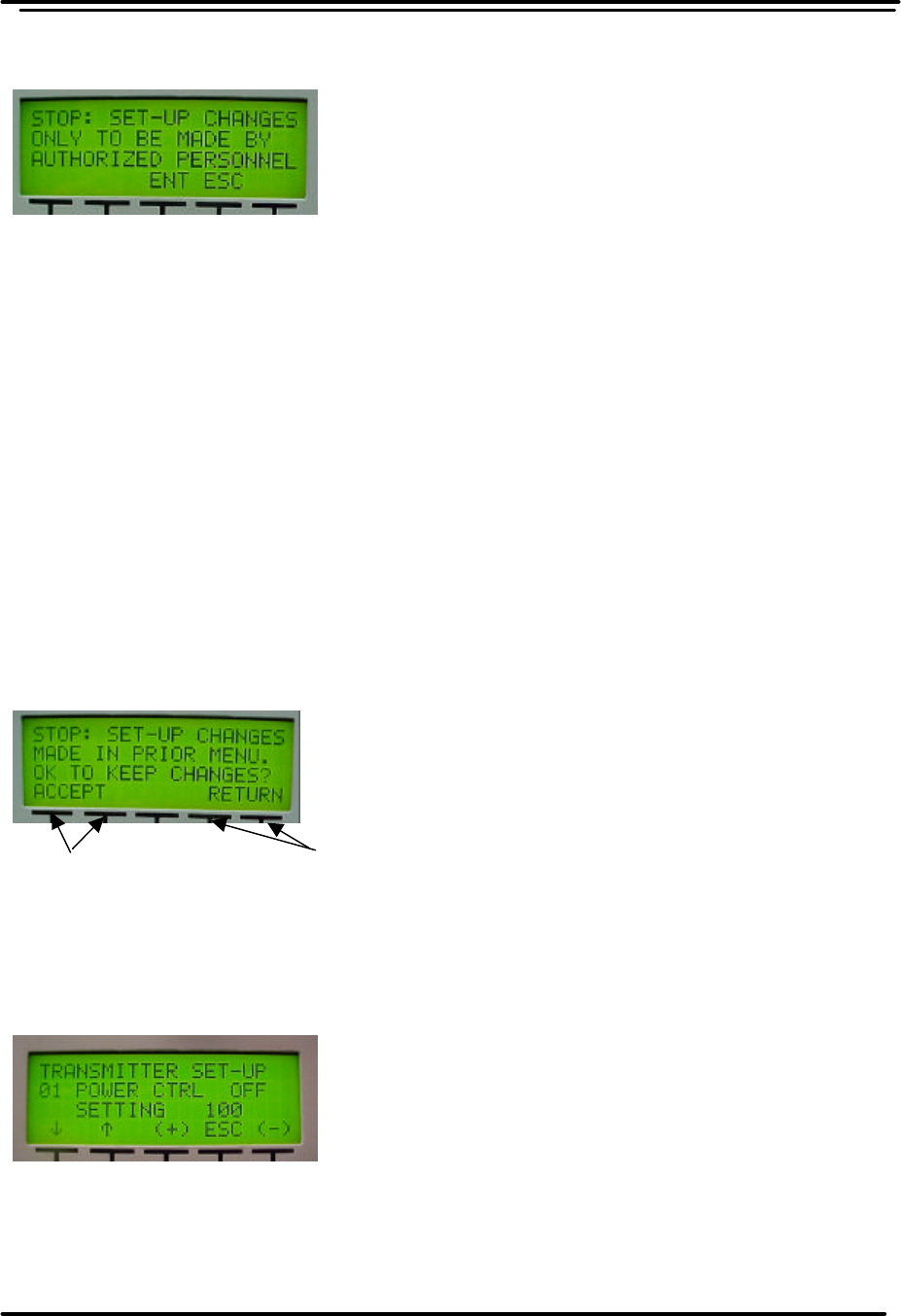
Digital UHF Driver/Transmitter Chapter 3, Site Considerations,
Installation and Setup Procedures
LX Series, Rev. 1 3-14
Menu 40 (Table 3-13) is entered by selecting ENT at Menu 13.
Table 3-13: Menu 40 - Authorized Personnel Screen
This screen of the transmitter notifies an operator that they are only to proceed if they
are authorized to make changes to the transmitter's operation. Changes made within the
following set-up screens can affect the transmitters output power level, output frequency,
and the general behavior of the transmitter. Please do not make changes within the
transmitter's set-up screens unless you are familiar with the operation of the transmitter.
Pressing ENT will put you into the Transmitter Set Up Screens for Menu 40.
A safeguard is added to the Set Up Menus in software version 2.5 and above. If a change
is made to a screen within the Set Up Menus, when you go to the next menu, a new
screen asks if you accept the change or want to return to the previous menu to
reconsider the changes made.
To accept the changes, the two buttons located under ACCEPT must be pushed
simultaneously.
To return to the previous Menu to make corrections, the two buttons located under the
RETURN must be pushed simultaneously. Upon returning to the previous Menu the
correct input must be entered and the above procedure repeated, this time accepting the
changes
Accept or Return to previous Menu Screen
Pushing these two buttons Pushing these two buttons
Simultaneously will accept Simultaneously will return you
the change. to the previous Menu.
The Set Up Screens are shown in Table 3-14 Menu 40-1 through Table 3-34 Menu 40-19
that follow.
Table 3-14: Menu 40-1 - Transmitter Set-up: Power Control Screen
This screen of the transmitter is the first of several that allows access to transmitter set-
up parameters. When + is selected, the Power will increase. When - is selected, the
Power will decrease.
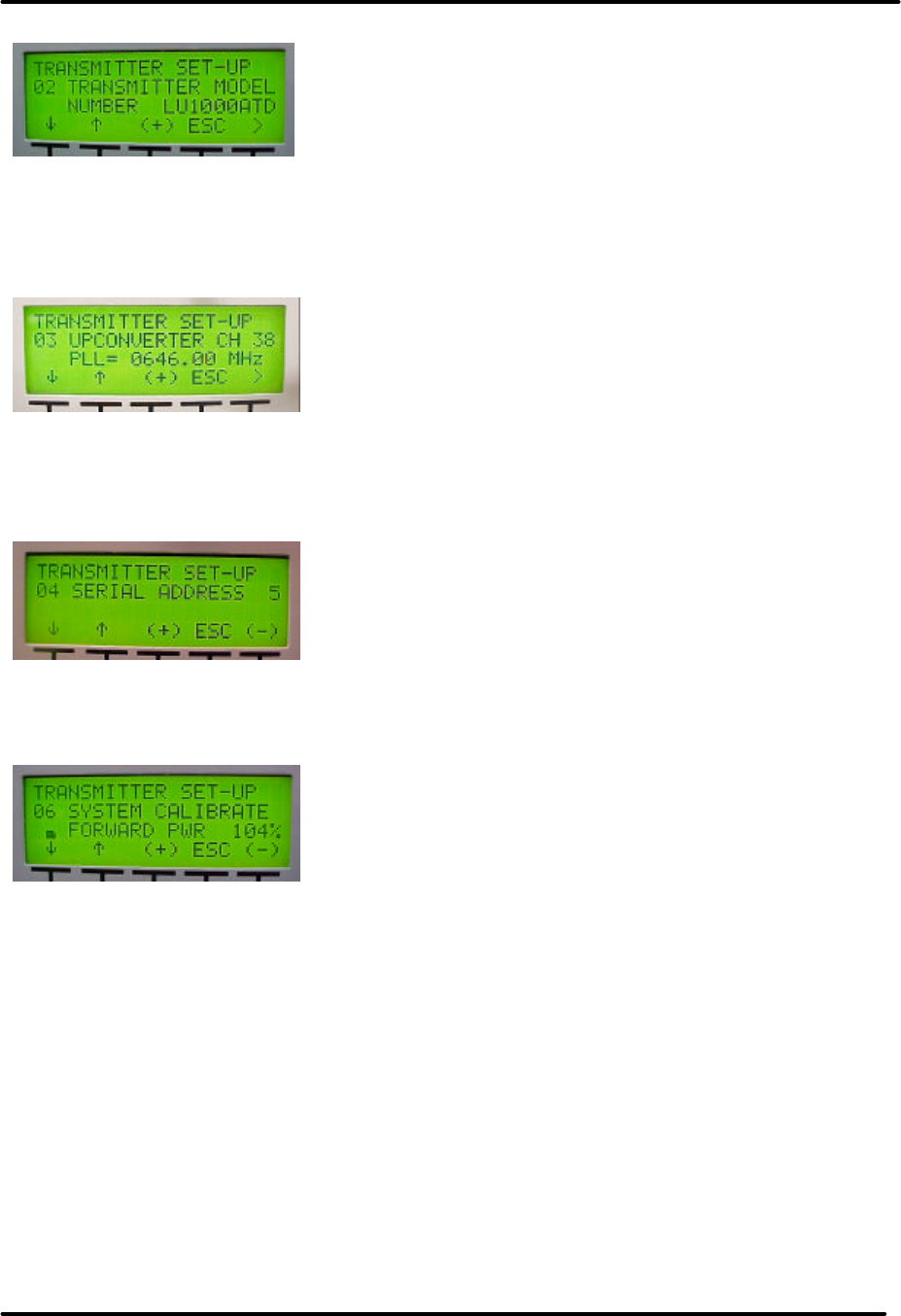
Digital UHF Driver/Transmitter Chapter 3, Site Considerations,
Installation and Setup Procedures
LX Series, Rev. 1 3-15
Table 3-15: Menu 40-2 - Transmitter Set-up: Model Select Screen
This screen is used to specify which components are expected to be part of the system.
By specifying the model number, the transmitter control firmware knows which
components should be installed and it will be able to display faults for components that
are not properly responding to system commands.
Table 3-16: Menu 40-3 - Transmitter Set-up: Upconverter Channel Select Screen
The choices of this screen are to the standard UHF / VHF channels. The + and – buttons
change the desired channel of the transmitter. The PLL frequency is set for custom
Offsets within the Upconverter frequency. Any change to the channel is immediately set
to the LO / Upconverter Frequency Synthesizer PLL circuit.
Table 3-17: Menu 40-4 - Transmitter Set-up: Serial Address Screen
This screen allows the user to set the serial address of the transmitter. The default
address is 5. This value and all other set-up parameters are stored in non-volatile
memory.
Table 3-18: Menu 40-6 - Transmitter Set-up: System Forward Power Calibration
This screen is used to adjust the calibration of the system's forward power. A symbol
placed under the '6' character indicates changes in the calibration value. When the
calibration value is at full value, the character will be full black. As the value decreases,
the character pixels are gradually turned off. The calibration value is a value between 0
and 255 but the calibration value symbol only has 40 pixels. Therefore small changes in
actual calibration value may not affect the symbol's appearance.
(NOTE: Menu 40-5 is not used)
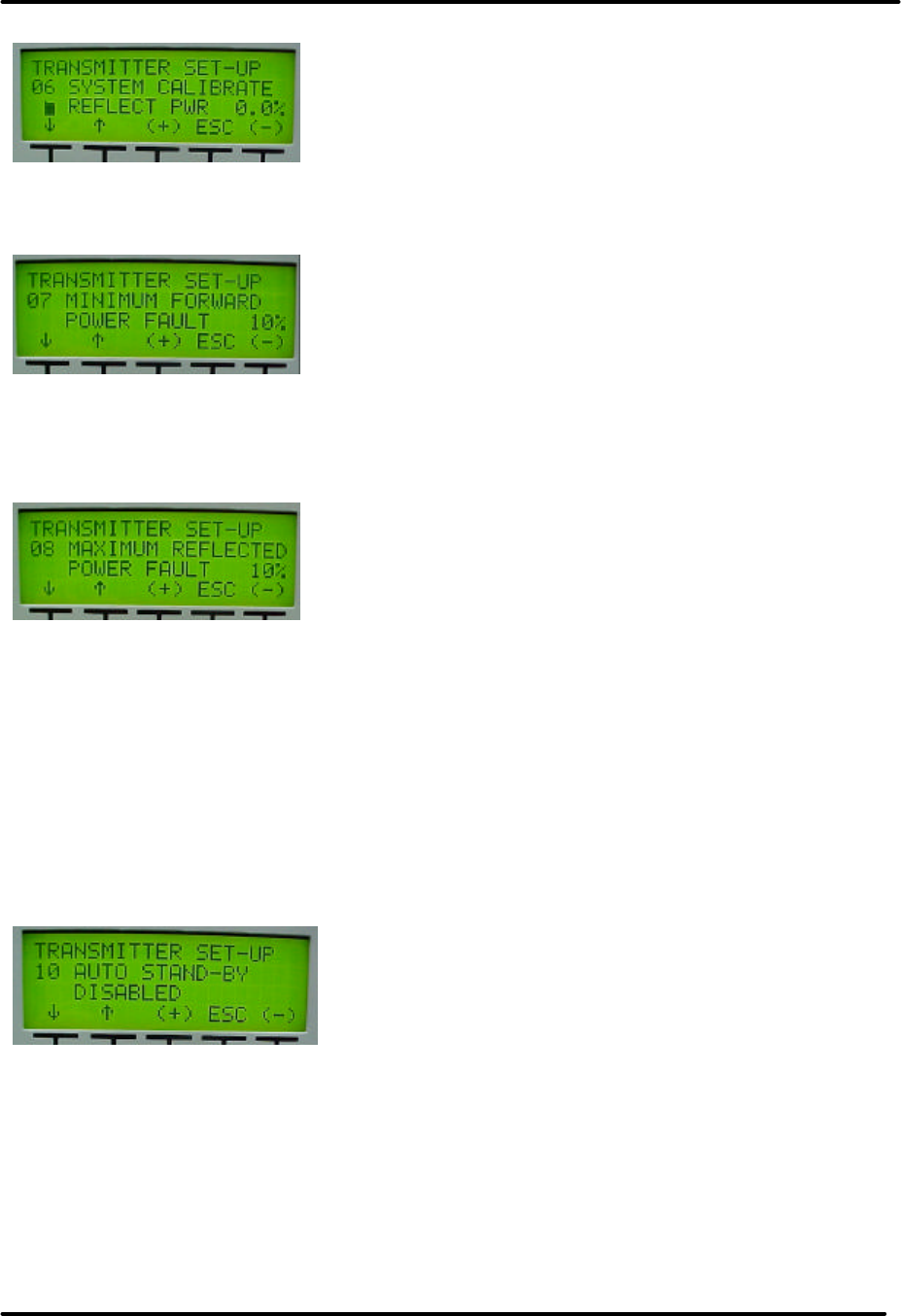
Digital UHF Driver/Transmitter Chapter 3, Site Considerations,
Installation and Setup Procedures
LX Series, Rev. 1 3-16
Table 3-19: Menu 40-6 - Transmitter Set-up: System Reflected Power Calibration
This screen is used to adjust the calibration of the system's reflected power. A calibration
value symbol is also used for this screen as on the previous screens.
Table 3-20: Menu 40-7 - Transmitter Set-up: Forward Power Fault Threshold Screen
This screen is used to set the minimum forward power fault threshold. When the
transmitter is operating, it must operate above this value otherwise the system will shut
down with fault for 5 minutes. If after five minutes the fault is not fixed, the transmitter
will enable, measure power less than this value and again shut down for five minutes.
Table 3-21: Menu 40-8 - Transmitter Set-up: Reflected Power Fault Threshold
This screen is used to set the maximum reflected power fault threshold. When the
transmitter is operating, it must not operate above this value otherwise the system will
slowly begin to reduce the forward output power. If the system's reflected output power
exceeds the maximum reflected power threshold by five percent or more, the transmitter
will shut down with fault for 5 minutes. If after five minutes the fault is not fixed, the
transmitter will enable, measure power above this value plus five percent and again shut
down for five minutes. If the system's reflected output power exceeds the maximum
reflected power threshold due to some condition like the formation of ice on an antenna,
the transmitter reduces forward power to a level where the reflected power is less than
this threshold. The transmitter will automatically increase its output power to normal
operation when the cause of higher than normal reflected power is corrected.
Table 3-22: Menu 40-10 - Transmitter Set-up: Auto Stand-By Control
Certain LX transmitter locations are required to reduce the output power to zero on the
loss of video input. When a LX transmitter is configured for Auto Stand-By On
Modulation Loss, the transmitter will switch to stand-by, if a modulated input signal fault
is detected by the IF Processor module and it lasts for more than ten seconds. Once the
modulated input signal fault is cleared, a transmitter in operate mode will return to
normal operation. This feature is implemented in transmitter software version 1.4 and
above. (NOTE: Menu 4-9 is not used in this configuration)
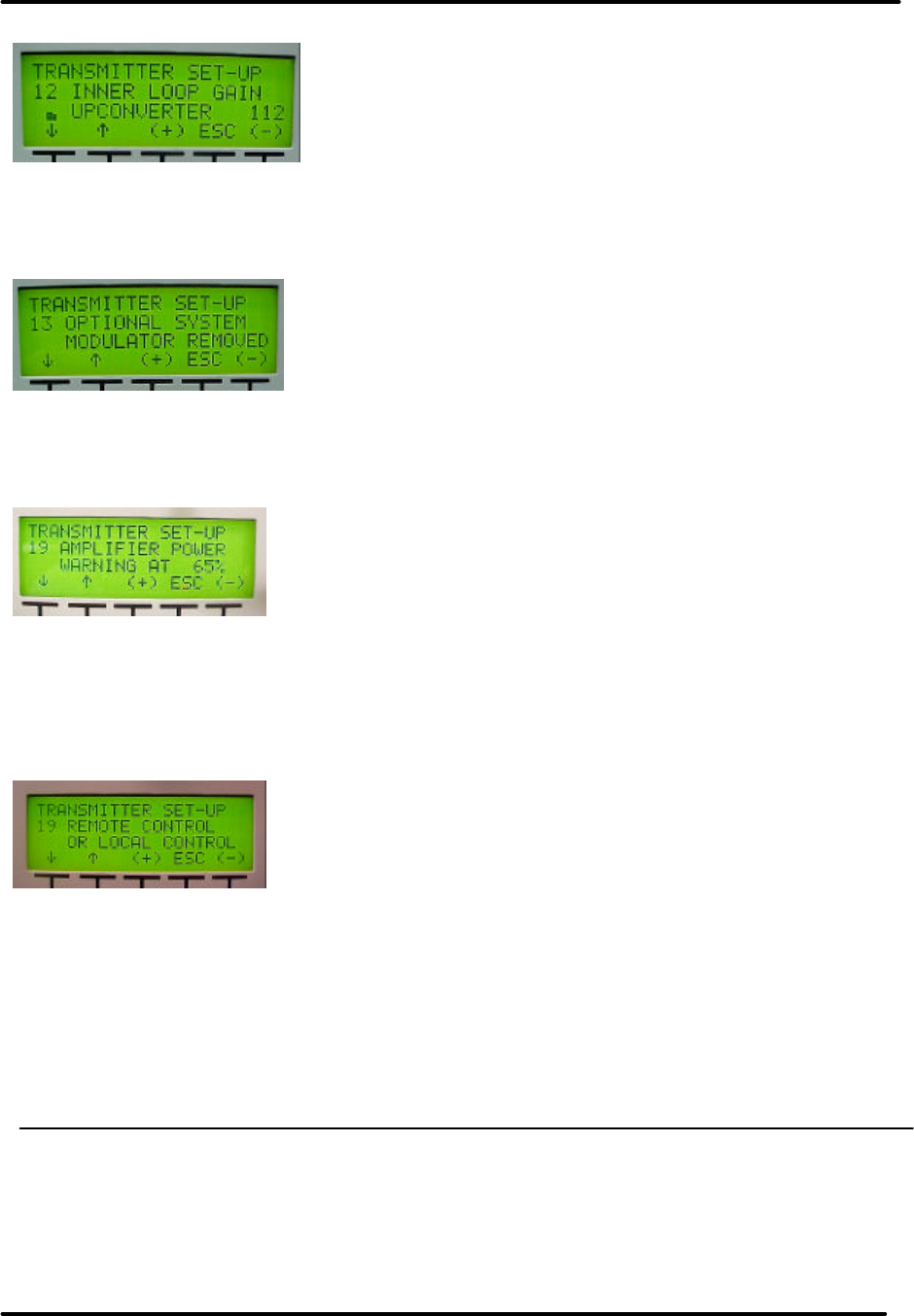
Digital UHF Driver/Transmitter Chapter 3, Site Considerations,
Installation and Setup Procedures
LX Series, Rev. 1 3-17
Table 3-23: Menu 40-12 - Transmitter Set-up: Inner Loop Gain Control
This screen is used to set up the Inner Loop Gain of the exciter/amplifier assembly. This
feature is implemented in transmitter software version 2.0 and above.
(NOTE: Menu 40-11 is not used)
Table 3-24: Menu 40-13 - Transmitter Set-up: Optional System Control
This screen is used to set up any optional system, including the addition of the optional
Modulator in a translator system. This feature is implemented in transmitter software
version 2.0 and above.
Table 3-25: Menu 40-19 - Transmitter Set-up: Amplifier Output Power Warning
This screen is used to set up the Amplifier Output Power level at which a warning will be
sent out if the power output of the amplifier drops below this setting. The warning
indication is the blinking of the Module OK LED colored Amber, located on the front of the
amplifier module. (NOTE: Only in Amplifier Code Versions 3.7A or later and System
Controller Code Versions 3.9C or later.)
Table 3-26: Menu 40-19 - Transmitter Set-up: Remote Commands Control
This screen is used to allow or deny the use of remote control commands. When
disabled, remote commands are not used. Remote commands are commands received
either through the rear terminal blocks or through serial messages.
Push the ESC button to exit the Transmitter Set Up Screens to Menu 13, Table 3-8, the
Transmitter Configuration Access Screen.
This completes the description of the menu screens for the LX Series exciter/amplifier
chassis assembly.
3.5.4: Operation Procedure
If necessary, connect to the transmitter
to the antenna. Check that the output is
100% and if needed adjust the ALC Gain
adjust pot on the front panel of the IF
Processor to attain 100%. The power
raise / lower settings, in the menus, are
only to be used for temporary reductions
in power.

Digital UHF Driver/Transmitter Chapter 3, Site Considerations,
Installation and Setup Procedures
LX Series, Rev. 1 3-18
The power set-back values do not directly
correspond to the output power of the
transmitter.
This completes the Installation, Set Up
and Turn On of the Driver/Transmitter.
If a problem occurred during the setup
and operation procedures, refer to
Chapter 5, Detailed Alignment
Procedures, of this manual for more
information.

Digital UHF Driver/Transmitter Chapter 4, Circuit Descriptions
LX Series, Rev. 1 4-1
Chapter 4:
Circuit Descriptions
NOTE: Information and drawings on
the DM8-R Digital Modulator Tray
are found in the DM8-R Manual.
4.1: (A3) IF Processor Module
Assembly (1301938; Appendix B)
The IF from the DM8 modulator enters
the module and the signal is pre-
corrected as needed for amplitude
linearity correction, Incidental Carrier
Phase Modulation (ICPM) correction and
frequency response correction.
The Module contains the following board.
4.1.1: IF Processor Board (1301977;
Appendix B)
The automatic level control (ALC) portion
of the board provides the ALC and
amplitude linearity correction of the IF
signal. The ALC adjusts the level of the IF
signal that controls the output power of
the transmitter.
The IF from the DM8 modulator enters
the board at J42B pin 32B. If the
(optional) receiver tray is present, the IF
input (-6 dBm) from the DM8 modulator
connects to the DM8 modulated IF input
jack J42C Pin 21C. The DM8 modulated
IF input connects to relay K3 and the
receiver IF input connects to relay K4.
The two relays are controlled by the
Modulator Select command that is
connected to
J42C Pin 14C on the board. Modulator
select enable/disable jumper W11 on J29
controls whether the Modulator Select
command at J42C Pin 14C controls the
operation of the relays. With jumper W11
on J29 between pins 1 and 2, the
Modulator Select command at J42C Pin
14C controls the operation of the relays;
with jumper W11 on J29, pins 2 and 3,
the modulator is selected all of the time.
4.1.1.1: DM8 Modulator Selected
With the modulator selected, J42C-14C
low, this shuts off Q12 and causes Pin 8
on the relays to go high that causes
relays K3 and K4 to de-energize. When
K4 is de-energized, it connects the
receiver IF input at J42C-21C, if present,
to a 50O load. When K3 is de-energized,
it connects the modulator IF input at
J42B-32B to the rest of the board;
Modulator Enable LED DS5 will be
illuminated.
4.1.1.2: External Modulated IF Selected
With the External Modulated IF selected,
J42C-14C high, this turns on Q12 and
makes pin 8 on the relays low that
causes the relays K3 and K4 to energize.
When K4 is energized, it connects the
receiver IF input at J42C-21C, if present,
to the rest of the board. When K3 is
energized, it connects to the modulator
IF input at J42B-32B to a 50O load. The
Modulator Enable LED DS5 will not be
illuminated.
4.1.1.3: Main IF Signal Path (Part 1 of 3)
The selected IF input (-6 dBm average)
signal is split, with one half of the signal
entering a bandpass filter that consists of
L3, L4, C4, L5, and L6. This bandpass
filter can be tuned with C4 and is
substantially broader than the IF signal
bandwidth. It is used to slightly steer the
frequency response of the IF to make up
for any small discrepancies in the
frequency response in the stages that
precede this point. The filter also serves
the additional function of rejecting
unwanted frequencies that may occur if
the tray cover is off and the tray is in a
high RF environment. (If this is the case,
the transmitter will have to be serviced
with the tray cover off in spite of the
presence of other RF signals). The
filtered IF signal is fed through a pi-type

Digital UHF Driver/Transmitter Chapter 4, Circuit Descriptions
LX Series, Rev. 1 4-2
matching pad consisting of R2, R3, and
R4 to the pin-diode attenuator circuit
consisting of CR1, CR2, and CR3.
4.1.1.4: Input Level Detector Circuit
The other part of the split IF input is
connected through L2 and C44 to U7. U7
is an IC amplifier that is the input to the
input level detector circuit. The amplified
IF is fed to T4, which is a step-up
transformer that feeds diode detector
CR14. The positive-going detected signal
is then low-pass filtered by C49, L18, and
C50. This allows only the positive digital
peaks to be applied through emitter
follower Q1. The signal is then connected
to detector CR15 to produce a peak
digital voltage that is applied to op-amp
U9A. There is a test point at TP3 that
provides a voltage-reference check of the
input level. The detector serves the dual
function of providing a reference that
determines the input IF signal level to
the board and also serves as an input
threshold detector.
The input threshold detector prevents the
automatic level control from reducing the
attenuation of the pin-diode attenuator to
minimum, the maximum signal output, if
the IF input to the board is removed. The
ALC, input loss cutback, and the
threshold detector circuits will only
operate when jumper W2 on jack J5 is in
the Enabled position, between pins 2 and
3. Without the threshold detector, and
with the pin-diode attenuator at
minimum, the signal will overdrive the
stages following this board when the
input is restored.
As part of the threshold detector
operation, the minimum IF input level at
TP3 is fed through detector CR15 to op-
amp IC U9A, pin 2. The reference voltage
for the op-amp is determined by the
voltage divider that consists of R50 and
R51, off the +12 VDC line. When the
detected input signal level at U9A, pin 2,
falls below this reference threshold,
approximately 10 dB below the normal
input level, the output of U9A at pin 1
goes high, toward the +12 VDC rail. This
high is connected to the base of Q2 that
is forward biased and creates a current
path. This path runs from the -12 VDC
line and through red LED DS1, the input
level fault indicator, which lights, resistor
R54, and transistor Q2 to +12 VDC. The
high from U9A also connects through
diode CR16 and R52, to U24D pin 12,
whose output at pin 14 goes high. The
high connects through the front panel
accessible ALC Gain pot R284 and the full
power set pot R252 to U24C Pin 9. This
high causes U24C pin 8 to go low. A
power raise/lower input from the
Control/Monitoring Module connects to
J42C pin 24C and is wired to Q14. This
input will increase or decrease the value
of the low applied to U24B and therefore
increase or decrease the power output of
the transmitter.
The low connects to U24B pin 5 whose
output goes low. The low is wired to
U24A pin2 whose output goes high. The
high is applied to U10A, pin 2, whose
output goes low. The low connects
through the switch SW1, if it is in the
auto gain position, to the pin-diode
attenuator circuit, CR1, CR2 & CR3. The
low reverse biases them and cuts back
the IF level, therefore the output level, to
0. When the input signal level increases
above the threshold level, the output
power will increase, as the input level
increases, until normal output power is
reached.
The digital input level at TP3 is also fed
to a pulse detector circuit, consisting of
IC U8, CR17, Q3, and associated
components, and then to a comparator
circuit made up of U9C and U9D. The
reference voltage for the comparators is
determined by a voltage divider
consisting of R243, R65, R66, and R130,
off the -12 VDC line. When the input
signal level to the detector at TP3 falls
below this reference threshold, which
acts as a loss-of-digital peak detector
circuit, the output of U9C and U9D goes
towards the -12 VDC rail and is split, with
one part biasing on transistor Q5. A
current path is then established from the
+12 VDC line through Q5, the resistors

Digital UHF Driver/Transmitter Chapter 4, Circuit Descriptions
LX Series, Rev. 1 4-3
R69 and R137, and the red LED DS3,
input loss indicator, which is illuminated.
When Q5 is on, it applies a high to the
gate of Q6. This causes it to conduct and
apply a modulation loss pull-down output
to J42C pin 7C, which is applied to the
front panel display on the
Control/Monitor module.
The other low output of U9C and U9D is
connected through CR18, CR19 & CR20
to jack J5. Jumper W2 on J5, in the
Cutback Enable position, which is
between pins 2 and 3, connects the low
to the base of Q4 that is now forward-
biased. NOTE: If jumper W2 is in the
Disable position, between pins 1 and 2,
the auto cutback will not operate. With
Q4 biased on, a negative level
determined by the setting of cutback
level pot R71 is applied to U24D pin 12.
The level is set at the factory to cut back
the output to approximately 25%. The
output of U24D at pin 14 goes low and is
applied through the power adjust pot to
U24C, pin 9, whose output goes low.
The low connects to U24B, pin 5, whose
output goes low. The low then connects
to U24A, pin 2, whose output goes high.
The high is applied to U10A, pin 2, whose
output goes low. The low connects
through the switch SW1, if it is in the
auto gain position, to the to the pin-diode
attenuator circuit, CR1, CR2 & CR3. The
low reverse biases them and cuts back
the level of the output to approximately
25%.
4.1.1.5: Pin-Diode Attenuator Circuit
The input IF signal is fed to a pin-diode
attenuator circuit that consists of CR1,
CR2 & CR3. Each of the pin diodes
contains a wide intrinsic region; this
makes the diodes function as voltage-
variable resistors at this intermediate
frequency. The value of the resistance is
controlled by the DC bias supplied to the
diode. The pin diodes are configured in a
pi-type attenuator configuration where
CR1 is the first shunt element, CR3 is the
series element, and CR2 is the second
shunt element. The control voltage,
which can be measured at TP1, originates
either from the ALC circuit when the
switch SW1 is in the ALC Auto position,
between pins 2 and 3, or from pot R87
when SW1 is in the Manual Gain position,
between pins 1 and 2.
In the pin diode attenuator circuit,
changing the amount of current through
the diodes by forward biasing them
changes the IF output level of the board.
There are two extremes of attenuation
ranges for the pin-diode attenuators. In
the minimum attenuation case, the
voltage, measured at TP1, approaches
the +12 VDC line. There is a current path
created through R6, through series diode
CR3, and finally through R9 to ground.
This path forward biases CR3 and causes
it to act as a relatively low-value resistor.
In addition, the larger current flow
increases the voltage drop across R9 that
tends to turn off diodes CR1 and CR2 and
causes them to act as high-value
resistors. In this case, the shunt
elements act as a high resistance and the
series element acts as a low resistance to
represent the minimum loss condition of
the attenuator (maximum signal output).
The other extreme case occurs as the
voltage at TP1 is reduced and goes
towards ground or even slightly negative.
This tends to turn off (reverse bias) diode
CR3, the series element, causing it to act
as a high-value resistor. An existing fixed
current path from the +12 VDC line, and
through R5, CR1, CR2, and R9, biases
series element CR3 off and shunt
elements, diodes CR1 and CR2, on,
causing them to act as relatively low-
value resistors. This represents the
maximum attenuation case of the pin
attenuator (minimum signal output). By
controlling the value of the voltage
applied to the pin diodes, the IF signal
level is maintained at the set level.
4.1.1.6: Main IF Signal Path (Part 2 of 3)
When the IF signal passes out of the pin-
diode attenuator through C11, it is
applied to modular amplifier U1. This
device contains the biasing and
impedance-matching circuits that makes

Digital UHF Driver/Transmitter Chapter 4, Circuit Descriptions
LX Series, Rev. 1 4-4
it operate as a wide-band IF amplifier.
The output of U1 connects to J40 that is
jumpered to J41. The J40 jack is
available, as a sample of the pre-
correction IF for troubleshooting
purposes and system setup. The IF signal
is connector to a splitter Z1 that has an
in phase output and a 90° Quadrature
output, which are then connected to the
linearity corrector portion of the board.
4.1.1.7: Amplitude and Phase
Pre-Correction Circuits
The linearity corrector circuits use three
stages of correction, two adjust for any
amplitude non-linearities and one for
phase non-linearities of the output signal.
Two of the stages are in the in phase
amplitude pre-correction path and one
stage is in the quadrature phase pre-
correction path. Each stage has a
variable threshold control adjustment,
R211 and R216, in the in phase path,
and R231, in the quadrature path, that
determines the point at which the gain is
changed for that stage.
Two reference voltages are needed for
the operation of the corrector circuits.
The Zener diode VR3, through R261,
provides the +6.8 VDC reference. The
VREF is produced using the path through
R265 and the diodes CR30 and CR31.
They provide a .9 VDC reference, which
temperature compensates for the two
diodes in each corrector stage.
The first corrector stage in the in phase
path operates as follows. The in phase IF
signal is applied to transformer T6, which
doubles the voltage swing by means of a
1:4 impedance transformation. Resistors
R222 and R225 form an L-pad that
lowers the level of the signal. The input
signal level when it reaches a certain
level causes the diodes CR24 and CR25
to turn on, generating current flow that
puts them in parallel with the L-pad.
When the diodes are put in parallel with
the resistors, the attenuation through the
L-pad is lowered, causing signal stretch.
The signal is next applied to amplifier
U17 to compensate for the loss through
the L-pad. The breakpoint, or cut-in
point, for the first corrector is set by
controlling where CR24 and CR25 turn
on. This is accomplished by adjusting the
threshold cut-in resistor R211. R211
forms a voltage-divider network from
+6.8 VDC to ground. The voltage at the
wiper arm of R211 is buffered by the
unity-gain amplifier U16B. This reference
voltage is then applied to R215, R216,
and C134 through L44 to the CR24 diode.
C134 keeps the reference from sagging
during the vertical interval. The .9 VDC
reference voltage is applied to the unity-
gain amplifier U16D. The reference
voltage is then connected to diode CR25
through choke L45. The two chokes L44
and L45 form a high impedance for RF
that serves to isolate the op-amp ICs
from the IF.
After the signal is amplified by U17, it is
applied to the second corrector stage in
the in phase path through T7. These two
correctors and the third corrector stage
in the quadrature path operate in the
same fashion as the first. All three
corrector stages are independent and do
not interact with each other.
The correctors can be disabled by moving
jumper W12 on J30 to the Disable
position, between pins 1 and 2, which
moves all of the breakpoints past the
greatest peaks of digital so that they will
have no affect.
The pre-distorted IF signal in the in
phase path, connects to an op amp U18
whose output level is controlled by R238.
R238 provides a means of balancing the
level of the amplitude pre-distorted IF
signal that then connects to the combiner
Z2. The pre-distorted IF signal in the
quadrature path connects to op amp U20
and then step up transformer T9, next op
amp U21 and step up transformer T10
and finally op amp U22 whose output
level is controlled by R258. R258
provides a means of balancing the level
of the Phase pre-distorted IF signal that
then connects to the combiner Z2.

Digital UHF Driver/Transmitter Chapter 4, Circuit Descriptions
LX Series, Rev. 1 4-5
The amplitude and phase pre-distorted IF
signals are combined by Z2 and
connected to J37 that is jumpered to J36
on the board. J37 can be used for
testing or monitoring purposes of the IF
signal after amplitude and phase pre-
distortion. The pre-distorted IF signal
connects through a resistor buffer
network that prevents loading of the
combiner before it is wired to the
frequency response circuitry.
4.1.1.8: Main IF Signal Path (Part 3 of 3)
The IF signal, at the input to the
frequency-response corrector circuit, is
split, using L24, L25 and R89. One path
is through L24, which is the main IF path
through the board. The main IF is fed
through a resistor network that controls
the level of the IF by adjusting the
resistance of R99, the output level
adjust. The IF signal is then applied to a
three-stage, frequency-response
corrector circuit that is adjusted as
needed.
The frequency-response corrector circuit
operates as follows. Variable resistors
R103, R106 and R274 are used to adjust
the depth and gain of the notches and
variable caps C71, C72 and C171 are
used to adjust the frequency position of
the notches. These are adjusted as
needed to compensate for frequency
response problems.
The frequency-response corrected IF is
connected to J38 that is jumpered to J39
on the board. J38 can be used for
testing or monitoring purposes of the IF
signal after frequency response
pre-correction. The IF is next amplified
by U13 and U14. After amplification, the
IF is split with one path connected to
J42C pin 1C the IF output to the
LO/Upconverter Module. The other path
is fed through a divider network to J35 a
SMA IF Sample Jack, located on the front
panel that provides a sample of the
corrected IF for test purposes.
4.1.1.9: ALC Circuit
The other path of the corrected IF signal
at the input to the frequency response
corrector circuit is used in the ALC circuit.
The IF flows through L25, of the L24 L25
splitter, and connects to the op-amp
U12. The IF signal is applied through a
resistor divider network to transformer
T5. T5 doubles the voltage swing by
means of a 1:4 impedance
transformation before it is connected to
the ALC detector circuit, consisting of
C70, CR23 and R91. The detected ALC
level output is amplified by U10B and
wired to U10A, pin 2, where it is summed
with the power control setting, which is
the output power setting that is
maintained by the ALC. The output of
U10A connects through SW1, if it is in
the auto gain position, to the pin-diode
attenuator circuit, CR1, CR2 & CR3. The
high forward biases them more or less,
that increases or decreases the IF level,
therefore the output level, opposite the
input level. When the input signal level
increases, the forward bias on the pin
attenuator decreases, therefore the
output power will decrease, which keeps
the output power the same as set by the
customer.
An external power raise/lower switch can
be used by connecting it to TB30, at
TB30-8 power raise and TB30-9 power
lower, on the rear of the exciter/amplifier
chassis. The ALC voltage is set for .8
VDC at TP4 with a 0-dBm output at J42C
pin 1C of the module. A sample of the
ALC at J42C pin 11C, is wired to the
Control Monitoring/Power Supply module
where it is used on the front panel
display and in the AGC circuits.
The ALC voltage, and the DC level
corresponding to the IF level after signal
correction, are fed to U10A, pin 2, whose
output at pin 1 connects to the ALC pin-
diode attenuator circuit. If there is a loss
of gain somewhere in an IF circuit, the
output power of the transmitter will drop.
The ALC circuit senses this drop at U10A
and automatically decreases the loss
through the pin-diode attenuator circuit

Digital UHF Driver/Transmitter Chapter 4, Circuit Descriptions
LX Series, Rev. 1 4-6
therefore increasing its gain maintaining
the same output power level.
The ALC action starts with the ALC
detector level monitored at TP4. The
detector output at TP4 is nominally +.8
VDC and is applied through resistor R77
to a summing point at op-amp U10A, pin
2. The current available from the ALC
detector is offset, or complemented, by
current taken away from the summing
junction. In normal operation, U10A, pin
2, is at 0 VDC when the loop is satisfied.
If the recovered or peak-detected IF
signal level at IF input to this board
should drop, which normally means that
the output power will decrease, the null
condition would no longer occur at U10A,
pin 2. When the level drops, the output
of U10A, pin 1, will go more positive. If
SW1 is in the Automatic position, it will
cause the ALC pin-diode attenuators CR1,
CR2, and CR3 to have less attenuation
and increase the IF level; this will
compensate for the decrease in the level.
If the ALC cannot increase the input level
enough to satisfy the ALC loop, due to
there not being enough range, an ALC
fault will occur. The fault is generated
because U10D, pin 12, increases above
the trip point set by R84 and R83 until it
conducts. This makes U10D, pin 14, high
and causes the red ALC Fault LED DS2 to
light.
4.1.1.10: Fault Command
The board also has circuitry for an
external mute fault input at J42 pin 10C.
This is a Mute command that protects the
circuits of high-gain output amplifier
devices against VSWR faults. This action
needs to occur faster than just pulling
the ALC reference down. Two different
mechanisms are employed: one is a very
fast-acting circuit to increase the
attenuation of the pin-diode attenuator,
CR1, CR2, and CR3, and the second is
the reference voltage being pulled away
from the ALC amplifier device. An
external Mute is a pull-down applied to
J42 pin 10C, that completes a current
path from the +12 VDC line through R78
and R139, the LED DS4 (Mute indicator),
and the LED section of opto-isolator U11.
These actions turn on the transistor
section of U11 that applies -12 VDC
through CR21 to U10A pin 3, and pulls
down the reference voltage. This is a
fairly slow action controlled by the low-
pass filter function of R81 and C61.
When the transistor section of U11 is on,
-12 VDC is also connected through CR22
directly to the pin-diode attenuator
circuit. This establishes a very fast
muting action, by reverse biasing CR3.
This action occurs in the event of an
external VSWR fault.
4.1.1.11: ±12 VDC Needed to Operate
the Board
The ±12 VDC connects to the board at
J42C. The +12 VDC connects to J42C pin
16C and is filtered by L30, L41, and C80
before it is applied to the rest of the
board. The -12 VDC connects to J42C pin
18C and is filtered by L31 and C81 before
it is applied to the rest of the board.
The +12 VDC also connects through
R261 to the zener diode VR3 that
connects to ground, which generates the
+6.8 VDC output to the rest of the board.
The +12 VDC also connects through
R265 to the diodes CR30 and CR31
provide a .9 VDC reference output
voltage VREF that temperature
compensates for the two diodes in each
corrector stage.
4.2 (A5) LO/Upconverter Module
(1301930; Appendix A)
This module contains the
LO/Upconverter board, the UHF
Generator Board, LED Display Board and
channel filters. This module takes an
external IF and converts it to the final
RF output frequency using an internally
generated local oscillator.
The local oscillator consists of a VCXO
that is phase locked to an external 10
MHz reference. The 10 MHz reference
and the VCO are both divided down to 5
kHz and compared by the phase lock

Digital UHF Driver/Transmitter Chapter 4, Circuit Descriptions
LX Series, Rev. 1 4-7
loop circuit. Any error from this
comparison is generated in the form of
an error current that is converted to a
bias voltage that connects to the VCO.
This voltage adjusts the output
frequency of the VCO until it is on the
desired frequency.
The Phase lock loop is programmed by
loading in data generated by the control
module. This data sets the dividers so
that the 10MHz and the VCXO frequency
are divided to 5kHz. These divide
numbers are loaded into U6 using the
clock, data and LE lines. This data is
sent whenever the module is first
plugged into the backplane board or
when power is applied to the
transmitter. This is necessary because
the divide numbers are lost when power
is removed from the module.
There is an alarm generated if the phase
locked loop is unlocked. This alarm is
displayed locally and is also sent to the
control module in the transmitter to be
displayed as a fault. The bias voltage to
the VCO is also available to be
monitored at TP1 and also can be
viewed on the front panel display of the
Transmitter. Typical values for this
voltage are 0.1 to 0.5V. The 10 MHz
reference is normally an external
reference. There is also a high stability
internal reference option that is
available if there is a desire to operate
the transmitter without an external
reference. Jumper W1 determines
whether an external or internal high
stability reference is to be used.
The IF signal is applied at a level of
–15 dBm average and is converted to
the final RF channel frequency. The RF
signal is applied to a filter that selects
the right conversion product. Next, the
signal is amplified to -7 dBm by A3 and
exits the module at J2. There are also
front panel samples of the RF output at
J3 and the LO at J1. The RF sample
level is approximately -20 dB below the
RF output. The LO sample level is -7
dBm.
4.2.1 (A4) UHF Generator Board
(1585-1265; Appendix A)
The UHF generator board is mounted in
the UHF Generator Enclosure for EMI and
RFI protection. The board contains a
VCXO circuit and additional circuitry to
multiply the VCXO frequency by eight.
The VCXO circuit uses the crystal Y1,
mounted in a crystal oven for stability, to
produce an output of ≈ 67 MHz to 132
MHz, depending on the desired channel
frequency. Course adjustment to the
frequency of the crystal is made by C11,
while fine adjustments are accomplished
by the AFC voltage at J2 from (A1) the
LO/Upconverter board (1302132). The
VCXO output level is adjusted by C6, L2,
L4 and C18. The output is split and
provides an input to the x8 multiplier
circuitry as well as a VHF Output sample
at J1.
The x8 circuitry consists of three identical
x2 broadband frequency doublers. The
input signal at the fundamental frequency
is fed through a 6-dB pad consisting of
R21, R24, and R25 through C29 to
amplifier U3. The output of the amplifier
stage is directed through a bandpass filter
consisting of L8 and C32, which is tuned
to the fundamental frequency (67 MHz to
132 MHz). The voltage measured at TP1
is typically +.6 VDC. The first doubler
stage consists of Z1 with bandpass filter
L9 and C34 tuned to the second harmonic
(134 MHz to 264 MHz). The harmonic is
amplified by U4 and again bandpass
filtered at the second harmonic by C38
and L11 (134 MHz to 264 MHz). The
voltage measured at TP2 is typically +1.2
VDC. The next doubler stage consists of
Z2 with bandpass filter C40 and L12
tuned to the fourth harmonic of the
fundamental frequency (268 MHz to 528
MHz). The fourth harmonic is then
amplified by U5 and fed through another
bandpass filter tuned to the fourth
harmonic consisting of L14 and C44 (268
MHz to 528 MHz). The voltage measured
at TP3 is typically +2.0 VDC. The final
doubler stage consists of Z3 with
bandpass filter C46 and L15 tuned to the

Digital UHF Driver/Transmitter Chapter 4, Circuit Descriptions
LX Series, Rev. 1 4-8
eighth harmonic of the fundamental
frequency (536 MHz to 1056 MHz). The
signal is amplified by U6 and U7 to a
typical value of from +2 to +4 VDC as
measured at TP4. The amplified eighth
harmonic is then fed to the SMA RF
output jack of the board at J3. Typical
output level of the signal is +16 dBm
nominal. This output connects through
A5 a channel filter to the LO/Upconverter
Board.
The DC voltages needed to operate the
UHF generator board are supplied by the
LO/Upconverter Board. The +12 VDC for
the board enters through jack J4-3 and is
filtered by L22 and C54-C58 before being
distributed to the circuits on the board.
The +9 VDC for the board enters through
jack J4-1 and is distributed to the rest of
the board.
4.2.2 (A2 and A5) UHF Filters
(1007-1101; Appendix A)
Both UHF filters are tunable two-section
cavity filters that are typically tuned for
a bandwidth of 6 MHz and have a loss of
-1 dB through the filter.
4.2.3 (A1) LO/Upconverter Board
(1302132; Appendix A)
4.2.3.1 Upconverter portion of the Board
The LO/Upconverter board provides
upconversion processing by mixing the IF
and LO signals in mixer Z1 to produce
the desired RF frequency output. The RF
output is connected through J4 to A5, an
external channel filter, and applied back
to the board at J6. The RF is amplified
and connected to the RF output jack of
the board at J43-25B.
The IF signal (-6 dBm average) enters
the board at J43-2B and is applied
through a matching pad and filter circuit
to the mixer. The pad consists of R6, R2
and R7, which presents a relatively good
source impedance. The IF is then
connected through a voltage divider
network consisting of R3, R4, R8 and
R14. R14 is variable and adjusted to set
the 0 dBm IF input level to the mixer.
The IF in next filtered by L3, C84 and
C83 and connected to pin 5, the I input
of the mixer Z1.
The local oscillator signal (+13 dBm)
from UHF Generator Board, through (A5)
a UHF channel filter, connects to the
board at jack J1, an SMA connector. THE
LO is connected directly to pin 1, the L
input of the mixer Z1.
The frequency of the LO is the sum of the
IF frequency above the required digital
carrier. For instance, in system M, for
digital applications, the LO is the center
frequency of the digital channel added to
the 44-MHz IF frequency. By picking the
local oscillator to be 44 MHz above the
digital carrier, a conversion in frequency
occurs by selecting the difference
product. The difference product, the local
oscillator minus the IF, will be at the
desired digital carrier frequency output.
There will also be other signals present at
the RF output connector J3 at a lower
level. These are the sum conversion
product: the LO and the IF frequencies.
Usually, the output product that is
selected by the tuning of the external
filter is the difference product: the LO
minus the 44-MHz IF.
If a bad reactive load is connected to the
mixer, the LO signal that is fed through it
can be increased because the mixer no
longer serves as a double-balanced
mixer. The mixer has the inherent
property of suppressing signals that may
leak from one input port to any of the
other ports. This property is enhanced
by having inputs and outputs of the
mixer at 50Ω impedance. The RF output
of the mixer connects through a pad
made up of R12, R15, and R17 before it
is wired to the amplifier U2. The RF
signal is amplified by U2, a modular
amplifier, and includes within it biasing
and impedance matching networks that
makes U2 act as a wideband-RF amplifier
device. This amplifier, in a 50Ω system,
has approximately 12 dB of gain. U2 is
powered from the +12 VDC line through

Digital UHF Driver/Transmitter Chapter 4, Circuit Descriptions
LX Series, Rev. 1 4-9
RF decoupling components R24, C14, and
L4. Inductor L4 is a broadband-RF choke
and is resonance free through the UHF
band. The amplified RF connects through
a pad to the SMA RF output jack J4 and
is cabled to (A2) an external channel
filter. The reactive channel filter that is
externally connected to J4 of the board
does not appear as a good 50-Ω load at
all frequencies. The pad, in the output
line of the board, consisting of R20, R18,
and R21 buffers the bad effects of the
reactive filter load and makes it appear
as a 50Ω impedance.
The RF input signal from the external
filter re-enters the board at J6 (-11 to -
17 dBm) and is capacitively coupled to
the pin-diode attenuator circuit consisting
of CR2, CR3, and CR4. The pin-diode
attenuator acts as a voltage-variable
attenuator in which each pin diode
functions as a voltage-variable resistor
that is controlled by the DC bias
connected to the diodes. The pin diodes,
because of a large, intrinsic region,
cannot rectify signals at this RF
frequency; therefore, they only act as a
linear voltage-variable resistor. These
diodes are part of the AGC for the
transmitter.
4.2.3.2 The Automatic Gain Control
(AGC) portion of the Board
The automatic gain control (AGC)
provides automatic gain control for the
power amplifier module(s).
The AGC circuitry attempts to maintain
the ratio between an input reference
proportional to the input power and the
output power of either the
exciter/amplifier PA output, AGC #1,
Inner Loop, or the output of external
power amplifiers, AGC #2, Outer Loop,
farther downstream. NOTE: The AGC
#2 Outer Loop is not used in 5W-50W
digital transmitters.
An ALC reference input is applied to the
board at J43-16A, amplified by U10A,
and sent to the front panel board
through J5-7 where it is connected to a
AGC Manual Gain pot, accessed through
the front panel. A switch AUTO/MAN
AGC is also located on the front panel.
When switched in MAN the MAN GAIN
Pot adjusts the output power level. The
Gain Control voltage is reapplied to the
board at J5-6. The gain control voltage
is summed to the added together inner
and outer loop AGC reference voltage at
U10D.
The AGC output reference from the
exciter/amplifier PA module, AGC #1
INNER LOOP, is applied at J43-14C and
from the external PA module, AGC #2
OUTER LOOP, is applied at J43-15C.
The larger voltage of either the inner or
the outer loop is used to control the AGC
loop. Since the outer loop is not used in
this system, the inner loop controls the
AGC. R82 is adjusted so that the inner
loop voltage at TP7 is larger than the
voltage at TP4 by approximately .1 VDC.
This ensures that the output of the
exciter/amplifier is the reference used
for AGC. In systems that use the outer
loop, that level is adjusted to .1 VDC
above the inner loops reference. This
ensures that the output of the system is
the reference used for AGC. If that
reference drops to the point where it is
smaller than the inner loop reference,
the system switches over to using the
inner loop reference.
The AGC reference that is being used is
buffered by U10C and connected to
U10D. U10D generates an output
voltage that is used to bias the pin
attenuators, CR2, CR3 and CR4, which
sets the gain of the exciter/amplifier.
This Auto AGC circuit can be disabled by
the AGC Auto/Man switch, located on
the front panel, which switches the pin-
attenuator bias to a variable voltage
that is set by the Manual Gain Adjust.
The level-controlled RF signal, from the
pin-diode attenuator circuit, is amplified
by the wideband-hybrid amplifier IC U13
that is configured in the same way as U2.
The RF signal is converted by T1 to a

Digital UHF Driver/Transmitter Chapter 4, Circuit Descriptions
LX Series, Rev. 1 4-10
balanced, dual feed output that is applied
to the push-pull Class A amplifier IC U1.
Capacitors C2 and C5 provide DC
blocking for the input signal to the IC.
The RF outputs of the IC are applied
through C3 and C4, which provide DC
blocking for the output signals. The RF
signals connect to combiner T2 that
combines the RF back to a single-RF
output at a 50Ω impedance. The RF then
enters a coupler stage, which provides a
sample of the RF at J7 (–20dB), the front
panel RF sample jack. The main path
through coupler is to J43 pin 25B, the
Upconverter RF output jack of the
module (+0 to +10 dBm).
4.2.3.3 The PLL and 10-MHz Reference
section of the Board
The PLL and 10-MHz reference portion of
the board utilizes either an external 10
MHz reference or an internally generated
10 MHz as the reference for the PLL
circuit that generates the AFC voltage,
which controls the frequency of the VCXO
on the UHF Generator Board.
The (PLL) phase lock loop circuit,
provides the automatic frequency control
(AFC) voltage, that connects to the
VCXO, located on the UHF generator
board, and maintains the accurate output
frequency of the VCXO. The AFC is
generated by comparing a sample of the
10-MHz reference to a sample of the
VCXO frequency. The PLL uses an
external 10-MHz signal as the reference,
unless it is missing, then an internally
generated 10-MHz signal is used. The
two 10-MHz reference signals are
connected to the K1 relay and the
selected reference connects to the
comparator synthesizer IC U9. The
switching between the two references is
accomplished by the K1 relay. When the
relay is de-energized, it applies the
external 10-MHz reference to U9. The
relay will remain de-energized as long as
an externally generated 10-MHz
reference signal is present and the
Jumper W3 on J10 is placed in the
external position, between Pins 1 & 2.
An alternate 10 MHz reference can be
connected to J11 on the board. The
jumper W3 on J10 must then be moved
to pins 2 & 3, internal, to connect the
alternate 10 MHz to K1. The alternate 10
MHz will then act in the circuit like the
external 10 MHz.
If the external 10-MHz reference is lost,
the relay will energized and the internally
generated 10-MHz reference is then
applied through the K1 relay pin 14 to
pin 1 to the IC U9.
With the relay de-energized, the
externally generated 10-MHz from jack
J43 pin 22B connects through the
normally closed contacts of the relay
from pin 1 to pin 7 to the IC U9.
4.2.3.4 External 10-MHz Reference
Present Circuitry
The external 10-MHz reference signal
enters the board at J43 pin 22B and is
isolated by L8 and connected to the
External/Internal Jack J10. W3 on J10 is
a manual jumper that must be connected
between pins 1 & 2, External, for the
external 10 MHz to connect to the rest of
the circuit. The external 10 MHz is
filtered by C44, R55, L9 and C46 before it
split with one path connected to the K1
relay at pin 1 of the normally closed
contacts. The other path takes the 10
MHz and rectifies it by CR5 and filters it
before it is connected to U7A pin 2. If
the sample level of the external 10 MHz
is above the reference set by R46 and
R48, which is connected to pin 3 of U7A,
the output of U7A stays low. The low
connects to the gates of Q3, Q5 and Q6,
which are biased off and cause their
drains to go high. The high from the
drain of Q6 is wired to J43, pin 14A, for
connection to a remote external 10-MHz
present indicator. The high from the
drain of Q5 connects to the yellow LED
DS2, internal reference indictor, which
will not light. This indicates that an
external 10-MHz reference is present.
The low from U7A also connects to the
gate of Q3, biasing it off and causing its
drain to go high. This high de-energizes
the K1 relay and applies the external 10-

Digital UHF Driver/Transmitter Chapter 4, Circuit Descriptions
LX Series, Rev. 1 4-11
MHz reference signal to pin 6 on U9 for
use as the reference in the PLL circuits.
4.2.3.5 Internal 10-MHz Reference
Circuitry
The internally generated 10-MHz
reference signal connects from U6, the
10-MHz oscillator IC, to pin 14, the
Normally Open contacts of relay K1.
With no external 10-MHz reference input,
the level connected to U7A Pin 2 will be
low. This will be less than the reference
set by R46 and R48, which is connected
to pin 3 of U7A that causes the output of
U7A to go high. The high connects to the
gates of Q3, Q5 and Q6, which are biased
on and causes their drains to go low. The
low from the drain of Q6 is wired to J43,
pin 14A, for connection to a remote
external 10-MHz present indicator. The
low from the drain of Q5 connects to the
yellow LED DS2, internal reference
indictor, which will light. This indicates
that an external 10-MHz reference is not
present and that the internal 10-MHz is
being used as the reference. The high
from U7A also connects to the gate of
Q3, biasing it on and causing its drain to
go low. This low energizes the K1 relay
and applies the internal 10-MHz
reference signal through K1 pin 14 to pin
7 to pin 6 on U9 for use as the reference
in the PLL circuits.
4.2.3.6 Selected 10-MHz Reference
Samples
A sample of the selected 10-MHz is split
off the main path through L13 and R95
using L14 and C74 and C73. The sample
path connects to another splitter circuit
consisting of L2, R94, L11, C71 and C70.
One output of the splitter connects to J43
pin 28B that is used by the external
digital modulator tray. The other output
of the splitter connects to J43 pin 31B
that is used by the external analog
modulator tray.
4.2.3.7 Comparator Phase Lock Loop
Circuit
The selected 10-MHz reference connects
to pin 6, Oscillator In, of the IC U9. The
LO generated by the VCXO located on the
UHF Generator Board connects to J1 on
the LO/Upconverter Board. A sample of
the LO is divided off the main line by
R105, R106 and R107. The LO sample
connects to pin 4, F In, of U9.
The U9 IC takes the 10 MHz reference
and divides it down to 5 kHz. It also
takes the LO sample input and divides it
down to 50 kHz. The two 5 kHz divided
down signals are compared inside of U9
and any differences are connected to U9
pin 16. The output of U9 at pin 16 are 5
kHz pulses whose pulse width varies as
any differences between the 10-MHz and
VCXO frequencies are detected. These
pulses are changed to a DC voltage level
by the capacitor-resistor filter network,
C32, C36, C42, C38 and R49. The AFC
voltage is then connected to the + input
of U4B that amplifies it and connects it to
jack J9. W2 on J9 must be in the operate
position, between pins 1 and 2, for the
PLL circuit to operate. With jumper W2
between pins 2 and 3 on J6, set up, the
AFC bias is set by R43. NOTE: With the
VCXO, located on the UHF Generator
Board, set on frequency, the voltage as
measured at TP2 should be –2 VDC.
The AFC output of J9 is split with one
path connected to J43 pin 13A. The
other path is amplified by U7B and
connected to J12, VCXO AFC Output, on
the board that connects to the VCXO on
the UHF generator board. The PLL circuit,
when locked, will maintain the very
accurate VCXO output frequency because
any change in frequency will be corrected
by the AFC error voltage.
4.2.3.8 Lock Detector Circuit
IC chip U9 contains an internal lock
detector that indicates the status of the
PLL circuit. When U9 is in a locked state,
pin 12 goes high; the high is applied to
Q1, which is biased off. With Q1 off, pin

Digital UHF Driver/Transmitter Chapter 4, Circuit Descriptions
LX Series, Rev. 1 4-12
3 goes low and is connected to DS1, the
Red Unlock LED, which does not lit. Q1
pin 3 low also connects to Q2 that is
biased off. The drain of Q2, a high, is
wired to J43 pin 15A, the PLL Lock
Indicator output of the board.
If the 5 kHz from the 10-MHz reference
and the 5 kHz from the VCXO become
unlocked, out of the capture range of the
PLL, pin 12 of U9 goes to a logic low that
connects to the base of Q1. This biases
On Q1 causing pin 3 to go high. The high
connects to DS1, the red Unlock LED,
which lights, and to Q2, which is biased
on. When Q2 is biased on, it connects a
low to jack J43 pin 15A, the PLL Lock
Indicator output of the board.
4.2.3.9 Voltage Requirements
The board is powered by ±12 VDC that is
produced by an external power supply.
+12 VDC enters the board through J43
pins 18A, B & C, and is filtered and
isolated by L5, L6 and the shunt
capacitor C24. The +12 VDC is then
applied to the rest of the board and to
J14 pin 3 for use by the UHF Generator
Board.
One connection of the +12 VDC is to IC
U12. U12 and associated circuitry
produce a +9 VDC that connects to J14
pin 1 for use by the UHF Generator
Board.
Another connection of the +12 VDC is to
a +5 VDC regulator. The +12 VDC
connects to diodes CR6 and CR7 that
along with the pi type filter consisting of
C56, L10, C54 and C55 removes any
noise from the +12 VDC before it
connects to the +5 VDC regulator IC U8.
The output of the IC U8, +5 VDC,
connects to the rest of the board.
The -12 VDC enters the board through
J43 pins 19A, B & C and is filtered and
isolated by L7 and the shunt capacitor
C28. The -12 VDC is then applied to the
rest of the board and to J14 pin 5 for use
by the UHF Generator Board.
4.3 (A4) Control Monitoring/Power
Supply Module, 220 VAC
(1303229; Appendix A)
The Control Monitoring/Power Supply
Module Assembly contains (A1) a Power
Protection Board (1302837), (A2) a 600
Watt Switching Power Supply, (A3) a
Control Board (1302021), (A4) a Switch
Board (1527-1406) and (A5) a LCD
Display.
AC Input to LX Series Exciter/Amplifier
Chassis Assembly
The AC input to the LX Series
Exciter/Amplifier Chassis Assembly is
connected from J1, part of a fused entry
module, located on the rear of the
chassis assembly to J50 on the Control
Monitoring/Power Supply Module. J50-10
is line #1 input, J50-8 is earth ground
and J50-9 is line #2 input. The input AC
connects to J1 on the Power Protection
Board where it is fuse protected and
connected back to J50, at J50-11 AC Line
#1 and J50-12 AC Line #2, for
distribution to the cooling Fan.
4.3.1: (A1) Power Protection Board
(1302837; Appendix A)
The input AC connects through J1 to two
10 Amp AC fuses F1 and F2. The AC
line #1 input connects from J1-1 to the
F1 fuse. The AC line #1 input after the
F1 fuse is split with one line connected
back to Jack J1 Pin 4, which becomes
the AC Line #1 to the Fan. The other
line of the split connects to J4. The AC
line #2 input connects from J1-3 to the
F2 fuse. The AC line #2 input, after the
F2 fuse, is split with one line connected
back to Jack J1 at Pin 5, which becomes
the AC Line #2 to the Fan. The other
line of the split connects to J2. J1-2 is
the earth ground input for the AC and
connects to J3.
Three 150-VAC, for 115 VAC input, or
three 275-VAC, for 230 VAC input, MOVs
are connected to the input AC for
protection. One connects from each AC
line to ground and one connects across

Digital UHF Driver/Transmitter Chapter 4, Circuit Descriptions
LX Series, Rev. 1 4-13
the two lines. VR1 connects from J4 to
J2, VR2 connects from J4 to J3 and VR3
connects from J2 to J3.
+12 VDC Circuits
+12 VDC from the Switching Power
Supply Assembly connects to J6 on the
board. The +12 VDC is divided into four
separate circuits each with a 3 amp self
resetting fuse, PS3, PS4, PS5 and PS6.
The polyswitch resettable fuses may
open on a current as low as 2.43 Amps
at 50°C, 3 Amps at 25°C or 3.3 Amps at
0°C. They definitely will open when the
current is 4.86 Amps at 50°C, 6 Amps
at 25°C or 6.6 Amps at 0°C.
PS3 protects the +12 VDC 2 Amp
circuits for the System Controller, the
Amplifier Controller and the Spare Slot
through J62 pins 7, 8, 9 and 10. If this
circuit is operational, the Green LED
DS3, mounted on the board, will be lit.
PS4 protects the +12 VDC 2 Amp
circuits for the Modulator and the IF
Processor through J62 pins 13, 14, 15
and 16. If this circuit is operational, the
Green LED DS4, mounted on the board,
will be lit
PS5 protects the +12 VDC 2 Amp
circuits for the Upconverter through J62
pins 17, 18, 19 and 20. If this circuit is
operational, the Green LED DS5,
mounted on the board, will be lit
PS6 protects the +12 VDC 2 Amp
circuits for the Remote through J63 pins
17, 18, 19 and 20. If this circuit is
operational, the Green LED DS6,
mounted on the board, will be lit
-12 VDC Circuits
-12 VDC from the Switching Power
Supply Assembly connects to J5 on the
board. The -12 VDC is divided into two
separate circuits each with a 3 amp self
resetting fuse, PS1 and PS2.
PS1 protects the -12 VDC 2 Amp circuits
for the System through J63 pins 1, 2, 3
and 4. If this circuit is operational, the
Green LED DS1, mounted on the board,
will be lit
PS2 protects the -12 VDC 2 Amp circuits
for the Remote through J62 pins 1, 2, 3
and 4. If this circuit is operational, the
Green LED DS2, mounted on the board,
will be lit
The connections from J62 and J63 of the
Power Protection Board are wired to J62
and J63 on the Control Board.
4.3.2: (A3) Control Board (1302021;
Appendix B)
In this transmitter, control monitoring
functions and front panel operator
interfaces are found on the Control
Board. Front panel operator interfaces
are brought to the control board using a
26 position conductor ribbon cable that
plugs into J60. The control board
controls and monitors the Power Supply
and Power Amplifier module through a
16 position connector J61 and two 20
position connectors J62 & J63.
4.3.2.1: Schematic Page 1
U1 is an 8 bit RISC microcontroller that
is in circuit programmed or programmed
using the serial programming port J4 on
the board. When the microcontroller,
U1, is held in reset, low on pin 20, by
either the programming port or the
external watchdog IC (U2), a FET Q1
inverts the reset signal to a high that
connects to the control lines of U5, an
analog switch. The closed contacts of
U5 connect the serial programming lines
from J4 to U1. LED DS10 will be lit
when programming port J4 is used.
U2 is a watchdog IC used to hold the
microcontroller in reset, if the supply
voltage is less the 4.21 VDC; (1.25 VDC
< Pin 4 (IN) < Pin 2 (Vcc). The
watchdog momentarily resets the
microcontroller, if Pin 6 (ST) is not
clocked every second. A manual reset
switch S1 is provided but should not be
needed. Diodes DS1 through DS8 are

Digital UHF Driver/Transmitter Chapter 4, Circuit Descriptions
LX Series, Rev. 1 4-14
used for display of auto test results. A
test board is used to execute self test
routines. When the test board is
installed, Auto_Test_1 is held low and
Auto_Test_2 is allowed to float at 5
VDC. This is the signal to start the auto
test routines.
U3 and U4 are used to selectively enable
various input and output ICs found on
pages 2 & 3 of the schematic. U1 has
two serial ports available. In this
application, one port is used to
communicate with transmitter system
components where U1 is the master of a
RS-485 serial bus. The other serial port
is used to provide serial data I/O where
U1 is not the master of the data port. A
dual RS-232 port driver IC and a RS-485
Port driver is also in the second serial
data I/O system. The serial ports are
wired such that serial data input can
come through one of the three serial
port channels. Data output is sent out
through each of the three serial port
channels.
Switch SW1, transmitter operation
select, is used to select either
transmitter operation or exciter/driver
operation. When the contacts of SW1
are closed, transmitter operation is
selected and the power monitoring lines
of the transmitter’s power amplifier are
routed to the system power monitoring
lines.
4.3.2.2: Schematic Page 2
U9 is a non-inverting transceiver IC that
provides 2 way asynchronous
communication between data busses.
The IC is used as an input buffer to
allow the microcontroller to monitor
various digital input values.
Digital output latch circuits are used to
control system devices. Remote output
circuits are implemented using open
drain FETs, Q13, Q14, Q16, and Q17,
with greater than 60 Volt drain to source
voltage ratings.
Remote digital inputs are diode
protected, using CR6, CR7, CR8 and CR9
with a 1 kO pull-up resistor, to +5 VDC.
If the remote input voltage is greater
than about 2 Volts or floating, the FET is
turned on and a logic low is applied to
the digital input buffer, U9. If the
remote input voltage is less than the
turn on threshold of the FET (about 2
VDC), a logic high is applied to the
digital input buffer, U9.
Four of the circuits on page two of the
schematic, which include Q2, Q9, Q19
and Q21, are auxiliary I/O connections
wired for future use. They are wired
similar to the remote digital inputs but
include a FET, Q5, Q12, Q20 and Q22,
for digital output operations. To operate
these signals as inputs, the associated
output FET must be turned off. The
FETs are controlled by U10 and U12,
analog input multiplexer ICs.
4.3.2.3: Schematic Page 3
U13, U14, U15, U16, U17 and U18 are 3
state non-inverting transceiver ICs that
provide 2 way asynchronous
communication between data busses.
The ICs are used as input buffers to
allow the microcontroller to monitor
various digital input values. The digital
inputs to the ICs utilize a 10 kO pull-up
resistor. The buffer IC, U18, used for
data transfer to the display is wired for
read and write control.
The Firmware Configuration Switch
(SW2) was set at the factory for your
system and should not need changed.
The settings are indicated in Table 4-1.
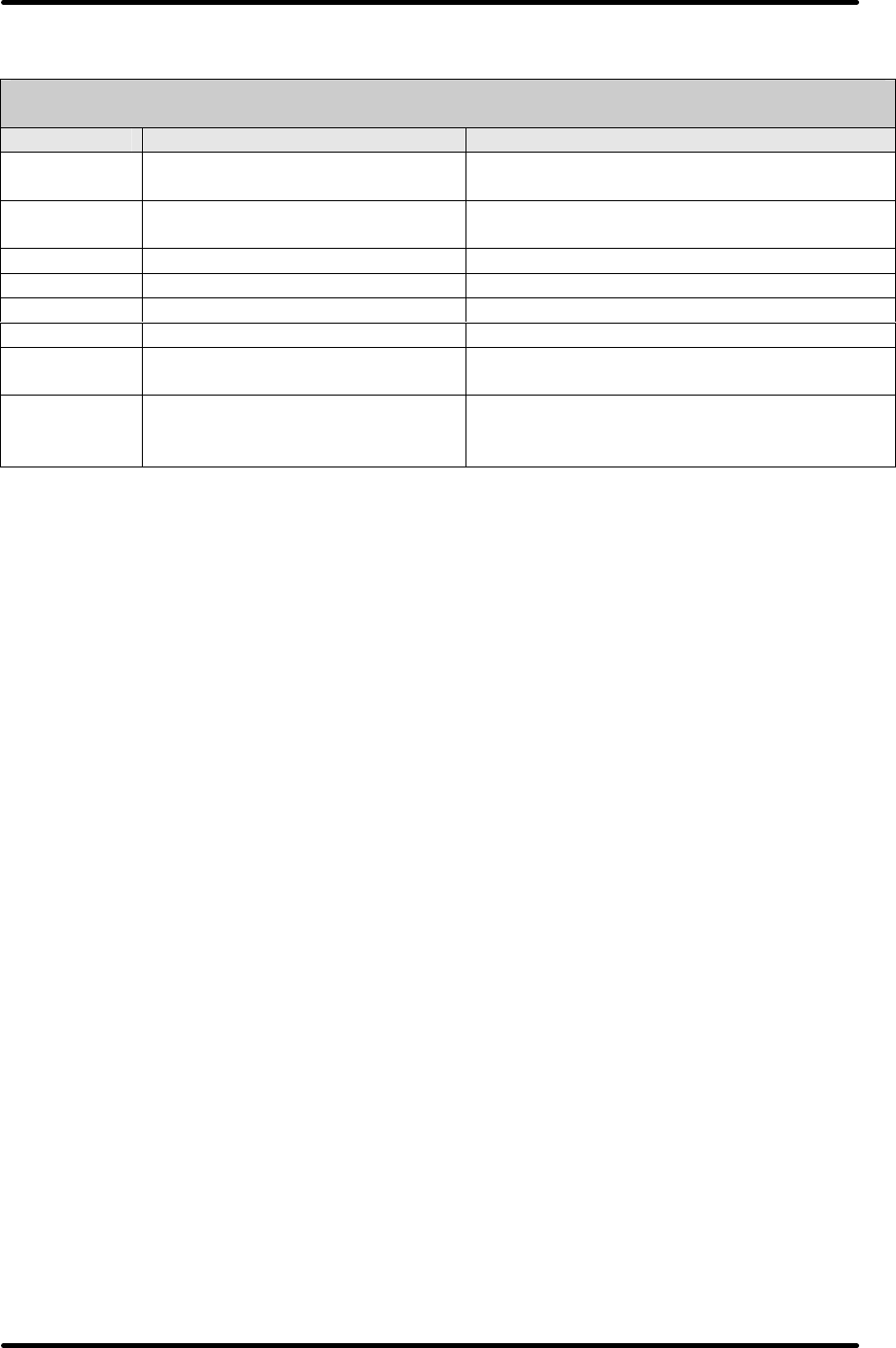
Digital UHF Driver/Transmitter Chapter 4, Circuit Descriptions
LX Series, Rev. 1 4-15
Table 4-1: Firmware Configuration Switch SW2 Operating Positions on Schematic Page 3.
4.3.2.4: Schematic Page 4
U19 and U20 are digitally controlled
analog switches that provide samples
back to the microprocessor. Each
analog input is expected to be between
0 and 5 VDC. If a signal exceeds 5.1
VDC, a 5.1 Volt zener diode clamps the
signals voltage, to prevent damage to
the IC. Most signals are calibrated at
their source, however two dual serial
potentiometers ICs are used to calibrate
four signals, System Visual/Average
Power, System Aural Power, System
Reflected Power and the Spare AIN 1.
For these four circuits, the input value is
divided in half before it is applied to an
op-amp. The serial potentiometer is
used to adjust the output signal level to
between 80 and 120% of the input
signal level. Serial data, serial clock and
serial pot enables are supplied by the
microprocessor to the dual serial
potentiometer ICs. J62 and J63 are two
20 position connectors that provide the
+12 VDC and –12 VDC power through
the Power Protection Board. The ±12
VDC generated by the switching power
supply connects to J62 and J63 after
being fuse protected on the Power
Protection Board.
4.3.2.5: Schematic Page 5
There are three dual element, red/green,
common cathode LED indicators mounted
on the front panel of the sled assembly;
DC OK, Operate and Fault.
There are three, the fourth is a spare,
identical circuits that drive the front panel
mounted LED indicators. The levels on
the 1, 2, 3 and 4 LED Control Lines, for
both the red and green LEDs, are
generated by the IC U11 as controlled by
the DATABUS from the microprocessor U1.
Each LED controller circuit consists of an
N-Channel MOSFET w/internal diode that
controls the base of an N-P-N transistor in
an emitter follower configuration. The
emitter of the transistor connects the LED.
With the LED control line LOW, the
MOSFET is Off, which causes the base of
the transistor to increase towards +12
VDC, forward biasing the transistor. With
the transistor forward biased, current will
flow from ground through the LED, the
transistor and the current limiting
resistors in the collector to the +12 VDC
source. The effected LED will light.
With the LED control line HIGH, the
MOSFET is On, which causes the base of
Firmware Configuration Switch SW2
(On System Controller code version 4.2 & Higher)
SETTING 0 1
SW2-1 No Modulator in translator
configuration Modulator present
SW2-2 Go Standby on RF System
Interlock Fault Only Mute on RF System Interlock Fault
SW2-3 Normal IF Processor not to be installed
SW2-4 Normal Modulator not to be installed
SW2-5 Normal Visual Upconverter not to be installed
SW2-6 DM8 Normal Screens DM8 extended set-up screens
SW2-7 Normal Reverse remote interlock levels, and do
not mute on low forward power
SW2-8 Normal System with Axciter/DT2B. Expect that
an IF Processor, Modulator, and
Upconverter are not present.

Digital UHF Driver/Transmitter Chapter 4, Circuit Descriptions
LX Series, Rev. 1 4-16
the transistor go toward ground
potential, reverse biasing the transistor.
With the transistor reverse biased, no
current through the transistor and LED,
therefore the effected LED will not light.
A third color, amber, can also be
generated by having both transistors
conducting, both control lines LOW. The
amber color is produced because the
current applied to the green element is
slightly greater than the red element.
This occurs because the current limiting
resistors have a smaller ohm value in
the green circuit.
There are four voltage regulators, three
for +5 VDC and one for +7 VDC, which
are used to power the Control Board.
+12 VDC is applied to U25 the +7 VDC
regulator that produces the +7V, which
is applied to the LEDs mounted on the
board. The +7V is also connected to the
input of U26 a precision +5.0 Volt
regulator. The +5.0Vdc regulator output
is used to power the analog circuits and
as the microcontroller analog reference
voltage. Another two +5 Volt regulator
circuits U27, +5V, and U8, +5 Vserial,
are used for most other board circuits.
4.3.3: (A4) Switch Board
(1527-1406; Appendix A)
The switch board provides five front-
panel momentary contact switches for
user control and interface with the front-
panel LCD menu selections. The
switches, SW1 to SW5, complete the
circuit through connector J1 to
connector J2 that connects to J1 on (A5)
the 20 Character by 4 line LCD Display.
J1 on the switch board is also cabled to
the Control Board. When a switch is
closed, it connects a logic low to the
control board that supplies the
information from the selected source to
the display. By pushing the button
again, a different source is selected.
This occurs for each push button. Refer
to Chapter 3 Section 3.5.3, for more
information on the Display Menu
Screens.
4.3.4: (A2) Switching Power Supply
Assembly
The power supply module contains a
switching power supply, an eight position
terminal block for distributing the DC
voltages, a three position terminal block
to which the AC Input connects, Jacks J1,
V1 and V2. Jack J1 connects to the
Control Board and supplies DC OK, at J1-4
& 3, and AC OK, at J1-2 & 1, status to the
control board. A Power Supply enable
connects from the control board to the
power supply at V1-6 & 7. The power
supply is configured for three output
voltages +12V, -12V, at the 8 position
terminal block, and a main output power
of +32 VDC at J50 pin A (+) and J50 pin B
(Rtn). The power supply is power factor
corrected to .98 for optimum efficiency
and decrease in energy consumption. For
safety purposes all outputs are over
voltage and over current protected. This
supply accepts input voltages from 85 to
264 volts AC, but the power entry module,
for the exciter/amplifier chassis, must be
switched to the proper input voltage
setting, for the transmitter to operate.
4.4: (A4) Driver Amplifier Module
Assembly (1303874; Appendix A)
The Driver Amplifier Module Assembly
contains (A1) a 1 Watt UHF Amplifier
Module Assembly (1302891), (A2) a 40
Watt UHF Module Assembly (1304490) in
a 500W system or a RF Module Pallet,
Philips (1300116) in a 1kW system, (A4) a
Coupler Board Assembly (1227-1316),
(A5) an Amplifier Control Board
(1301962) and (A6) a Temperature
Sensor IC.
The RF from the Upconverter Module
Assembly connects from the Upconverter RF
Output BNC Jack J23, through a cable, to
the PA RF Input BNC Jack J24, located on
the rear of the exciter/amplifier chassis
assembly.
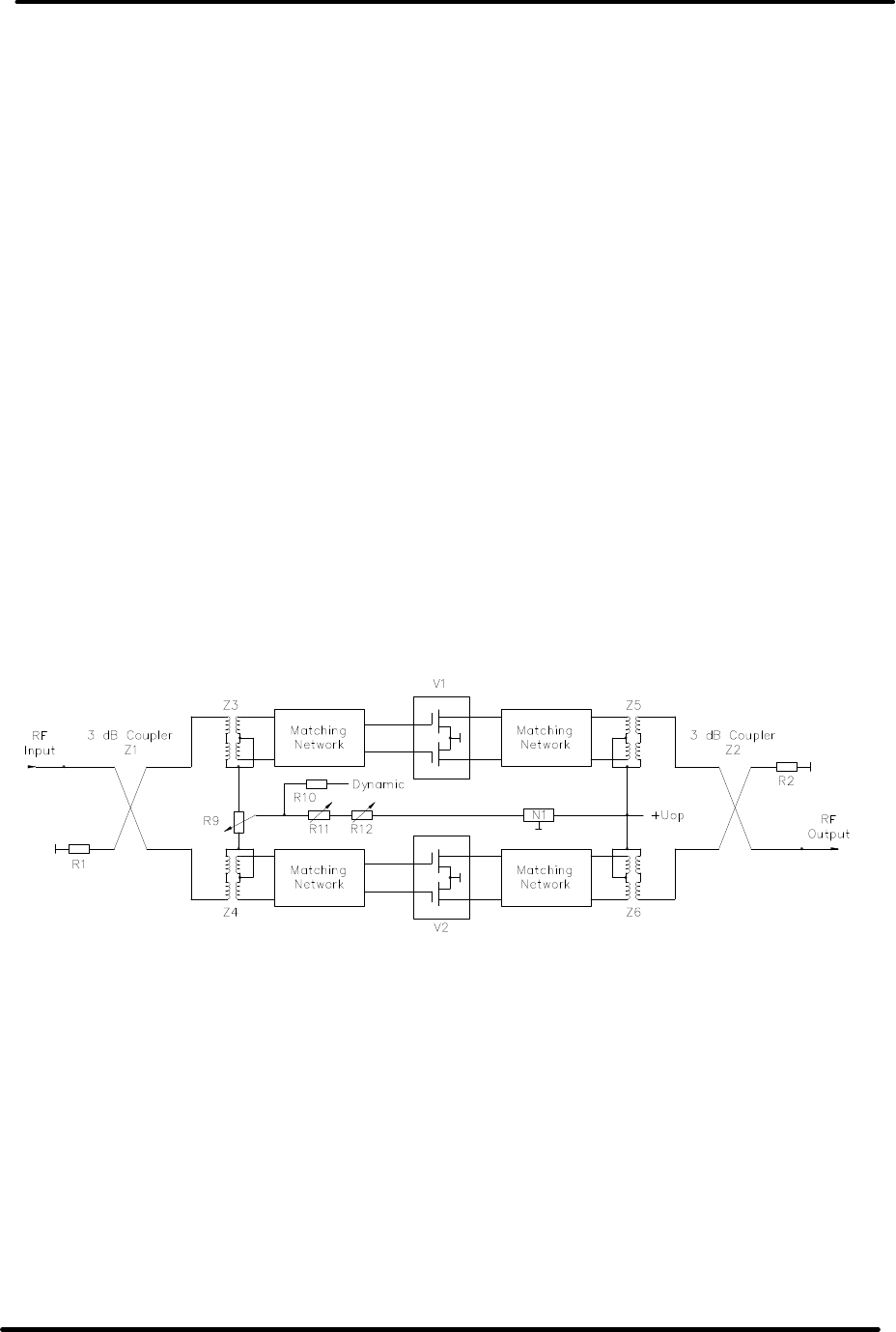
Digital UHF Driver/Transmitter Chapter 4, Circuit Descriptions
LX Series, Rev. 1 4-17
4.4.1: (A1) 1-Watt UHF Module
Assembly (1302891; Appendix A)
The 1-watt UHF module assembly
provides radio frequency interference
(RFI) and electromagnetic interference
(EMI) protection, as well as the heatsink,
for the 1 watt UHF amplifier board
(1302761) that is mounted inside the
assembly.
The +12-VDC bias voltage connects
through J5, a RF-bypassed, feed-through
capacitor, to the amplifier board. The
-12-VDC bias voltage connects through
J6, a RF-bypassed, feed-through
capacitor, to the amplifier board. E1 on
the assembly connects to Chassis
ground.
4.4.2: (A1-A1) 1 Watt UHF Amplifier
Board (1302761; Appendix A)
The 1 watt UHF amplifier board provides
approximately +17 dB of gain. Typically,
in a 500 or 1kW system with an input
signal of +3 dBm at J1 of the assembly, an
output of +20 dBm can be expected at J2.
The UHF signal enters the board at J3, a
SMA connector, and is applied to U3 an IC
hybrid coupler assembly that splits the
input signal into two equal parts. The two
amplifier paths are identical using Q4 and
Q5, 1-Watt HFETs as the amplifier devices.
Each HFET has approximately 14 dB of
gain. The drain voltage needed to operate
each HFET is obtained from the +12 VDC
line that connects to the board at J5 and is
regulated down to +8.25 volts by U4. The
gate negative bias voltage is obtained from
the -12 VDC line that connects to the
board at J6. The amplified outputs of the
HFETs are applied to U2 an IC hybrid
coupler assembly that combines the
amplified signals into a single output that
connects to J4 of the board.
Figure 4-1: RF Amplifier Assembly Module

Digital UHF Driver/Transmitter Chapter 4, Circuit Descriptions
LX Series, Rev. 1 4-18
4.4.3: (A3) RF Amplifier Assembly
(1300116; Appendix A)
The UHF Module Assembly, 250-watt
module (Figure 4-1) is a broadband
amplifier for the frequency range 470 to
860 MHz. The amplifier is capable of
delivering an output power of 70 Wrms.
The amplification is approximately 12
dB. With a typical input of +27dBm an
output of +39dBm is expected.
The amplification circuit consists of the
parallel connected push-pull amplifier
blocks V1 and V2 operating in class AB.
In order to match the transistor
impedance to the characteristic
impedance of the input and output
sides, matching networks are placed
ahead and behind the amplifier blocks.
Transformers Z3 to Z6 serve to balance
the input and output signals. The
paralleling circuit is achieved with the
aid of 3-dB couplers Z1 and Z2.
The working point setting is factory
implemented by means of
potentiometers R9, R11, and R12 and
should not be altered.
4.4.4: (A4) Coupler Board Assembly
(1301949; Appendix A)
The UHF coupler board assembly
provides forward and reflected power
samples of the output to (A5) the
amplifier control board where it connects
to the input of the overdrive-protection
circuit.
The RF input to the UHF coupler
assembly, from the 40 Watt UHF
amplifier module, connects to SMA jack
J1. The RF is connected by a stripline
track to the SMA type connector RF
Output jack J2. A hybrid-coupler circuit
picks off a power sample that is
connected to SMA type connector jack J3
as the forward power sample. Another
power sample is taken from the coupler
circuit that is connected to SMA type
connector jack J6 as the reflected power
sample. Two 50O terminations, used as
dissipation loads, connect to the reject and
reflected ports, J5 and J4, of the coupler.
4.4.5: (A5) Amplifier Control Board
(1303682; Appendix A)
The amplifier control board provides LED
fault and enable indications on the front
panel of the module and also performs the
following functions: overdrive cutback,
when the drive level reaches the amount
needed to attain 110% output power; and
overtemperature, VSWR, and overdrive
faults. The board also provides connections
to the LCD Display for monitoring the %
Reflected Power, % Output Power, and the
power supply voltage.
If the Module OK LED, located on the front
panel is Red and blinking, a fault is present.
The meaning of the blinking LED is as
follows.
1 Blink indicates Amplifier Current Fault.
2 Blinks indicate Temperature Fault.
3 Blinks indicate +32V Power Supply Over
Voltage Fault.
4 Blinks indicate +32V Power Supply
Under Voltage Fault.
5 Blinks indicate Reflected Power Fault.
6 Blinks indicate +12V or –12V Power
Supply Fault
If the Module OK LED, located on the front
panel, is Amber and blinking, it indicates
the power output of the amplifier has
dropped below 65%. NOTE: Only found in
Amplifier Code Versions 3.7A or later and
System Controller Code Versions 3.9C or
later.
4.4.5.1: Schematic Page 1
U4, located upper center of page, is an in
circuit microcontroller. The controller is
operated at the frequency of 3.6864 MHz
using crystal Y1. Programming of this
device is performed through the serial
programming port J2. U4 selects the
desired analog channel of U1 through the
settings of PA0-PA3. The outputs of Port A
must be set and not changed during an
analog input read of channels PA5-PA7.

Digital UHF Driver/Transmitter Chapter 4, Circuit Descriptions
LX Series, Rev. 1 4-19
PA4 of U4 is a processor operating LED
that monitors the +/-12 VDC. PA5 is
used to monitor the +12VDC supply to
the board. PA6 is the selected channel of
analog switch U1. PA7 is connected to a
via, V10, for future access.
U6 is a serial to RS-485 driver IC. U7 is
a watchdog IC used to hold the
microprocessor in reset, if the supply
voltage is less than 4.21 VDC. U7
momentarily resets the microcontroller if
Pin 6 (!ST) is not clocked every second.
A manual reset switch is provided but
should not be needed.
Upper left corner U3 is used to determine
where the amplifier control board is
located. The eight inputs come from the
main amp connector and are used to set
the SCADA address of the controller.
Pull-up resistors set a default condition of
logic high.
U5 below U3 is used for getting digital
input information of the board. Page two
has several monitoring circuits that
provide information on the amplifier’s
status. Many of these circuits
automatically shut down the amplifier if a
specific fault occurs.
U8 below U5 is used to control four board
mounted status LEDs. A FET is turned
On to shunt current away from the LED
to turn it Off. U9 below U8 is used to
enable different features within the
software. Actual use is to be determined.
4.4.5.2: Schematic Page 2
In the lower right corner are voltage
regulator circuits. U22 should allow for
0.14 amps of power using its 92 C/W
rating if Ta = 60°C max and Tj = 125°C
max 0.26 amps can be obtained from
U22 if the mounting pad is 0.5 square
inches. The controller will not need this
much current.
U23 and U24 are low drop out +5 VDC,
voltage regulators with a tolerance
greater than or equal to 1%. 100mA of
current is available from each device but
again the controller will not need this much
current.
In the upper left section are circuits with
U12 and U13. U12 is used to generate a
regulated voltage that is about 5 volts less
than the +32 VDC supply, approximately
+26.25 VDC. When the +32 VDC supply is
enabled, the circuitry around U13B is used
to provide gate voltage to Q10 that is 5
volts greater than the source pin of this
FET. The gate of Q10 can be turned Off by
any one of a few different circuits.
U10A is used to turn Off the gate of Q10 in
the event of high current in amplifier #1.
At 0.886 VDC the current to amplifier #1
should be greater than 5 Amps. U11B is
used to turn off the Q10 FET, if high current
is detected in amplifier #2. U11A is used to
turn off the Q10 FET, if high current is
detected in amplifier #3. With 2.257 VDC
at Pin 5 of U11B or Pin 3 of U11A, the
voltage output of current sense amplifier
U17 or U18 at high current shut down
should be greater than 15 Amps.
U14B is used to turn Off the gate of Q10 in
the event of high power supply voltage,
approximately +35.4 VDC. U14A is used to
keep the FET disabled in the event of low
power supply voltage, approximately +25.4
VDC.
Current monitoring sections of the board
The ICs U16, U17 and U18 along with
associated components set up the current
monitoring sections of the board. R67, R68
and R69 are 0.01O/5W 1% through hole
resistors that are used for monitoring the
current through several sections of the
amplifier. The voltages developed across
these resistors are amplified for current
monitoring by U16, U17 or U18. The
LT1787HVCS8 precision high side current
sense IC amplifier accepts a maximum
voltage of 60 VDC. The 43.2 kO resistor
from pin 5 to ground sets the gain of the
amplifier to about 17.28. This value is not
set with much accuracy since the
manufacturer internally matches the

Digital UHF Driver/Transmitter Chapter 4, Circuit Descriptions
LX Series, Rev. 1 4-20
resistors of this part but their actual
resistance value is not closely defined. A
trimming resistor is suggested to give a
temperature stability of –200 ppm/C, but
instead the microcontroller will determine
the exact gain of the circuit and use a
correction factor for measurements.
Circuit loading components are located in
the lower portion of each current
monitoring circuit. These components
allow for short duration high current
loading of the supply, by measuring the
current through the sense resistor with
and without the additional four 30.1 O
1% resistors. For very short duration
pulses, a 1206 resistor can handle up to
60 watts. The processor requires 226
uSec per conversion. A supply voltage of
+32 VDC will pass 1.06 amps + 1%
through the load resistors.
A6 is a temperature sensor thermistor
that is used to monitor the temperature
of the module's heat sink. It connects
to J6 pins 1 & 2 on the board wand is
wired to the comparator IC U10B. If the
temperature increases above 75°C the
output will go Low that is used as a
temperature fault output, which
generates a Fault alert at U15A and
disables Amplifier #1.
Visual/Average and Reflected power
detector sections of the board.
NOTE: The aural sections of this board
are not used with digital signals.
4.4.5.3: Schematic Page 3
A Forward Power Sample enters the
board at SMA Jack J3 and is split. One
part connects to J4 on the board that is
cabled to J1, the SMA Forward Power
Sample Jack, located on the front panel
of the assembly. The other part of the
split forward power sample is detected by
CR17 and the DC level amplified by
U25A. The output of U25A at pin 1 is
split with one part connected to the Aural
Power sample, which is not used in this
digital transmitter. The other split output
connects to U265A that is part of the
Forward Average Power circuit. The
detected level is connected to L4 that is part
of an intercarrier notch filter circuit that is
tuned to eliminate the 4.5 MHz aural
intercarrier, if present. The Average power
sample is amplified by U26D and connected
through the average calibration pot R166 to
U26C. The output of U26C is connected to
the comparator IC U26B that has Aural Null
and Offset Null, if present in the system,
connected to the other input. The output
Average Forward power level connects to J9
pin 2 of the board.
A Reflected Power Sample enters the board
at SMA Jack J5 and is detected by CR20 and
the DC level amplified by U28B. The output
of U28B at pin 7 is connected through the
reflected calibration pot R163 to U28C. The
output is split with one part connected to J9
pin 5, the Reflected Power Output level of
the board. The other part of the split from
U28C connects to the comparator IC U28D
that has a reference level connected to the
other input. If the reflected level increases
above the reference level a low output is
produced and connected to the Reflected
Power Shutdown circuit at CR28. The low
shuts off Q14 causing pin 3 to go high that
is connected to the inverter U15C. The
output of U15C goes low producing a
Reflected Power Fault that is connected to
an output of the board, the Fault Alert
circuit and also shuts down Amplifier #1.
Gain of the power measurements is
completed through software. Only the Aural
Null and Offset Null need to be done
through front panel pots.
This completes the description of the Driver
Amplifier Module Assembly, which is used in
high power transmitters with external PA
assemblies.
The output of the driver amplifier module
assembly connects to the output of the
Exciter/Amplifier chassis assembly at the
“N” type connector Jack J25. The RF output
at J25 connects to J200 the RF input to the
external Power Amplifier Assembly.

Digital UHF Driver/Transmitter Chapter 4, Circuit Descriptions
LX Series, Rev. 1 4-21
4.5: (A44) Dual Peak Detector Board
(1159965; Appendix A)
The function of the dual peak detector
board is to detect forward and reflected
output power samples and generate
output voltages that are proportional to
the power levels of the sampled signals
for use by the control monitoring
assembly in the exciter.
There are two identical signal paths on
the board: one for forward power and
one for reflected power. A sample of
forward output power, from the external
DTV mask filter, enters the board at the
SMA jack J1. Resistors R1 and R2 form
an input impedance-matching network of
50Ω. The forward power signal is
detected by CR1, R7, R25, C1, and C7.
For digital operation the jumpers, W1 on
J6 and W3 on J8, are both between pins
1 & 2. The detected output is buffered
by the operational amplifier U1C before it
is split. One part is connected to the
forward uncalibrated power output jack
J4. The other split output is connected to
forward power adjust pot R9, which
adjusts the gain of U1D. The output of
U1D is split with one part connected to
J3-4 Forward Power Metering Output #1.
The other output of U1D is connected to
J3-6 Forward Power Metering Output #2.
A sample of reflected output power, from
the external DTV mask filter, enters the
board at the SMA jack J2. Resistors R3 and
R4 form an input impedance-matching
network of 50Ω. The reflected power signal
is detected by CR2, R26, R8, C3, and C8.
For digital operation the jumper W2 on J7 is
between pins 1 & 2. The detected output is
buffered by the operational amplifier U1B
before it is split. One part is connected to
the reflected uncalibrated power output jack
J5. The other split output is connected to
reflected power adjust pot R10, which
adjusts the gain of U1A. The output of U1A
is split with one part connected to J3-9
Reflected Power Metering Output #3. The
other output of U1A is connected to J3-11
Reflected Power Metering Output #4.
Voltages for Circuit Operation
The +12 VDC needed for the operation of
U1 on the board enters the board at J3-2
from TB31-16 on the Driver/Amplifier
Assembly and is connected through a filter
and isolation circuit consisting of C5, C9 and
L3 before it is connected to U1. The -12
VDC needed for the operation of U1 on the
board enters the board at J3-8 from TB31-
18 on the Driver/Amplifier Assembly and is
connected through a filter and isolation
circuit consisting of C6, C12 and L6 before it
is connected to U1.
This completes the description for the entire
Exciter/Amplifier chassis assembly.

Digital UHF Driver/Transmitter Chapter 5, Detailed Alignment Procedures
LX Series, Rev. 1 5-1
Chapter 5:
Detailed Alignment Procedures
5.1: System Preparation
This transmitter was aligned at the
factory and should not require additional
adjustments to achieve normal operation.
This exciter/amplifier of the LX Series
driver/transmitter is of a Modular design
and when a Module fails that module
needs to be changed out with a
replacement module. The replacement
module can then be sent back to Axcera
for repair. Contact Axcera Customer
Service Department at 724-873-8100 or
fax to 724-873-8105, before sending in
any module.
5.1.1: Module Replacement
Module replacement on the LX series
products is a relatively simple process.
All modules plug directly into the
backplane board except for the power
amplifier module, and in higher power
units, the power supply and power
amplifier modules, which plug into a
blind mating connector. To replace a
module, refer to the following
procedure.
Loosen the two grip lock connectors,
located on the front panel, at the top
and bottom of the module,
counterclockwise until the module
releases. The Modulator, IF Processor,
Upconverter and Controller/Power
Supply can then be gently pulled from
the unit. To remove the Driver/Power
Amplifier Module in the exciter/amplifier
chassis assembly, the two cables, Input
and Output, connected to the rear of the
chassis must be removed. These two
cables and also a 6/32” x ½” shipping
screw, located between the two
connectors, must be removed before the
module will slide out. After removal of
the failed module, slide the replacement
module in place and make certain it
connects to the backplane board. If the
replacement module is a driver/PA
Module replace the two cables to the
rear of the exciter/amplifier chassis
assembly. The 6/32” x ½” shipping
screw does not need to be replaced. It
is only used during shipping. If the
replacement module does not slide in
easily, verify it is properly aligned in the
nylon tracks, located on both the top
and bottom of the module.
Note: Each Module has an assigned slot
and will not fit properly or operate in the
incorrect slot. Do not try to place a
Module in the wrong slot as this may
damage the slot or the connectors on
the backplane board. Each module has
the name of the module on the front,
bottom for identification and correct
placement. The Modules are placed in
the unit from left to right; (1) Blank
panel, (2) Blank panel, (3) IF Processor,
(4) LO/Upconverter, (5)
Controller/Power Supply and (6) Driver
Power Amplifier.
5.1.2: Initial Test Set Up
This exciter operates using a single MPEG
input to J12 on the rear of the Exciter
assembly. Check that the RF output at
the coupler is terminated into a dummy
load of at least the rated output of the
transmitter. While performing the
alignment, refer to the Test Data Sheet
for the transmitter and compare the final
readings from the factory with the
readings on each of the modules or tray.
The readings should be very similar. If a
reading is way off, the problem is likely
to be in that module or tray. Switch On
the main AC for the system and the
ON/OFF circuit breaker on the rear of the
amplifier chassis assembly.
5.2: LX Series Exciter Chassis
Assembly
The exciter chassis assembly operates
using a digital IF input from the DM8-R
modulator IF output jack J4 that

Digital UHF Driver/Transmitter Chapter 5, Detailed Alignment Procedures
LX Series, Rev. 1 5-2
connects through a cable to J6, the
modulated IF Input jack, on the rear of
the chassis assembly. The digital IF in
the chassis assembly connects to the IF
Processor module.
On the LCD Display, located on the
Controller/Power Supply Module, push
the button to switch the transmitter to
Operate. The setup of the RF output
includes adjustments to the drive level of
the Upconverter, and the adjustment of
the linearity and phase predistortion to
compensate for any nonlinear response
of the external amplifier, using controls
accessed through the front panel of the
IF Processor module.
5.2.1: IF Processor Module Assembly
Verify that all red LEDs located on the IF
Processor front panel are extinguished.
The following details the meaning of each
LED when illuminated:
• DS1 (input fault) – Indicates that
either abnormally low or no IF is
present at the input of the module.
• DS2 (ALC fault) – Indicates that the
ALC circuit is unable to maintain the
signal level requested by the ALC
reference. This is normally due to
excessive attenuation in the linearity
signal path or the IF phase corrector
signal path, or that switch SW1 is in
the Manual ALC Gain position.
• DS4 (Mute) – Indicates that a Mute
command is present to the system.
Switch the transmitter to Standby. The
ALC is muted when the transmitter is in
Standby. To monitor the ALC, preset R3,
manual gain adjust, on the front panel of
the Upconverter module, fully CCW.
Move switch SW1, Auto/Man AGC, on the
front panel of the Upconverter module, to
the Manual position. Place the
transmitter in Operate. Adjust the ALC
GAIN pot on the front panel of the IF
Processor to obtain +0.8 VDC on the LCD
Display on the Controller/Power Supply in
the ALC screen. Move the MAN/AUTO
ALC switch back to Auto, which is the
normal operating position.
To adjust the AGC Cutback setting, raise
the output power of the transmitter to
110%. Adjust R2, AGC Cutback, located
on the front panel, CCW until the LED
DS1, AGC Cutback, just starts to flash.
Return the output power of the
transmitter to 100%.
5.3: Adjusting the IF ALC Gain, the
AGC 1, AGC 2, and the Overdrive
Cutback Protection (AGC Cutback)
NOTE: The transmitter was set up at the
factory and should require no
adjustments to attain normal operation.
Before beginning this procedure, put the
transmitter into standby and preset the
following pots and switches. Put the
Man/Auto ALC switch in the Man mode,
turn the ALC Manual Gain Pot and ALC
mode Pot, on the IF processor, full
counter clockwise, also put the
Man/Auto AGC switch in the Man mode
and turn the AGC Man Gain pot and AGC
Adj pot on the upconverter module full
counter clockwise. Set the AGC cut-in
Adj pot full clockwise. Now you can re-
enable the transmitter and begin the
following procedure.
The ALC switch should already be in the
Manual mode. Adjust the ALC Man Gain
pot, located on the front panel of the IF
Processor module, to 0.8 volts. Next,
set the IF ALC to the Auto mode. Turn
the ALC Adj. pot, located on the front of
the IF Processor, clockwise until the ALC
is at 0.8 volts, which stays constant to
control the loop around the correction.
AGC1 is at RF and controls the loop to
the output of the driver. The AGC
switch on the front of the Upconverter
should be in the Manual mode. Turn the
AGC Man Gain pot clockwise until the
output of the transmitter is at full
power. Calibrate the output metering on
the driver to 100%. AGC1 should be at
.8 volts with the Driver at 100% output.
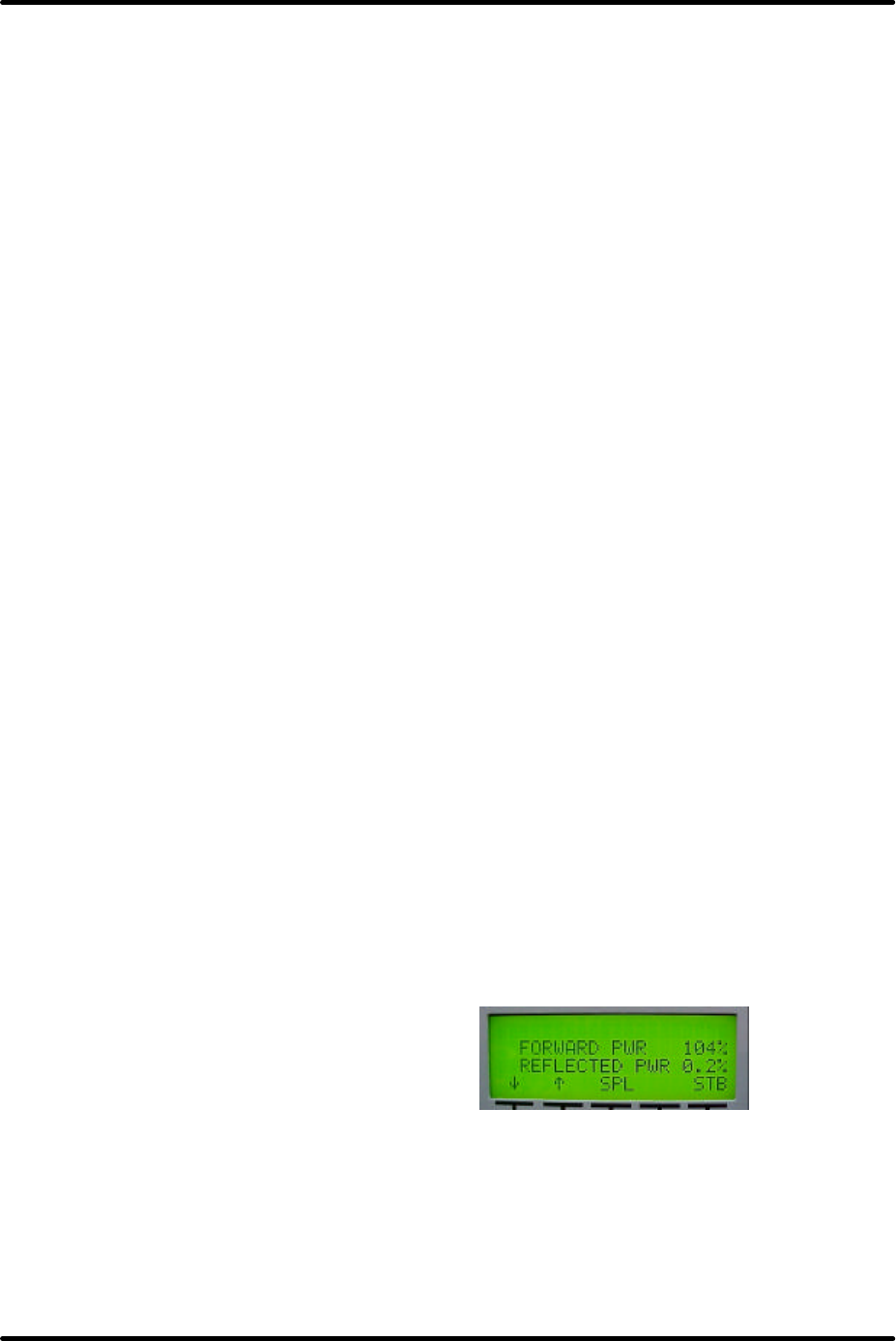
Digital UHF Driver/Transmitter Chapter 5, Detailed Alignment Procedures
LX Series, Rev. 1 5-3
With the AGC still in the manual mode
and the transmitter at full power,
calibrate the Transmitter output metering
to 100%. In transmitters that utilize
external amplifier modules and with the
transmitter at full power and 100% O/P
metering, the Forward Power readings for
each of the amplifier modules should be
readjusted to a 100% Forward Power
reading. NOTE: The transmitter AGC
must be in the Manual Gain position
when readjusting the module forward
power. These amplifier readings can be
found under the Transmitter Details Main
Screen, by arrowing down to each Amp
Set and each Module in turn.
Set the Man/Auto AGC Switch, located on
the front of the Upconverter, to Auto and
readjust the transmitter output power
level to 100% with the AGC Adj pot. The
external amplifiers should have all been
set up for 100% Forward Power readings
previously and should return to 100%
after setting the transmitter output level
to 100% in the Auto mode.
Next, the Inner Loop Gain is adjusted
until the power starts to decrease, this
means that AGC1 and AGC2 are at the
same voltage. When at the cut-in point,
look on the display at the gain value of
the inner loop (0 to 255). Whatever the
value is, decrease the inner loop gain
level by 10%. (Example, if the display
shows 200, decrease to 180). This sets
the difference between AGC1 and AGC2.
There is no adjustment for AGC2,
therefore AGC2 is what it is, but should
be around 0.9 Volts.
Overdrive Protection Setup (AGC
Cutback): Adjust the output power to
110%, 10% above 100%. Next, setup
the overdrive cut-in by adjusting the
AGC Cutback Pot. Slowly turn the AGC
Cutback Pot, located on the front of the
upconverter, Counterclockwise until
the AGC Override light begins to flicker,
and the output power begins to drop.
Turn the pot Clockwise slightly, so the
light just goes out and the power
stabilizes. Repeat if needed. Re-adjust
the AGC ADJ pot as needed until the
power level returns to the 100% output
power level.
The Transmitter is ready for normal
operation.
5.4: Calibration of Output and
Reflected Power for transmitters
5.4.1: Calibration of the Transmitter
Forward Output Power Level
Switch the transmitter to Standby.
Switch the Upconverter sled to Manual
Gain. Adjust R48, the null offset pot
located on the visual/aural metering
board, full CW. Adjust CCW until 0%
visual output is displayed on the LCD
Display in the System Forward Power
position. Switch the transmitter to
Operate.
Next, set up the transmitter for the
appropriate average output power level
using the Manual Gain pot on the
Upconverter sled.
Adjust R9, forward calibration, on the
dual peak detector board, mounted on
the inside, left side panel, toward the
rear of the cabinet, for .8V, as measured
at TB30-14 and TB30-12 return, on the
terminal block TB30 located on the rear
of the exciter/driver chassis assembly.
Then adjust the LCD display to read
100% on the front panel meter in the
System Forward Power position.
(Example of the screen follows).
5.4.2: Calibration of the Transmitter
Reflected Output Level
Move the Reflected cable on the (A11)
coupler to the unused “INC” port on the
coupler while adding a 10 dB pad. Then
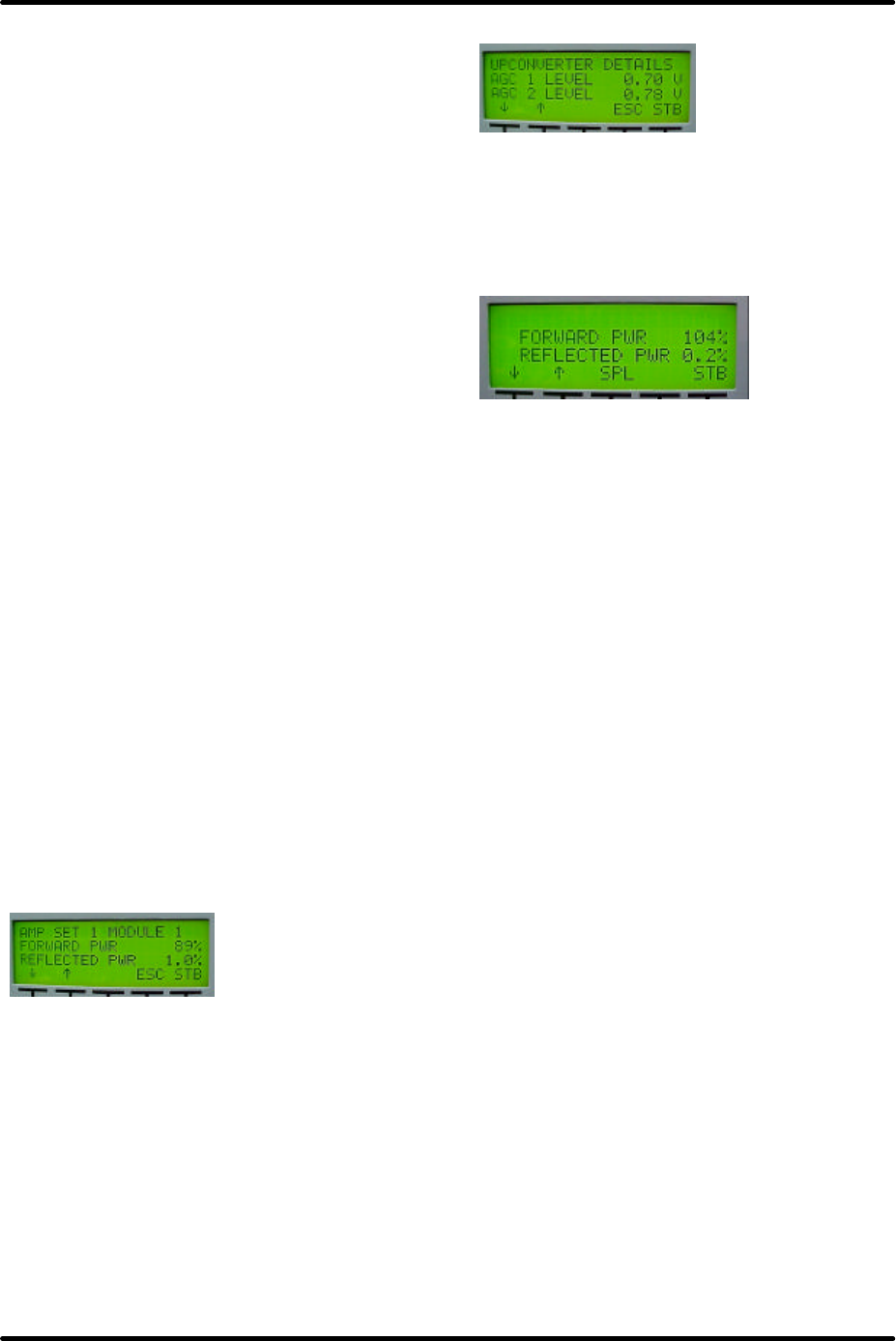
Digital UHF Driver/Transmitter Chapter 5, Detailed Alignment Procedures
LX Series, Rev. 1 5-4
adjust R10 on the dual peak detector
board for a .2VDC, at TB30-13 and TB30-
12 return, on the terminal block TB30
mounted on the rear of exciter/driver
chassis assembly. Next adjust the LED
display for 10% reading in the System
Reflected Power position. At this 10%
reference power reading, a reflected
power fault should appear on the System
Errors Menu, if the Fault is set at 10%
under the set up menu. Turn the power
adjust pot slightly CCW and the fault
should be clearable on the System Error
Menu. Turn the pot CW until the Fault
appears. The reflected output power is
now calibrated.
Switch the transmitter to Standby and
move the Reflected power cable on the
A11 Coupler back to the “Reflected Port”
and remove the 10dB pad.
When the transmitter utilizes external
amplifier modules, the Forward Power
readings for each of the amplifier
modules will need to be readjusted to a
100% Forward Power reading. NOTE:
The transmitter must be in the Manual
Gain position when readjusting the
forward power. These amplifier readings
can be found under the Transmitter
Details Main Screen, by arrowing down to
each Amp Set and each Module. These
adjustments are completed after the
System Forward and Reflected Powers
have been calibrated to 100% power.
(Example of screen is shown below).
The Driver PA Assembly’s Visual
Calibration adjust pot should be adjusted
for .8V AGC 1 on the Upconverter Details
Screen found in the Transmitter Details
Screens. After the Amplifiers are all
calibrated for 100% Forward Power
readings, the AGC 2 voltage found on the
same Upconverter Details screen should
be at .9V. (Example of screen is shown
below).
Switch the transmitter to Operate and
adjust the front panel power pot for a
100% visual power reading. Switch the
LO/Upconverter to the Auto AGC position.
(Example of screen is shown below).
The Transmitter is ready for normal
operation.
5.5: Linearity Correction Adjustment
As shipped, the exciter was preset to
include amplitude and phase pre-
distortion. The pre-distortion was
adjusted to approximately compensate
the corresponding non-linear distortions
of the Power Amplifier.
NOTE: On the IF processor board inside
the IF Processor module the correction
enable/disable jumper W12 on J30 must
be in the Enable position, on pins 2 & 3.
Set up a spectrum analyzer for 30 kHz
resolution bandwidth and 30 kHz video
bandwidth. Connect the spectrum
analyzer to monitor the intermodulation
products of the RF output signal of the
Power Amplifier. A typical digital
spectrum is shown in Figure 5-1.
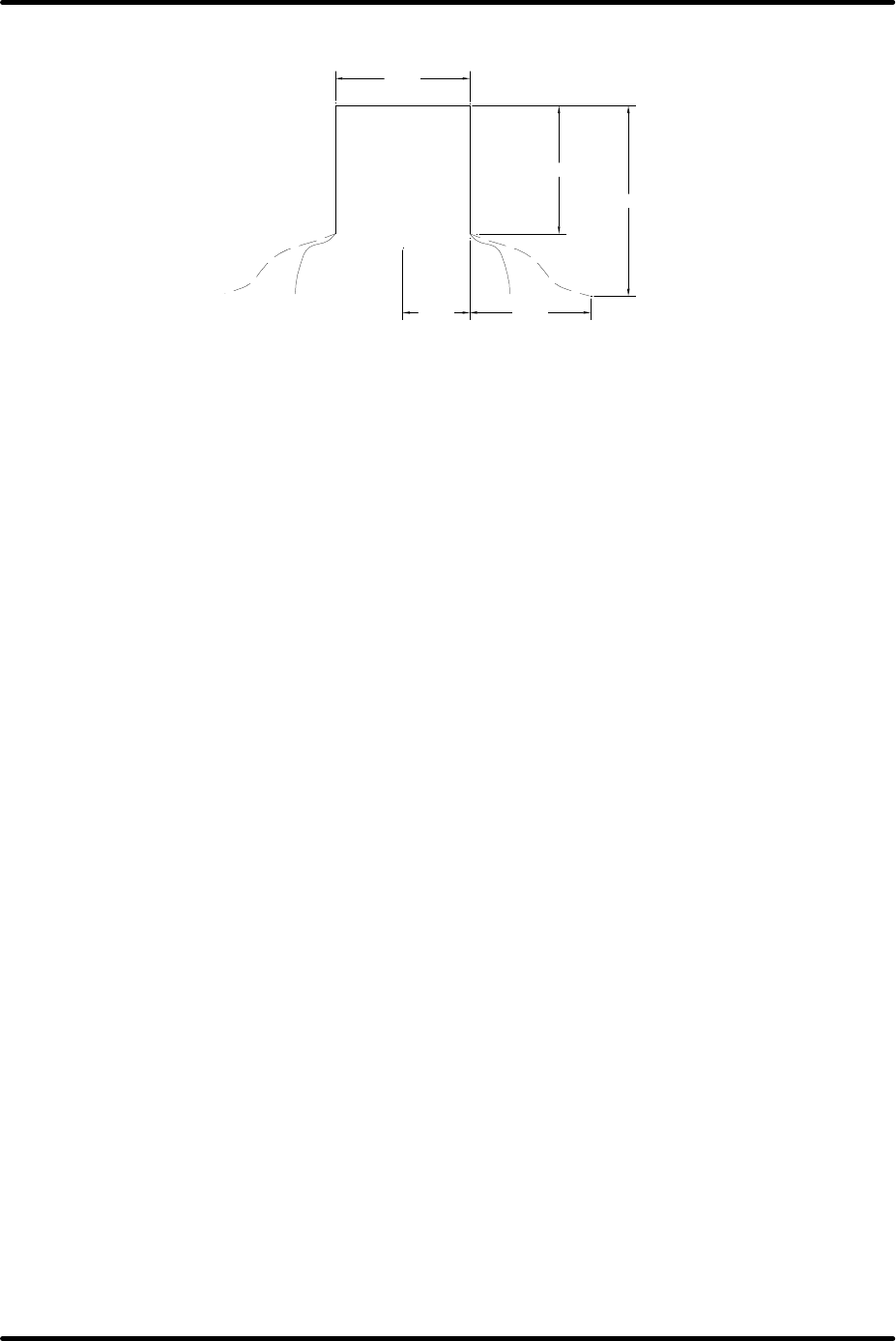
Digital UHF Driver/Transmitter Chapter 5, Detailed Alignment Procedures
LX Series, Rev. 1 5-5
6 MHz
-35 dB
-110 dB
3 MHz 6 MHz
Figure 5-1: Typical 6 MHz Digital Spectrum
There are three Linearity Corrector stage
adjustments located on the front panel of
the IF Processor Module. The adjustments
are threshold settings that are adjusted as
needed to correct for any amplitude or
phase intermodulation problems. Adjust
the top linearity correction adjustment
R211 threshold cut in for the in phase
amplitude distortion pre-correction that is
needed. Next adjust the middle linearity
correction adjustment R216 threshold cut
in also for the in phase amplitude
distortion pre-correction that is needed.
Finally, adjust the bottom linearity
correction adjustment R231 threshold cut
in for the quadrature phase distortion pre-
correction that is needed. The above pots
are adjusted for the greatest separation
between the digital signal and the
intermodulation at the channel edges.
5.6: Frequency Response Delay
Equalization Adjustment
The procedure for performing a
frequency response delay equalization
adjustment for the transmitter is
described in the following steps:
CAUTION: Making the following
adjustments will change the linearity
correction table loaded into the DM8-R
Digital Modulator tray and a new file may
need reloaded. Please call Axcera Field
Support for information on the loading of
the linearity correction table into the
DM8-R Digital Modulator tray.
The center frequency for the first stage is
42 MHz. Adjust R103, the top frequency
response equalizer pot, located on the
front panel of the IF Processor Module,
for the best depth of frequency response
correction at 42 MHz.
The center frequency for the second
stage is 43.5 MHz. Adjust R106, the
middle frequency response equalizer pot,
located on the front panel of the IF
Processor Module, for the best depth of
frequency response correction at 43.5
MHz.
The center frequency for the third stage
is 45 MHz. Adjust R274, the bottom
frequency response equalizer pot, located
on the front panel of the IF Processor
Module, for the best depth of frequency
response correction at 45 MHz.
After the three delay attenuation
equalizers have been adjusted, fine tune,
as needed, for the best frequency
response across the channel.
The Transmitter is now aligned,
calibrated, and ready for normal
operation.
This completes the detailed alignment
procedures for the Digital LX Series
transmitter.
If a problem occurred during the
alignment, help can be found by calling
Axcera field support at 724-873-8100.
APPENDIX A
INNOVATOR LX SERIES SPECIFICATIONS
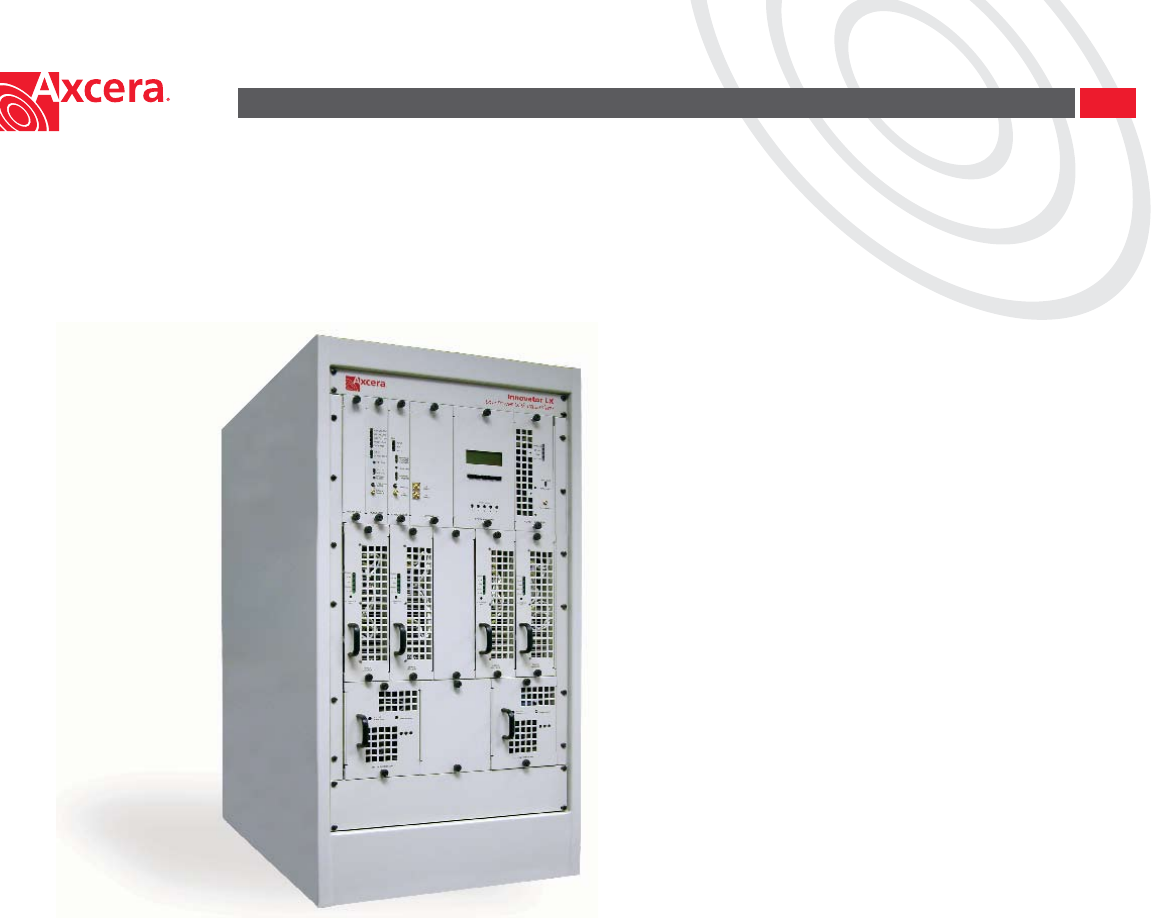
Innovator LX
Low Power DTV Transmitter 5W - 3kW
Designed to provide broadcasters with a product that will meet their needs like
no other solution on the market, this new low to medium power transmitter
line uses the latest LDMOS devices for broadband operation across the entire
UHF band. This allows users to minimize spare parts stock, which is especially
important to group owners and networks, and also enables simple and
inexpensive channel changes.
The very compact and completely modular design uses a chassis/backplane
configuration with parallel amplifier and power supply modules which can be
removed and replaced while the transmitter is on the air.
Configurations are available in power levels from 10 watts to 6 kilowatts
analog and up to 3 kilowatts DTV, and all are manufactured in the USA by
Axcera - The RF Experts.
LU1000AT Shown
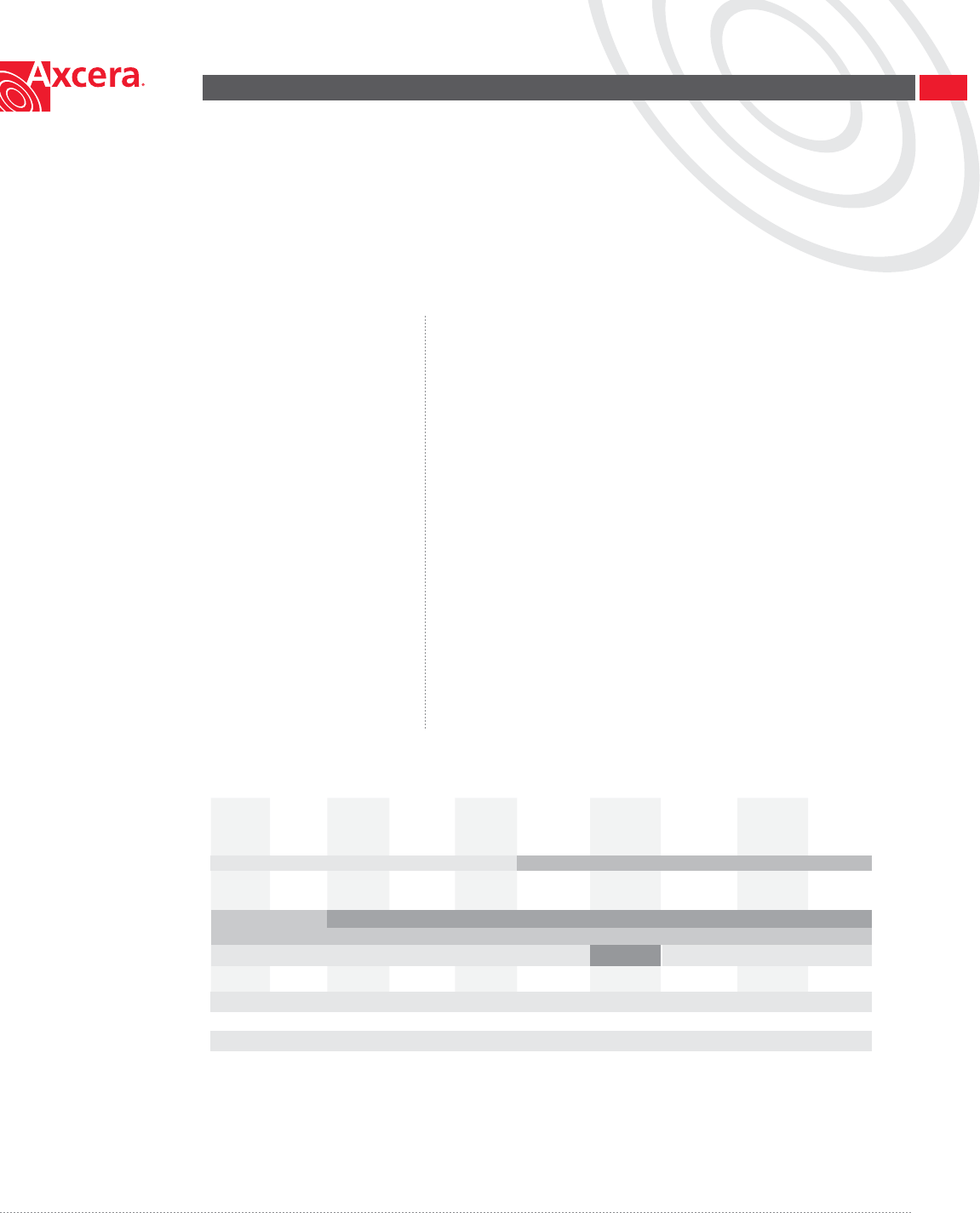
Specifications published here are current as of the date of publication of this document. Because we are continuously improving our products, Axcera reserves the right to change specifications without prior notice. At any time, you may verify
product specifications by contacting our office. Axcera views it’s patent portfolio as an important corporate asset and vigorously enforces its patents. Products or features contained herein may be covered by one or more U.S. or foreign patents.
0311R4 © 2004 AXCERA All Rights Reserved An Equal Opportunity Employer
103 Freedom Drive, PO Box 525, Lawrence, PA 15055 t: 724-873-8100 f: 724-873-8105
General
Model Number LU5ATD LU50ATD LU125ATD LU250ATD LU500ATD LU1000ATD LU1500ATD LU2000ATD LU2500ATD LU3000ATD
Power Output (Average) 5 W 50 W 125 W 250 W 500 W 1000 W 1500 W 2000 W 2500 W 3000 W
Output Connector 7/8” EIA 31/8” EIA
Power Consumption (Watts) 250 W 650 W 1000 W 1700 W 3400 W 6700 W 10,500 W 13,500 W 17,000 W 20,500 W
Input Power
Line Voltage (Volts) 117/230 ±10% 230 ± 10%
Power Requirements Single Phase, 50 or 60 Hz
Size (H x W x D) 55”x22”x34” 76”x22”x34” 76”x44”x34”
Weight (lbs.) 300 300 340 360 400 550 700 1030 1180 1330
Operational Temperature Range 0 to +50°, derate 2°C/1000 ft.
Maximum Altitude3 8500 feet (2600m) AMSL
Operational Humidity Range 0% to 95% non-condensing
RF Load Impedance 50 Ω
Performance
Frequency Range1 470 to 860 MHz
Output Impedance 50 Ω
Frequency Stability ±1kHz (max 30 day variation)
w/Precise Frequency Option ±2Hz
Regulation of RF Output Power 3%
Out of Band -Compliant with FCC Mask2
Channel Edge ±500kHz -47 dB or better
6MHz from Channel Edge -110 dB or better
Signal to Noise (SNR) 27 dB or better
Data Interface
Input Rate 19.39 Mbps, 6 MHz Channel
Input Interface SMPTE 310M, Serial Differential
ECL & TTL
Test Signals Internal PRBS 23 MPEG Stream
Options
Dual Exciter with Automatic Switcher
AC Surge Protector
Precise Frequency Kit
Spare Parts Kit
1 Other Frequencies - Consult Factory
2 Measured in 30 KHz RBW, relative to total average power
3 Above 8,500 feet - Consult Factory
Innovator LX
Low Power DTV Transmitter 5W - 3kW
APPENDIX B
DRAWINGS LIST

Digital UHF Driver/Transmitter Appendix A, Drawings and Parts Lists
LX Series, Rev. 1 A-1
Innovator LX Series Digital System
LX Series Driver Typical Block Diagram..................................................1302139
LU1000ATD, 1000W LX Series Digital Transmitter Typical Interconnect.....1303941
LX Series 50-1000 Watt Digital Transmitter Typical Racking Plan..............1303596
Dual Peak Detector Board (Mounted in a Dual Peak Detector Assembly, 1092646)
Schematic..........................................................................................1159976
Chassis Assembly, 220 VAC, Exciter, LX Series
Interconnect.......................................................................................1303108
Backplane Board, LX Series
Schematic..........................................................................................1301995
NOTE: Information and Drawings on the DM8-R Modulator Tray are contained in
the separate DM8-R Manual.
IF Processor Assembly
IF Processor Board
Schematic..........................................................................................1301983
Upconverter Assembly
Block Diagram....................................................................................1302107
Interconnect.......................................................................................1302060
Front Panel LED Display Board
Schematic..........................................................................................1303035
UHF Filter
Schematic.......................................................................................1007-3101
UHF Generator Board
Schematic.......................................................................................1585-3265
L.O./Upconverter Board
Schematic..........................................................................................1302134
Control/Power Supply Assembly, 220 VAC
Block Diagram....................................................................................1303889
Interconnect.......................................................................................1302062
Control Board
Schematic..........................................................................................1302023
Power Protection Board
Schematic..........................................................................................1302839
Switch Board
Schematic.......................................................................................1527-3406

Digital UHF Driver/Transmitter Appendix A, Drawings and Parts Lists
LX Series, Rev. 1 A-2
Driver Power Amplifier Assembly
Block Diagram....................................................................................1305138
Interconnect.......................................................................................1305137
RF Module Pallet w/o Transistors, (Made into a RF Module Pallet, Philips, 1300116)
Schematic........................................................................51-5379-309-00 WSP
Coupler Board Assembly
Schematic..........................................................................................1303152
1 Watt UHF Amplifier Board (Mounted in a 1 Watt Module Assembly, 1302891)
Schematic..........................................................................................1302762
Amplifier Control Board
Schematic..........................................................................................1303683
APPENDIX C
TRANSMITTER LOG SHEET
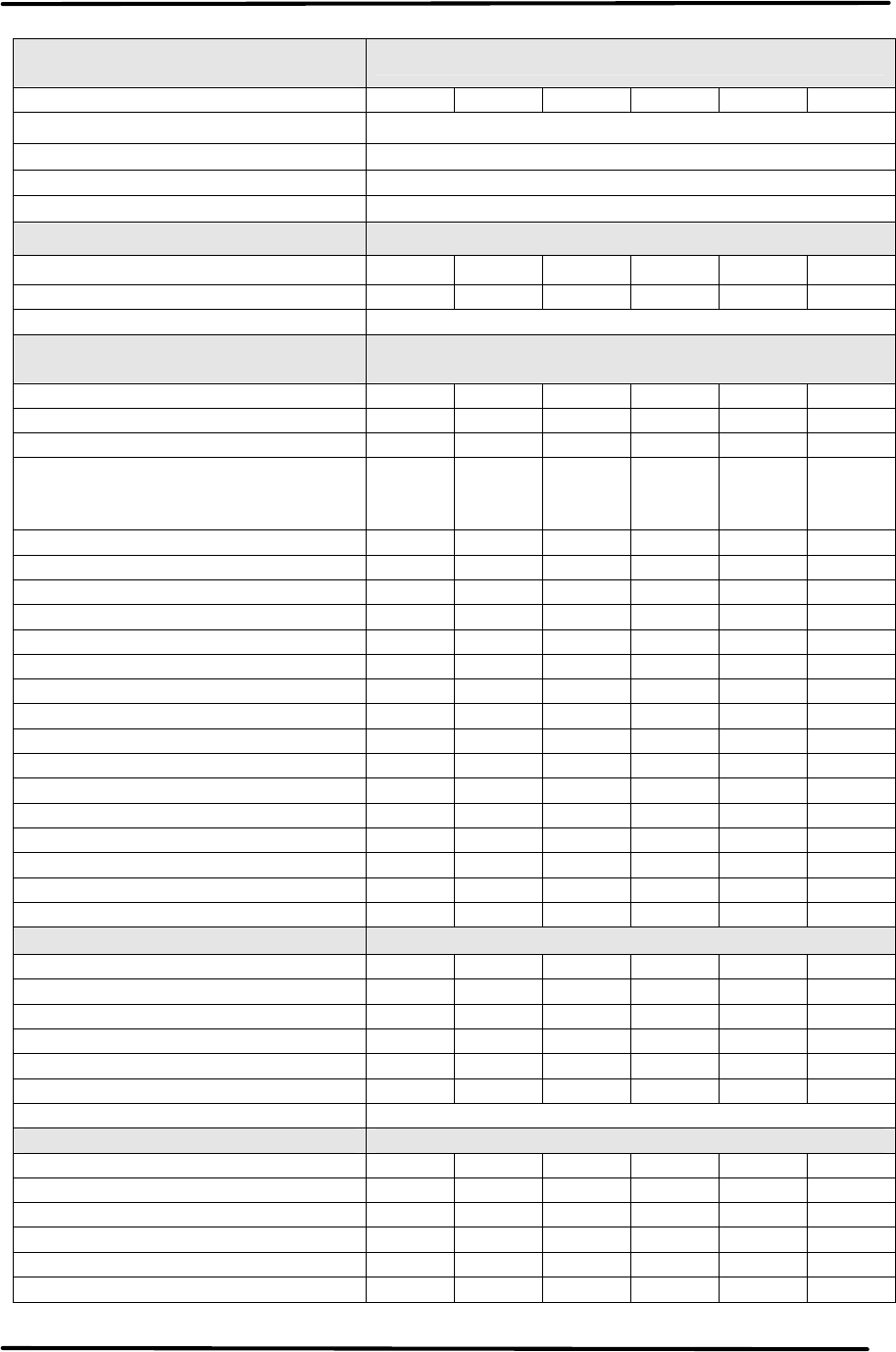
UHF LX Series Digital Transmitter Appendix C, Log Sheet
- Page 1 of 1 -
DESCRIPTION OF
PARAMETER TRANSMITTER READING FROM LCD DISPLAY
DATE READINGS TAKEN
Model Number
Code Version
Firmware Number
OUTPUT MEASUREMENTS
% FORWARD POWER
% REFLECTED POWER
DM8 DIGITAL MODULATOR
DETAILS
MODE
SOURCE
LINEAR EQ
NON-LINEAR EQ
(Settings Customized per
System)
EQL PEAK LEVEL
PSF PEAK LEVEL
AGC MODE
AGC LEVEL
D/A PEAK DETECT
TAP ENERGY
CLIP DETECTOR STATUS
AGG
ISL
D/A
HBF
IFC
COR
ODC
CODE VERSION
IF PROCESSOR DETAILS
INPUT SIGNAL STATE
MODULATION
INPUT IF
DLC CONTROL LOCK
ALC LEVEL
ALC MODE
UPCONVERTER DETAILS
AFC 1 LEVEL
AFC 2 LEVEL
PLL 1 CIRCUIT
PLL 2 CIRCUIT
AGC 1 LEVEL
AGC 2 LEVEL
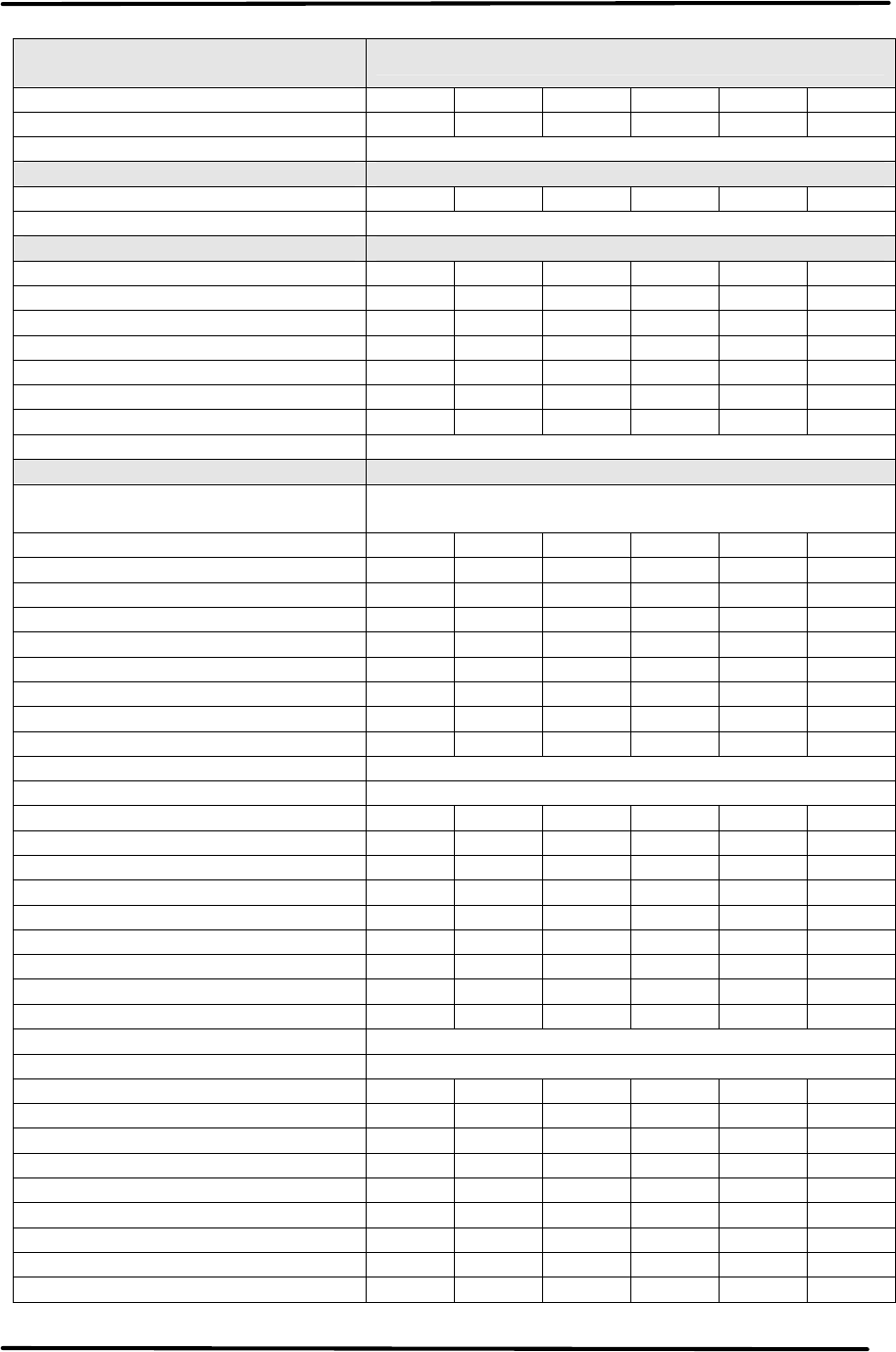
UHF LX Series Digital Transmitter Appendix C, Log Sheet
- Page 2 of 2 -
DESCRIPTION OF
PARAMETER TRANSMITTER READING FROM LCD DISPLAY
INT. 10 MHz
IF INPUT LEVEL
SYSTEM CONTROL DETAILS
Power Supply Enable For
DRIVER AND PA DETAILS
POWER SUPPLY STATE, 32V
FORWARD POWER
REFLECTED POWER
AMP 1 CURRENT
AMP 2 CURRENT
TEMPERATURE
CODE VERSION
EXT. PA AMPLIFIER MODULES ONLY IN HIGH POWER SYSTEMS
AMP SET 1 MODULE 1 Will indicate Amp Set and Module within the
Set. Will step through each Set and Module.
POWER SUPPLY VOLTAGE, 32V
32V SUPPLY
FORWARD POWER
REFLECTED POWER
AMP CURRENT 1
AMP CURRENT 2
AMP CURRENT 3
AMP TEMPERATURE
CODE VERSION
AMP SET 1 MODULE 2
POWER SUPPLY VOLTAGE, 32V
32V SUPPLY
FORWARD POWER
REFLECTED POWER
AMP CURRENT 1
AMP CURRENT 2
AMP CURRENT 3
AMP TEMPERATURE
CODE VERSION
AMP SET 1 MODULE 3
POWER SUPPLY VOLTAGE, 32V
32V SUPPLY
FORWARD POWER
REFLECTED POWER
AMP CURRENT 1
AMP CURRENT 2
AMP CURRENT 3
AMP TEMPERATURE
CODE VERSION
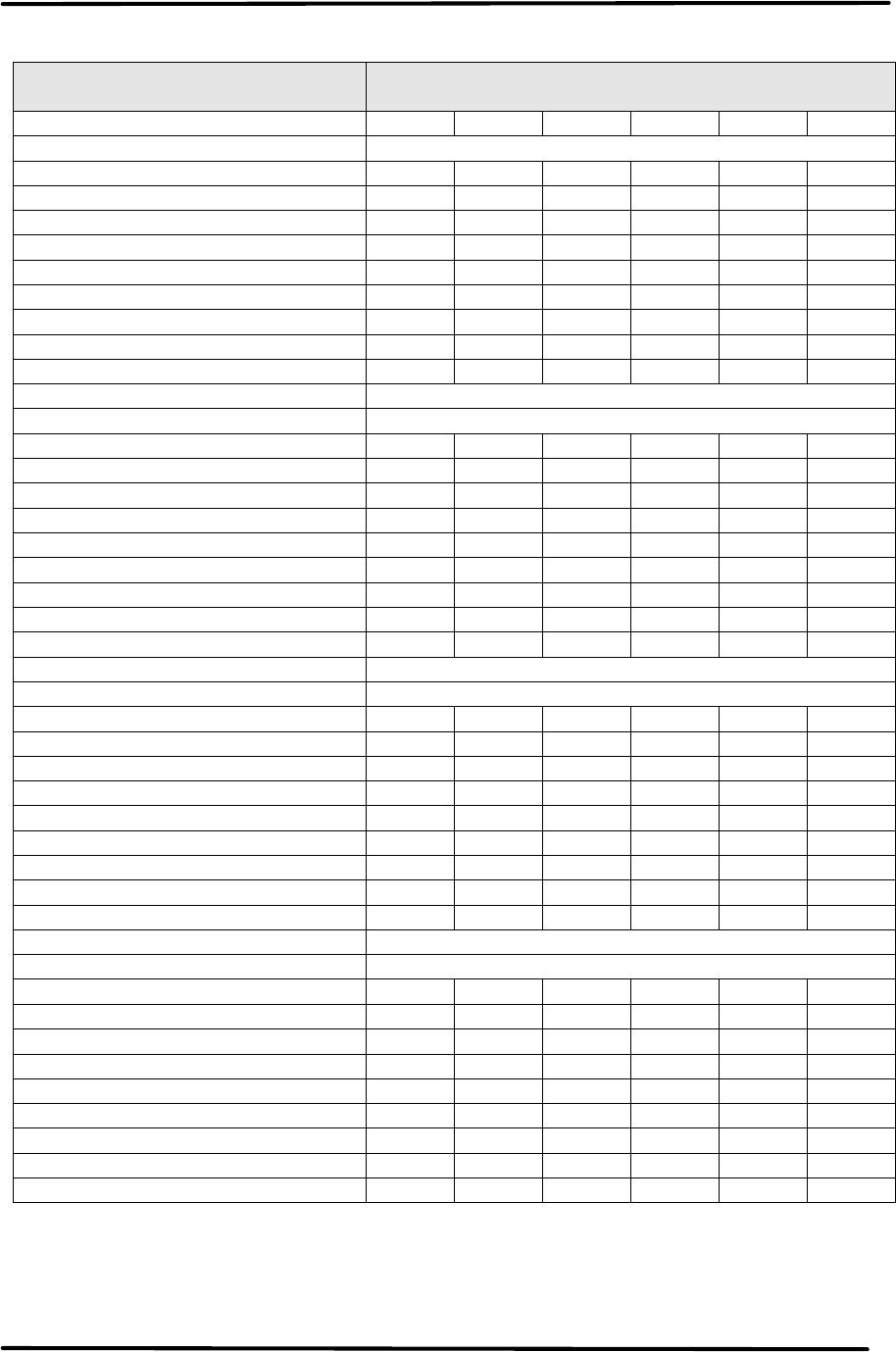
UHF LX Series Digital Transmitter Appendix C, Log Sheet
- Page 3 of 3 -
DESCRIPTION OF
PARAMETER TRANSMITTER READING FROM LCD DISPLAY
AMP SET 1 MODULE 4
POWER SUPPLY VOLTAGE, 32V
32V SUPPLY
FORWARD POWER
REFLECTED POWER
AMP CURRENT 1
AMP CURRENT 2
AMP CURRENT 3
AMP TEMPERATURE
CODE VERSION
AMP SET 2 MODULE 1
POWER SUPPLY VOLTAGE, 32V
32V SUPPLY
FORWARD POWER
REFLECTED POWER
AMP CURRENT 1
AMP CURRENT 2
AMP CURRENT 3
AMP TEMPERATURE
CODE VERSION
AMP SET 2 MODULE 2
POWER SUPPLY VOLTAGE, 32V
32V SUPPLY
FORWARD POWER
REFLECTED POWER
AMP CURRENT 1
AMP CURRENT 2
AMP CURRENT 3
AMP TEMPERATURE
CODE VERSION
AMP SET 2 MODULE 3
POWER SUPPLY VOLTAGE, 32V
32V SUPPLY
FORWARD POWER
REFLECTED POWER
AMP CURRENT 1
AMP CURRENT 2
AMP CURRENT 3
AMP TEMPERATURE
CODE VERSION
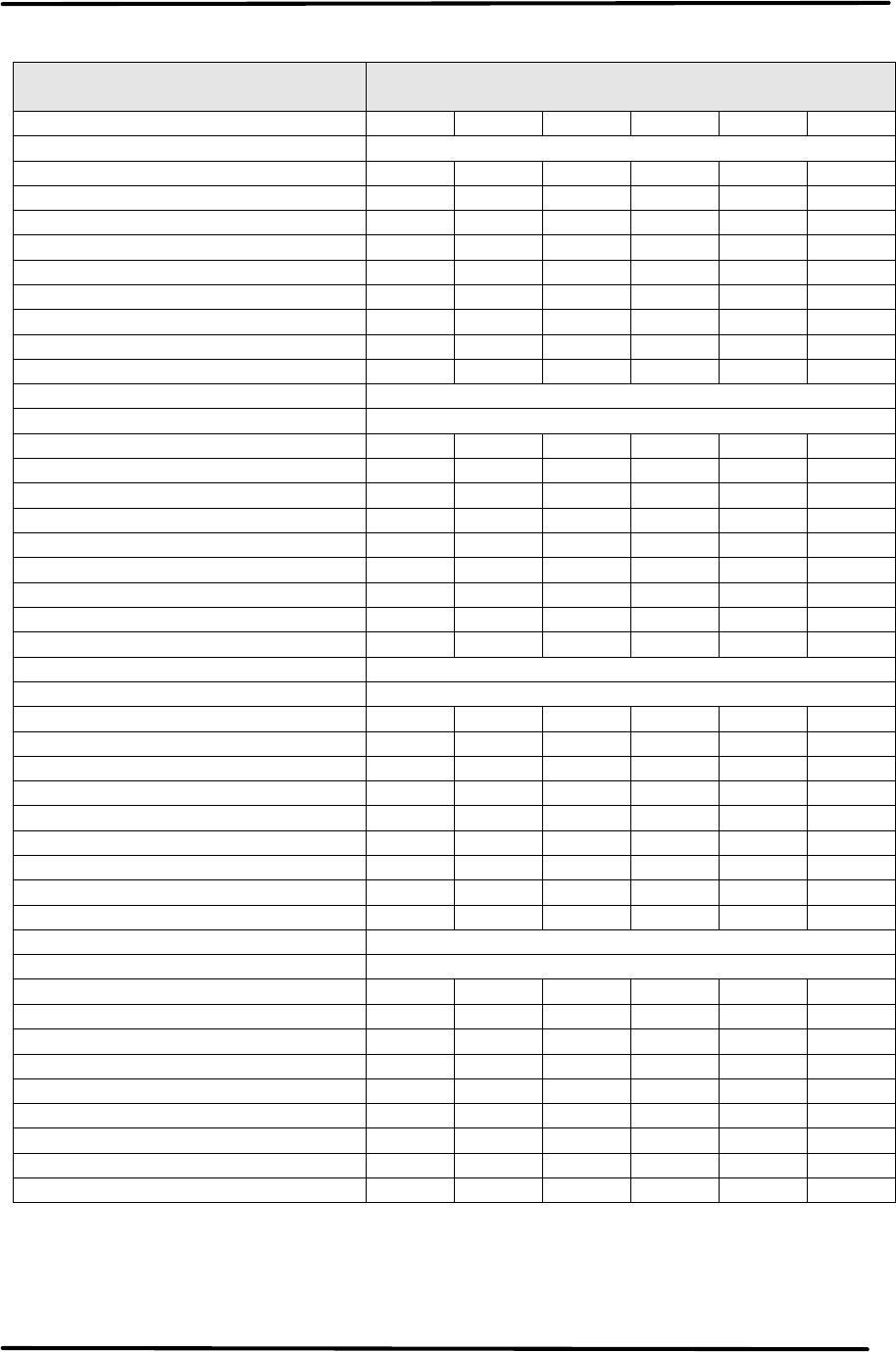
UHF LX Series Digital Transmitter Appendix C, Log Sheet
- Page 4 of 4 -
DESCRIPTION OF
PARAMETER TRANSMITTER READING FROM LCD DISPLAY
AMP SET 2 MODULE 4
POWER SUPPLY VOLTAGE, 32V
32V SUPPLY
FORWARD POWER
REFLECTED POWER
AMP CURRENT 1
AMP CURRENT 2
AMP CURRENT 3
AMP TEMPERATURE
CODE VERSION
AMP SET 3 MODULE 1
POWER SUPPLY VOLTAGE, 32V
32V SUPPLY
FORWARD POWER
REFLECTED POWER
AMP CURRENT 1
AMP CURRENT 2
AMP CURRENT 3
AMP TEMPERATURE
CODE VERSION
AMP SET 3 MODULE 2
POWER SUPPLY VOLTAGE, 32V
32V SUPPLY
FORWARD POWER
REFLECTED POWER
AMP CURRENT 1
AMP CURRENT 2
AMP CURRENT 3
AMP TEMPERATURE
CODE VERSION
AMP SET 3 MODULE 3
POWER SUPPLY VOLTAGE, 32V
32V SUPPLY
FORWARD POWER
REFLECTED POWER
AMP CURRENT 1
AMP CURRENT 2
AMP CURRENT 3
AMP TEMPERATURE
CODE VERSION
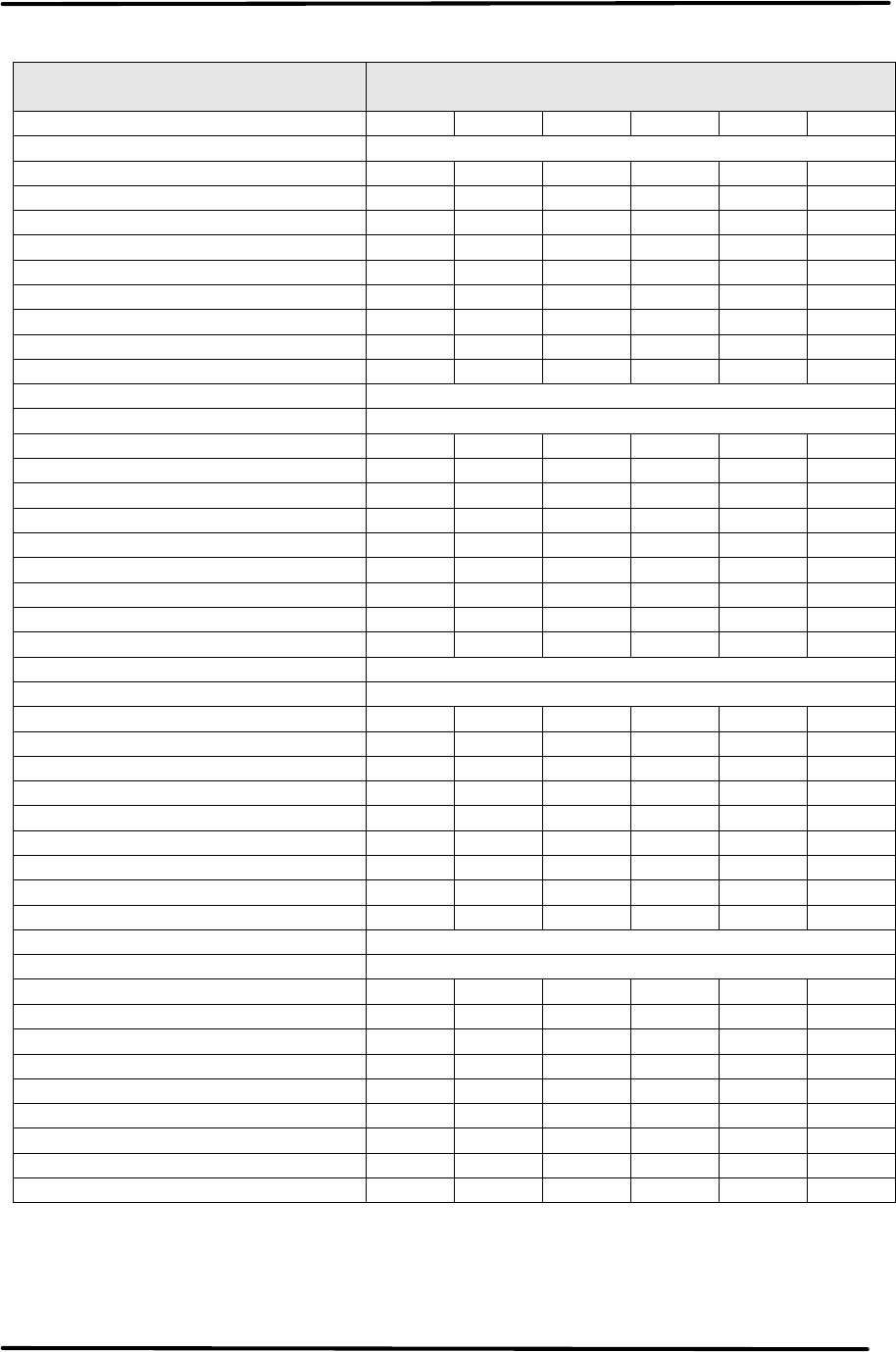
UHF LX Series Digital Transmitter Appendix C, Log Sheet
- Page 5 of 5 -
DESCRIPTION OF
PARAMETER TRANSMITTER READING FROM LCD DISPLAY
AMP SET 3 MODULE 4
POWER SUPPLY VOLTAGE, 32V
32V SUPPLY
FORWARD POWER
REFLECTED POWER
AMP CURRENT 1
AMP CURRENT 2
AMP CURRENT 3
AMP TEMPERATURE
CODE VERSION
AMP SET 4 MODULE 1
POWER SUPPLY VOLTAGE, 32V
32V SUPPLY
FORWARD POWER
REFLECTED POWER
AMP CURRENT 1
AMP CURRENT 2
AMP CURRENT 3
AMP TEMPERATURE
CODE VERSION
AMP SET 4 MODULE 2
POWER SUPPLY VOLTAGE, 32V
32V SUPPLY
FORWARD POWER
REFLECTED POWER
AMP CURRENT 1
AMP CURRENT 2
AMP CURRENT 3
AMP TEMPERATURE
CODE VERSION
AMP SET 4 MODULE 3
POWER SUPPLY VOLTAGE, 32V
32V SUPPLY
FORWARD POWER
REFLECTED POWER
AMP CURRENT 1
AMP CURRENT 2
AMP CURRENT 3
AMP TEMPERATURE
CODE VERSION
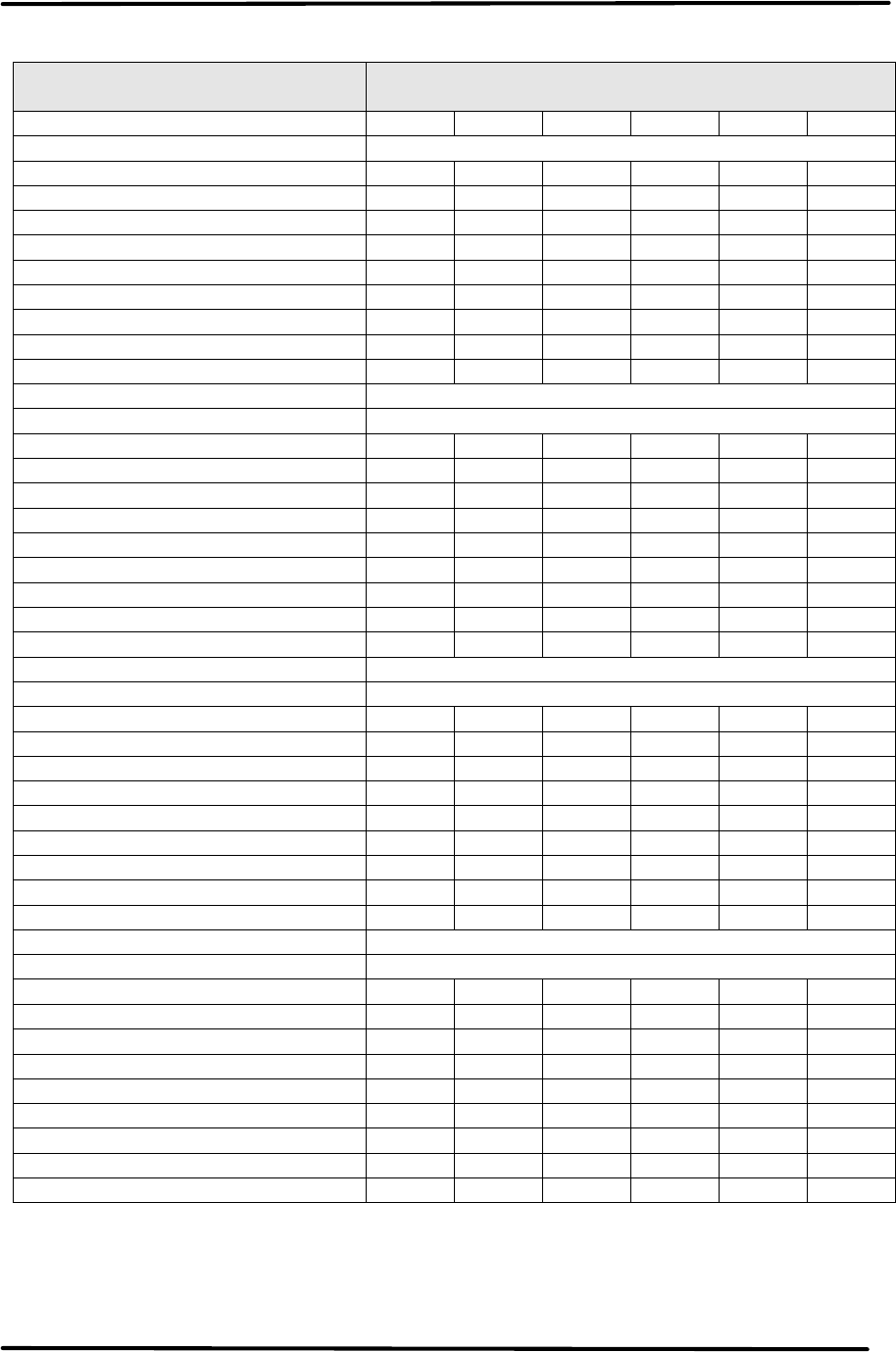
UHF LX Series Digital Transmitter Appendix C, Log Sheet
- Page 6 of 6 -
DESCRIPTION OF
PARAMETER TRANSMITTER READING FROM LCD DISPLAY
AMP SET 4 MODULE 4
POWER SUPPLY VOLTAGE, 32V
32V SUPPLY
FORWARD POWER
REFLECTED POWER
AMP CURRENT 1
AMP CURRENT 2
AMP CURRENT 3
AMP TEMPERATURE
CODE VERSION
AMP SET 5 MODULE 1
POWER SUPPLY VOLTAGE, 32V
32V SUPPLY
FORWARD POWER
REFLECTED POWER
AMP CURRENT 1
AMP CURRENT 2
AMP CURRENT 3
AMP TEMPERATURE
CODE VERSION
AMP SET 5 MODULE 2
POWER SUPPLY VOLTAGE, 32V
32V SUPPLY
FORWARD POWER
REFLECTED POWER
AMP CURRENT 1
AMP CURRENT 2
AMP CURRENT 3
AMP TEMPERATURE
CODE VERSION
AMP SET 5 MODULE 3
POWER SUPPLY VOLTAGE, 32V
32V SUPPLY
FORWARD POWER
REFLECTED POWER
AMP CURRENT 1
AMP CURRENT 2
AMP CURRENT 3
AMP TEMPERATURE
CODE VERSION
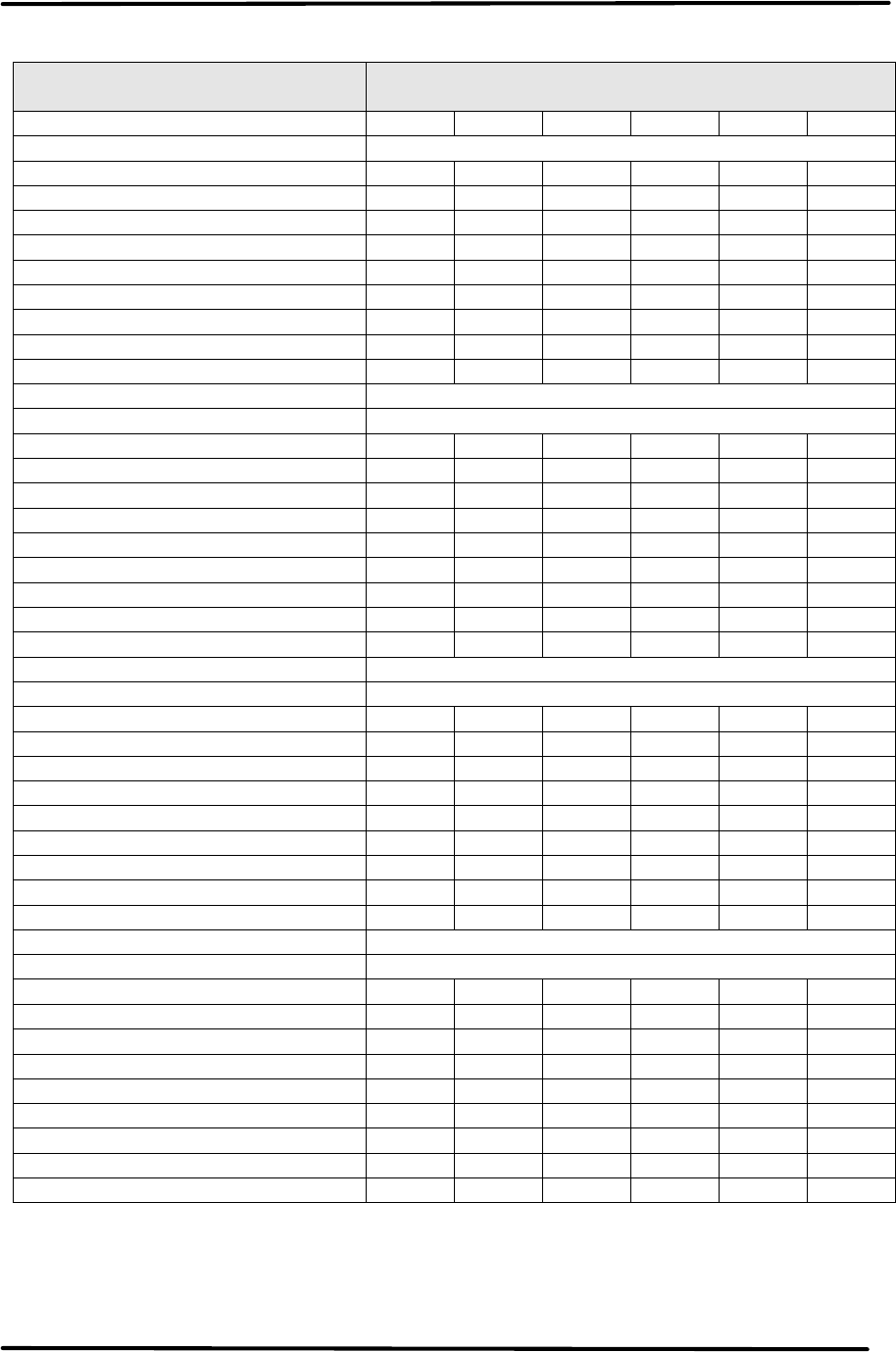
UHF LX Series Digital Transmitter Appendix C, Log Sheet
- Page 7 of 7 -
DESCRIPTION OF
PARAMETER TRANSMITTER READING FROM LCD DISPLAY
AMP SET 5 MODULE 4
POWER SUPPLY VOLTAGE, 32V
32V SUPPLY
FORWARD POWER
REFLECTED POWER
AMP CURRENT 1
AMP CURRENT 2
AMP CURRENT 3
AMP TEMPERATURE
CODE VERSION
AMP SET 6 MODULE 1
POWER SUPPLY VOLTAGE, 32V
32V SUPPLY
FORWARD POWER
REFLECTED POWER
AMP CURRENT 1
AMP CURRENT 2
AMP CURRENT 3
AMP TEMPERATURE
CODE VERSION
AMP SET 6 MODULE 2
POWER SUPPLY VOLTAGE, 32V
32V SUPPLY
FORWARD POWER
REFLECTED POWER
AMP CURRENT 1
AMP CURRENT 2
AMP CURRENT 3
AMP TEMPERATURE
CODE VERSION
AMP SET 6 MODULE 3
POWER SUPPLY VOLTAGE, 32V
32V SUPPLY
FORWARD POWER
REFLECTED POWER
AMP CURRENT 1
AMP CURRENT 2
AMP CURRENT 3
AMP TEMPERATURE
CODE VERSION
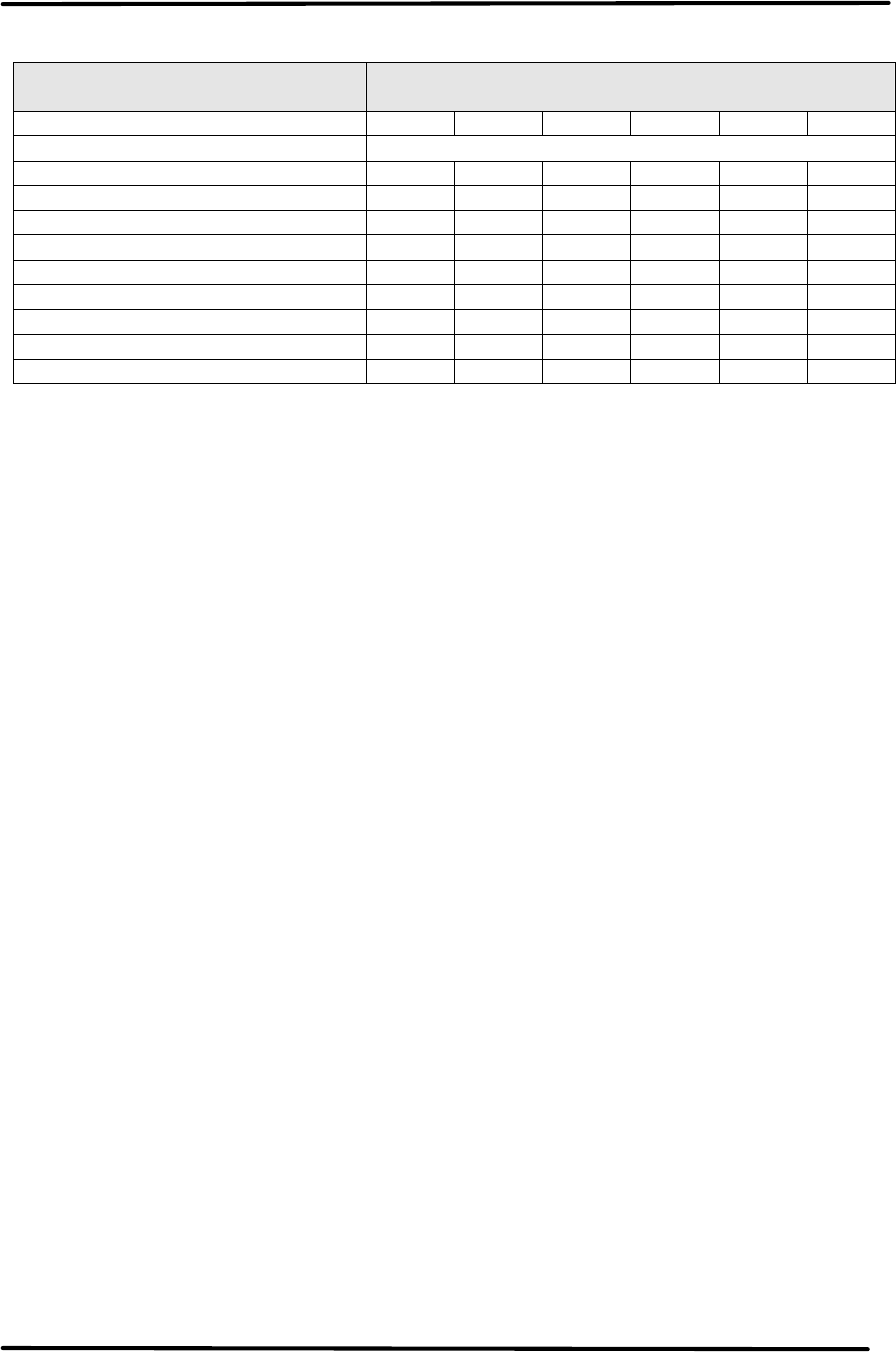
UHF LX Series Digital Transmitter Appendix C, Log Sheet
- Page 8 of 8 -
DESCRIPTION OF
PARAMETER TRANSMITTER READING FROM LCD DISPLAY
AMP SET 6 MODULE 4
POWER SUPPLY VOLTAGE, 32V
32V SUPPLY
FORWARD POWER
REFLECTED POWER
AMP CURRENT 1
AMP CURRENT 2
AMP CURRENT 3
AMP TEMPERATURE
CODE VERSION
NOTE: The previous Log Sheet readings can be taken from the System Details
Screen, Menu 30-1, on the 4 x 20 Display located on the front of the Control &
Monitoring/Power Supply Module.